iWaylink IM0002 Frey User Manual IT7000N user Menu
Bitatek Co., Ltd. Frey IT7000N user Menu
iWaylink >
Contents
- 1. Users Manual
- 2. User manual
- 3. User Manual
Users Manual
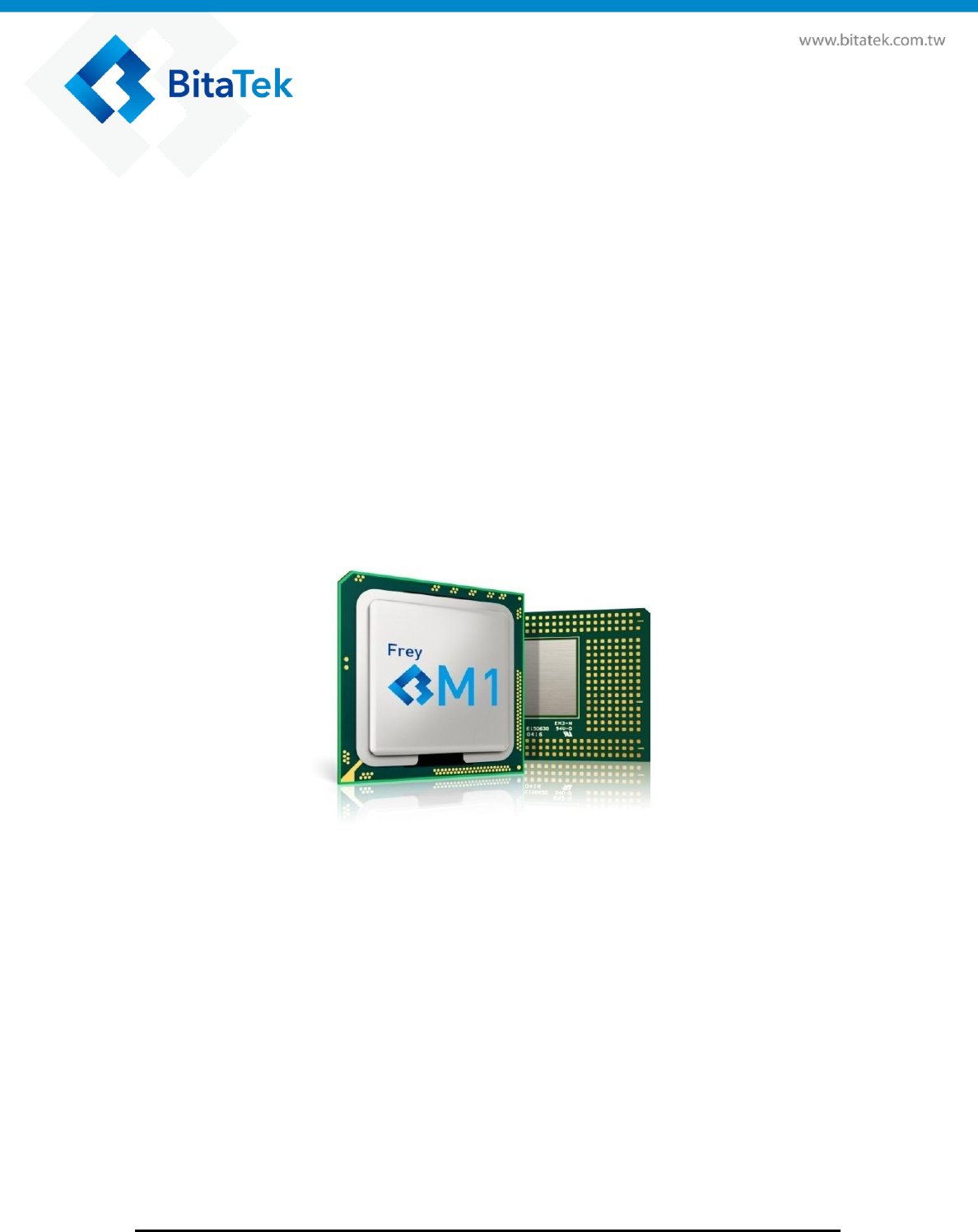
Page 1
BitaTek Co., Ltd. Copyright protected. All rights reserved.
NO. 115 Wugong 3rd Rd., Tel +886 2 2298 8588
Wugu Dist., New Taipei City 248, Taiwan (R.O.C.) Fax+886 2 2290 0029
Frey M1 Module
18 July 2016
Version 2.0

Page 2
BitaTek Co., Ltd. Copyright protected. All rights reserved.
NO. 115 Wugong 3rd Rd., Tel +886 2 2298 8588
Wugu Dist., New Taipei City 248, Taiwan (R.O.C.) Fax+886 2 2290 0029
Contents
Charpt 1. Revision History ..................................................................... 4
Charpt 2. Introduction ............................................................................ 5
Charpt 3. Product Concept .................................................................... 6
3.1. Main Feature .......................................................................... 6
3.1.1. Chipset on module ................................................................. 6
3.1.2. Memory .................................................................................. 6
3.1.3. Multimedia ............................................................................. 6
3.1.4. Audio (PM8952 codec ) ......................................................... 7
3.1.5. Expansion Slot Interface ........................................................ 7
3.1.6. USB ....................................................................................... 7
3.1.7. Keypad................................................................................... 7
3.1.8. Dimension .............................................................................. 7
3.1.9. Operation temperature ........................................................... 7
3.2. Module Block Diagram ........................................................... 8
3.3. Pin Definition .......................................................................... 8
3.4. Pad assignments (Top view) ................................................ 27
3.5. Electrical Specification ......................................................... 28
3.5.1. Input power specification ..................................................... 28
3.5.2. Output power specification ................................................... 29
3.5.3. Current consumption ........................................................... 32
3.5.4. Digital logic characteristics ................................................... 32
3.5.5. Coin-cell charging ................................................................ 34
3.5.6. Audio ................................................................................... 34
3.5.7. Vibrator ................................................................................ 37
3.5.8. Display ± bias ...................................................................... 37
3.5.9. Flash drivers (including torch mode) .................................... 38
3.5.10. Display backlight (WLEDs) .................................................. 39
3.5.11. System clock (BB_CLK)....................................................... 40
3.5.12. RF Transmit and Receiver Specifications ............................ 40
3.5.13. Electrostatic Discharge ........................................................ 42
Charpt 4. Module Mounting Issues ...................................................... 44
4.1. Solder Paste ........................................................................ 44
4.2. Stencil Printing ..................................................................... 44

Page 3
BitaTek Co., Ltd. Copyright protected. All rights reserved.
NO. 115 Wugong 3rd Rd., Tel +886 2 2298 8588
Wugu Dist., New Taipei City 248, Taiwan (R.O.C.) Fax+886 2 2290 0029
4.2.1. General Stencil Considerations ........................................... 44
4.2.2. Used Parameters and Recommendations ........................... 45
4.2.3. Pick and Place ..................................................................... 45
4.2.4. Reflow Profile ....................................................................... 45
4.3. Soldering Conditions and Temperature ............................... 47
4.3.1. Reflow Profile ....................................................................... 47
4.3.2. Maximum Temperature and Duration .................................. 48
4.4. Soldering Process Evaluation .............................................. 48
4.4.1. Visual Inspection .................................................................. 48
4.4.2. X-Ray Inspection and Void Content ..................................... 48
4.5. Board Level Reliability Investigation .................................... 49
4.6. Desoldering Process ............................................................ 50
4.6.1. Preparation of LGA Module ................................................. 51
4.6.2. Baking of Application Board ................................................. 51
4.6.3. Removal of LGA Module ...................................................... 51
Charpt 5. Packaging ............................................................................ 52
5.1. Mechanical Dimensions of Frey M1 ..................................... 52
5.2. Shipping Materials ............................................................... 54
5.2.1. Moisture Barrier Bag ............................................................ 56
5.3. Packing Label ...................................................................... 58
5.4. Storage Conditions .............................................................. 62
5.5. Moisture Sensitivity Level .................................................... 63
5.6. Durability and Mechanical Handling ..................................... 63
5.6.1. Storage Life ......................................................................... 63
5.6.2. Processing Life .................................................................... 63
5.6.3. Electrostatic Discharge ........................................................ 63
Charpt 6. Regulatory and Type Approval Information.......................... 64
6.1. Safety Precautions ............................................................... 66
6.2. Safety .................................................................................. 68
Charpt 7. Appendix .............................................................................. 70
7.1. Abbreviations ....................................................................... 70
7.2. Mounting Advice Sheet ........................................................ 70
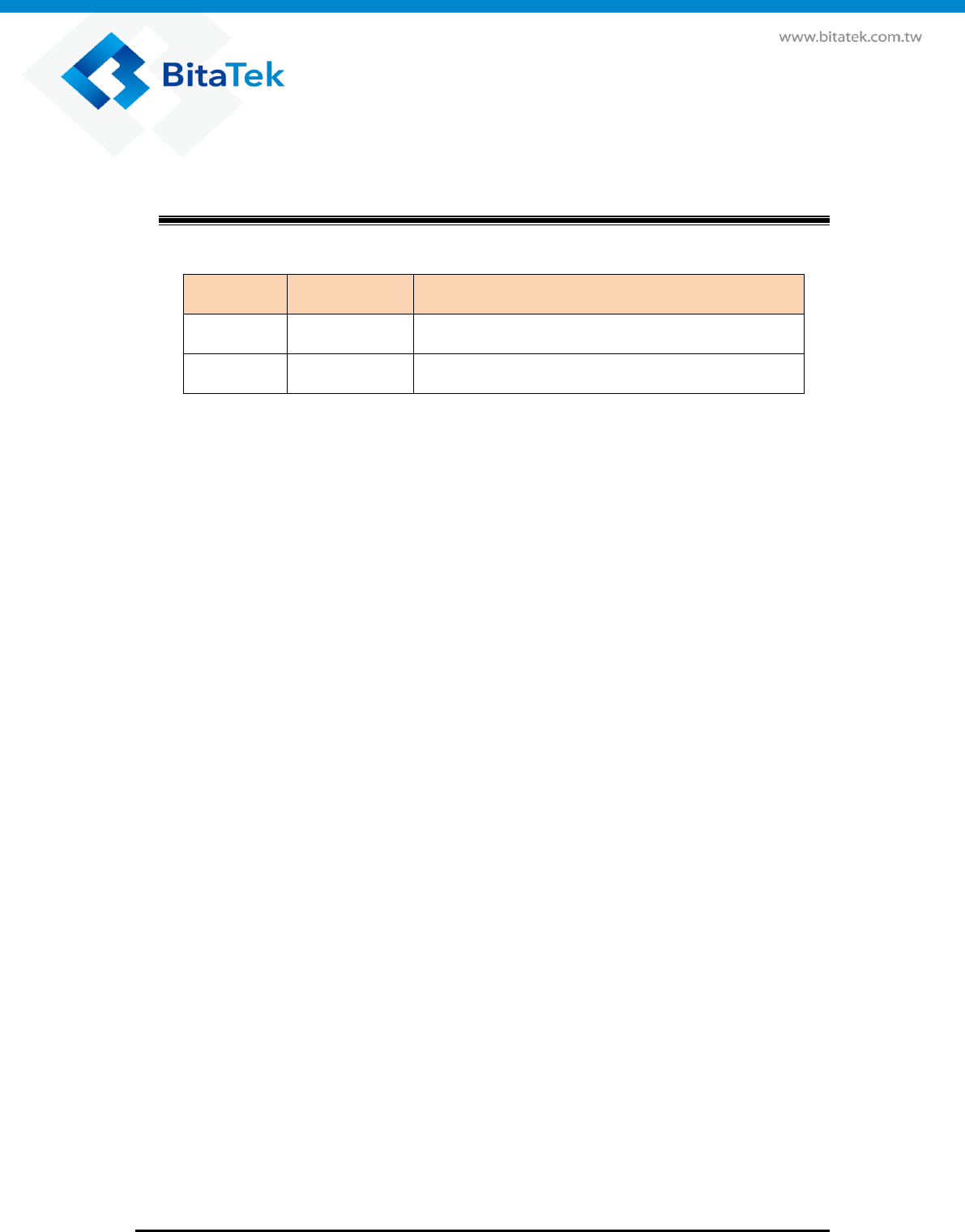
Page 4
BitaTek Co., Ltd. Copyright protected. All rights reserved.
NO. 115 Wugong 3rd Rd., Tel +886 2 2298 8588
Wugu Dist., New Taipei City 248, Taiwan (R.O.C.) Fax+886 2 2290 0029
Charpt 1. Revision History
Changes to the original manual are listed below:
Version
Date
Description
1.00
2016/06/21
Initial release
2.00
2016/7/18
Update FCC statement

Page 5
BitaTek Co., Ltd. Copyright protected. All rights reserved.
NO. 115 Wugong 3rd Rd., Tel +886 2 2298 8588
Wugu Dist., New Taipei City 248, Taiwan (R.O.C.) Fax+886 2 2290 0029
Charpt 2. Introduction
This document defines the specification for FREY M1. FREY M1 is a smart module for
handheld device and builds in Bluetooth, WiFi and GPS function. It also can support SD
card, LCM , Touch Screen , Audio , dual camera , Flash LED , Accelerometer /
Magnetometer / Gyroscope / Proximity & Light Sensor functions through application design
board.
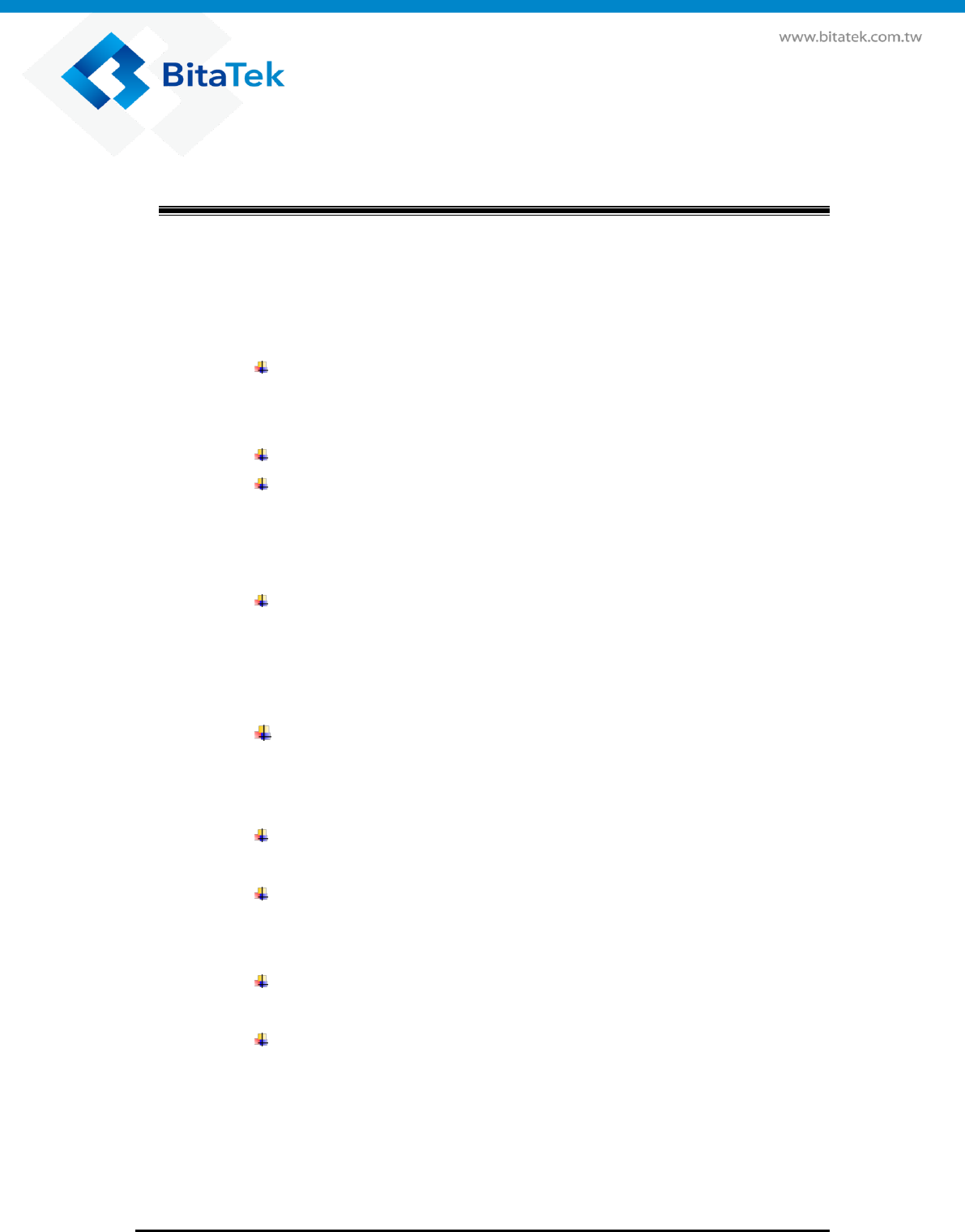
Page 6
BitaTek Co., Ltd. Copyright protected. All rights reserved.
NO. 115 Wugong 3rd Rd., Tel +886 2 2298 8588
Wugu Dist., New Taipei City 248, Taiwan (R.O.C.) Fax+886 2 2290 0029
Charpt 3. Product Concept
3.1. Main Feature
3.1.1. Chipset on module
Digital processor : APQ8052 (ARM Cortex-A53 octa cores)
Quad core at 1.516 GHz, 512 kB L2 cache
Quad core at 1.209 GHz, 512 kB L2 cache
Power management : PM8952 and PMI8952
WLAN/BT/FM : WCN3680B
WLAN IEEE 802.11a/b/g/n/ac dual bands
Bluetooth V2.1BER/EDR+3.0HS+4.1 LE
FM RDS & RBDS, RX only
GPS : WGR7640
GPS, Glonass , Galileo or Beidou
3.1.2. Memory
eMCP , 2GB LPDDR3 RAM plus 16GB eMMC Flash ROM
3.1.3. Multimedia
Display interface:
Support one 4-lane MIPI DSI port , FHD (1920 × 1200) 60 fps
Camera interface:
Support 4-lane + 4-lane or 4-lane + 2-lane + 1-lane MIPI CSI port
Two Flash LED interface
Graphics:
Qualcomm® Adreno™ 405
Touch screen:
Capacitive panels via external IC by I2C
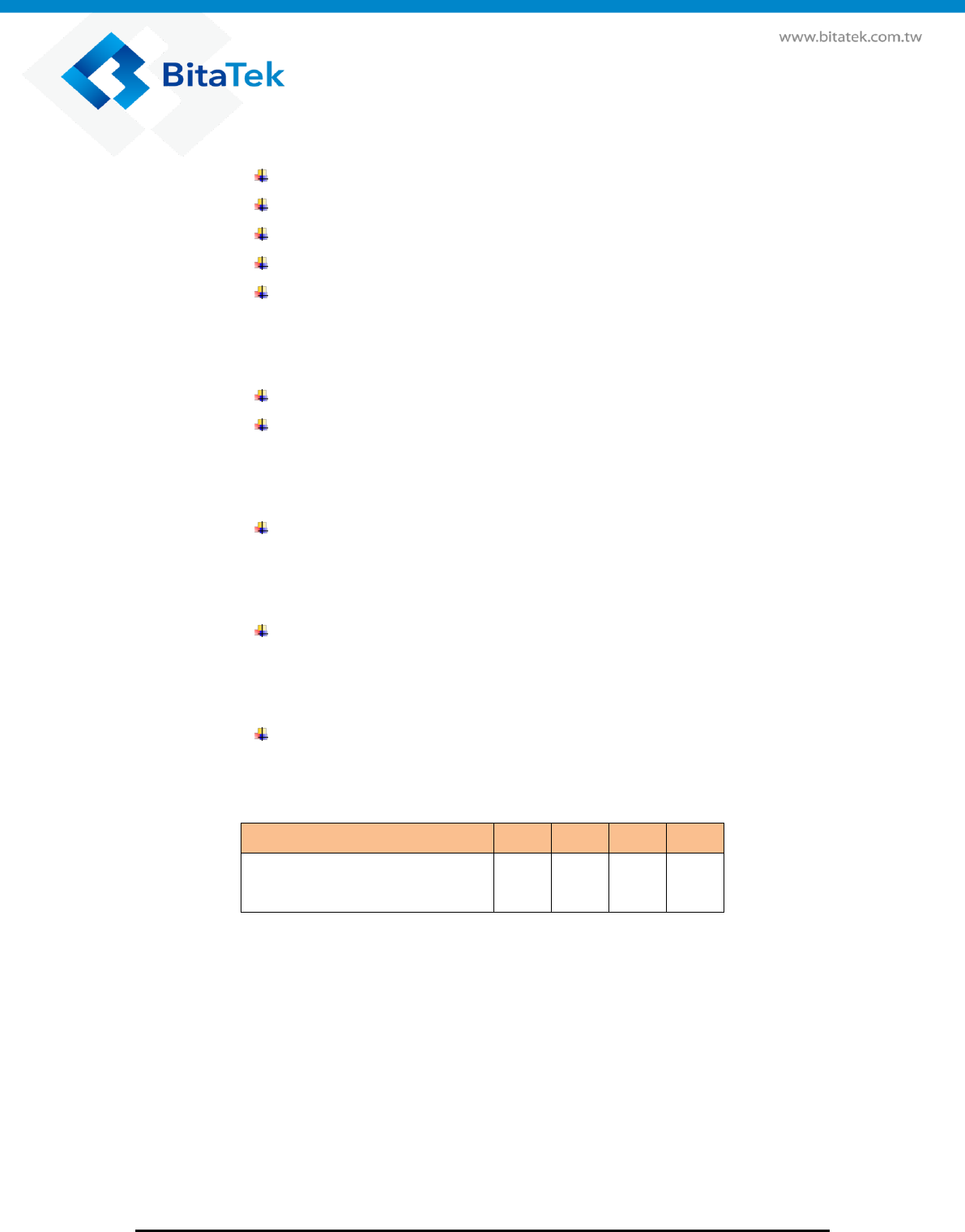
Page 7
BitaTek Co., Ltd. Copyright protected. All rights reserved.
NO. 115 Wugong 3rd Rd., Tel +886 2 2298 8588
Wugu Dist., New Taipei City 248, Taiwan (R.O.C.) Fax+886 2 2290 0029
3.1.4. Audio (PM8952 codec )
Support two Microphones interface with noise cancellation
Support one speaker interface
Support one receiver interface
Support one audio jack interface
Support one vibrator control interface
3.1.5. Expansion Slot Interface
One micro SD Memory slot interface with SDHC
UIM interface x1
3.1.6. USB
Support one USB OTG
3.1.7. Keypad
Support 5x5 Key matrix
3.1.8. Dimension
44 x 33.6 x 2.7 mm
3.1.9. Operation temperature
Item
Min.
Typ.
Max.
Unit
Normal temperature range
Extreme temperature range
+15
-30
+25
+55
+70
°C
°C
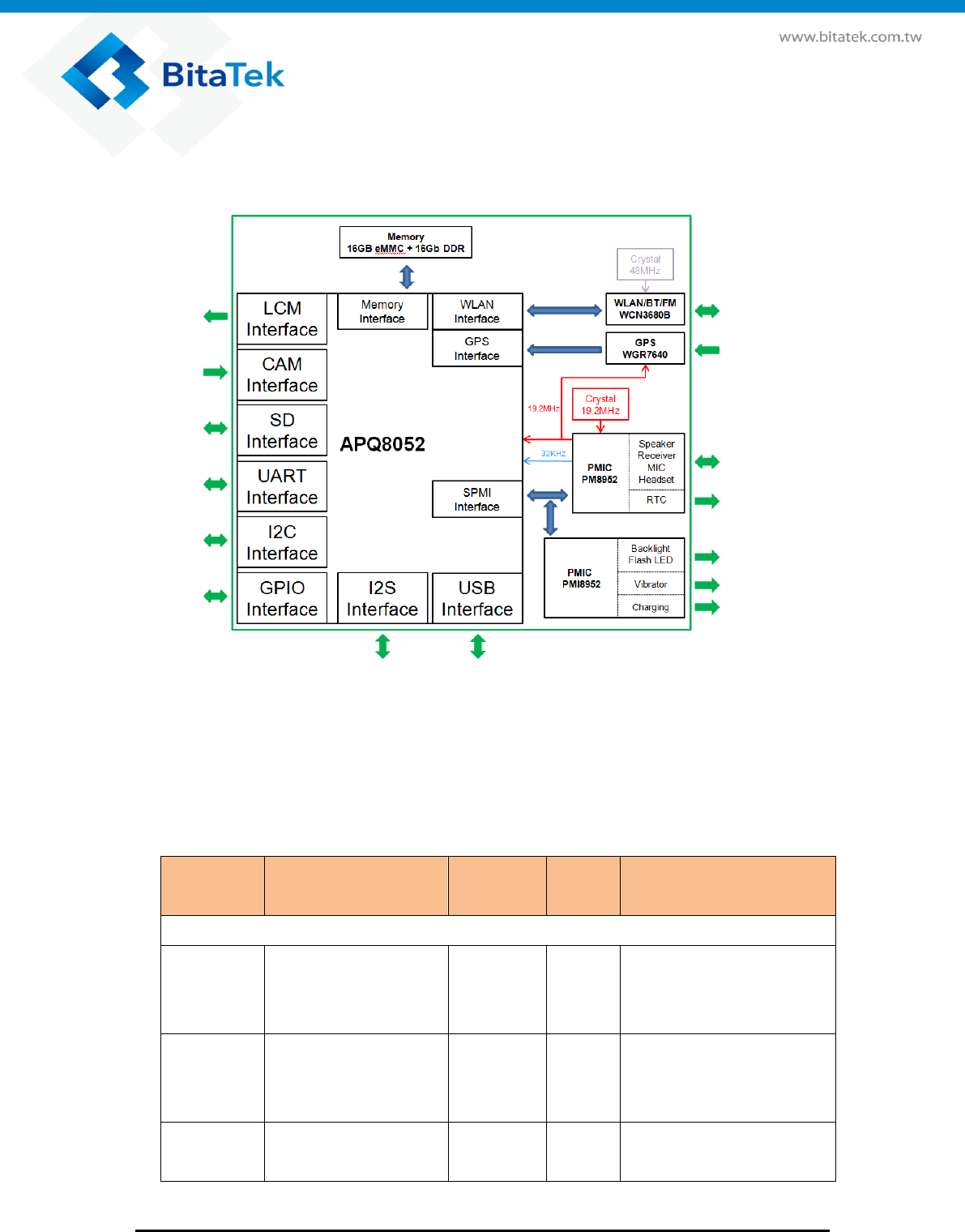
Page 8
BitaTek Co., Ltd. Copyright protected. All rights reserved.
NO. 115 Wugong 3rd Rd., Tel +886 2 2298 8588
Wugu Dist., New Taipei City 248, Taiwan (R.O.C.) Fax+886 2 2290 0029
3.2. Module Block Diagram
3.3. Pin Definition
AI : Analog input ; AO : Analog output ;
DI : Digital input ; DO : Digital output
PI : Power input ; PO : Power output
Pin
Number
Pin Name
Wakeup
Pad
Type
Functional description
Power
W18
USB_VBUS_IN
PI, PO
Input power from selected
source, or output during
USB-OTG.
W19
USB_VBUS_IN
PI, PO
Input power from selected
source, or output during
USB-OTG.
X18
USB_VBUS_IN
PI, PO
Input power from selected
source, or output during

Page 9
BitaTek Co., Ltd. Copyright protected. All rights reserved.
NO. 115 Wugong 3rd Rd., Tel +886 2 2298 8588
Wugu Dist., New Taipei City 248, Taiwan (R.O.C.) Fax+886 2 2290 0029
USB-OTG.
X19
USB_VBUS_IN
PI, PO
Input power from selected
source, or output during
USB-OTG.
T18
VBATT
PI, PO
Battery power supply
T19
VBATT
PI, PO
Battery power supply
U18
VBATT
PI, PO
Battery power supply
U19
VBATT
PI, PO
Battery power supply
Z18
VPH_PWR
PI, PO
Primary system power
supply node
Z19
VPH_PWR
PI, PO
Primary system power
supply node
AA18
VPH_PWR
PI, PO
Primary system power
supply node
AA19
VPH_PWR
PI, PO
Primary system power
supply node
U16
VREG_L1
PO
LDO output
F16
VREG_L4
PO
LDO output
C15
VREG_L5
PO
LDO output
F12
VREG_L6
PO
LDO output
C19
VREG_L10
PO
LDO output
D17
VREG_L11
PO
LDO output
E13
VREG_L12
PO
LDO output
C18
VREG_L14
PO
LDO output
C16
VREG_L16
PO
LDO output
E16
VREG_L17
PO
LDO output
D19
VREG_L18
PO
LDO output
D18
VREG_L22
PO
LDO output
T17
VREG_L23
PO
LDO output
U17
PMI8952_VBIAS
PO
Dedicated voltage source
for battery-related resistor
networks, not use for other
purpose.
X20
SYSON
PO
LDO output that supplies
SCHG FET drivers
RTC Battery

Page 10
BitaTek Co., Ltd. Copyright protected. All rights reserved.
NO. 115 Wugong 3rd Rd., Tel +886 2 2298 8588
Wugu Dist., New Taipei City 248, Taiwan (R.O.C.) Fax+886 2 2290 0029
P20
VCOIN
PI, PO
For RTC battery.
Clock
F17
PM8952_BB_CLK2
DO
Buffered baseband
(low-power) XO clock 2
System
W17
KYPD_PWR_N
DI
Internal pull-up to dVdd;
keep C load < 10 pF. Dual
function:
1. Keypad power on;
initiates power on when
grounded
2. Can be configured as
stage 2 or stage 3 reset if
held LOW longer
X15
RESIN_N
DI
PMIC reset input ; initiates
stage 2 or stage 3 reset if
held LOW
W20
PMI8952_CHG_EN
DI
Charger enable
V20
CHG_VBAT_SNS
AI
Sensed battery voltage for
charger circuits
T20
BATT_ID
AI
Battery ID input to ADC;
also detects missing
battery
Y16
CS_MINUS
AI
Current sense resistor —
minus side (low side)
V15
CS_PLUS
AI
Current sense resistor —
plus side (high side)
V16
BATT_MINUS
AI
Battery minus (-) terminal
sense input
U15
BATT_PLUS
AI
Battery plus (+) terminal
sense input
X17
BATT_THERM
AI
Battery temperature input
to ADC (measures pack
temperature) , default NTC
is 47KΩ±1% in EVB
battery .

Page 11
BitaTek Co., Ltd. Copyright protected. All rights reserved.
NO. 115 Wugong 3rd Rd., Tel +886 2 2298 8588
Wugu Dist., New Taipei City 248, Taiwan (R.O.C.) Fax+886 2 2290 0029
V17
PA_THERM
AI
AMUX input – PA
thermistor divider
V19
PMI8952_USB_EN
DO
Enable USB path from
external power multiplexer
Y18
PMI8952_USB_SNS
AI
USB input voltage sense
pin from external power
multiplexer
V18
PMI8952_DC_EN
DO
Enable 2nd power path
from external power
multiplexer
Y19
PMI8952_DC_SNS
AI
2nd power voltage sense to
determine in or out of valid
range
Z16
NC
NC
Keep it floating and doesn't
connect to GND.
Audio
H18
MIC_BIAS1
AO
Microphone bias #1
I18
MIC_BIAS2
AO
Microphone bias #2
H19
MIC1_IN_M
AI
Microphone input 1, minus
H20
MIC1_IN_P
AI
Microphone input 1, plus
M19
MIC2_IN
AI
Microphone input 2
L18
MIC3_IN
AI
Microphone input 3
K18
GND_CFILT
GND
Microphone bias filter
ground
J19
HPH_L
AO
Headphone output, left
channel
J20
HPH_R
AO
Headphone output, right
channel
K20
HPH_REF
AI
Headphone ground
reference
N18
HS_DET
AI
Headset detection
L20
EARO_M
AO
Earpiece output, minus (-)
L19
EARO_P
AO
Earpiece output, plus (+)
N20
SPKR_DRV_M
AO
Class-D speaker driver
output, minus (-)
N19
SPKR_DRV_P
AO
Class-D speaker driver

Page 12
BitaTek Co., Ltd. Copyright protected. All rights reserved.
NO. 115 Wugong 3rd Rd., Tel +886 2 2298 8588
Wugu Dist., New Taipei City 248, Taiwan (R.O.C.) Fax+886 2 2290 0029
output, plus (+)
Vibrator
Y15
HAP_OUT_N
AO
Vibrator driver output
negative
Y14
HAP_OUT_P
AO
Vibrator driver output
positive
SD
V1
SDC2_CLK
DO
Secure digital controller 2
clock
X2
SDC2_CMD
DI,DO
Secure digital controller 2
command
W1
SDC2_DATA_0
DI,DO
Secure digital controller 2
data bit 0
V2
SDC2_DATA_1
DI,DO
Secure digital controller 2
data bit 1
V3
SDC2_DATA_2
DI,DO
Secure digital controller 2
data bit 2
W2
SDC2_DATA_3
DI,DO
Secure digital controller 2
data bit 3
USB
Z15
PMI8952_USB_ID
AI, AO
Dual function:
1. OTG mode enable
(programmable polarity;
can also be controlled by
OTG enable bit)
2. OTG ID monitor to detect
the OTG ID resistor value.
H13
USB_HS_DM
DI,DO
USB HS data minus
H14
USB_HS_DP
DI,DO
USB HS data plus
R19
PMI_USB_DM
DI
USB data minus for power
source detection only;
modem IC handles data
transactions
R18
PMI_USB_DP
DI
USB data plus for power
source detection only;
modem IC handles data

Page 13
BitaTek Co., Ltd. Copyright protected. All rights reserved.
NO. 115 Wugong 3rd Rd., Tel +886 2 2298 8588
Wugu Dist., New Taipei City 248, Taiwan (R.O.C.) Fax+886 2 2290 0029
transactions
LED driver
X9
VREG_WLED_ANOD
E
PO
LCM WLED boost output
Y13
WLED_SINK1
AO
WLED low-side current sink
input, string 1
Z14
WLED_SINK2
AO
WLED low-side current sink
input, string 2
Y12
WLED_SINK3
AO
WLED low-side current sink
input, string 3
Z12
WLED_SINK4
AO
WLED low-side current sink
input, string 4
W14
WLED_CABC
DI
Content adaptive backlight
control (CABC); PWM
signal from display
controller for dynamic
dimming of LCD
X16
FLASH_LED1
AO
High-side current source
for flash/torch LED1 anode
Z17
FLASH_LED2
AO
High-side current source
for flash/torch LED2 anode
Y17
CHARGE_LED_RED
AO
Current sink for charging
indication
Display
V14
VREG_DISP_N5V
PO
Regulated output for the
display’s negative bias
V13
VREG_DISP_P5V
PO
Regulated output for the
display’s positive bias
U14
NC
NC
Keep it floating and doesn't
connect to GND.
K2
MIPI_DSI_CLK_N
DO
MIPI DSI clock negative
K3
MIPI_DSI_CLK_P
DO
MIPI DSI clock positive
J2
MIPI_DSI_LN0_N
DO
MIPI DSI data0 negative
J3
MIPI_DSI_LN0_P
DO
MIPI DSI data0 positive
I2
MIPI_DSI_LN1_N
DO
MIPI DSI data1 negative
I1
MIPI_DSI_LN1_P
DO
MIPI DSI data1 positive
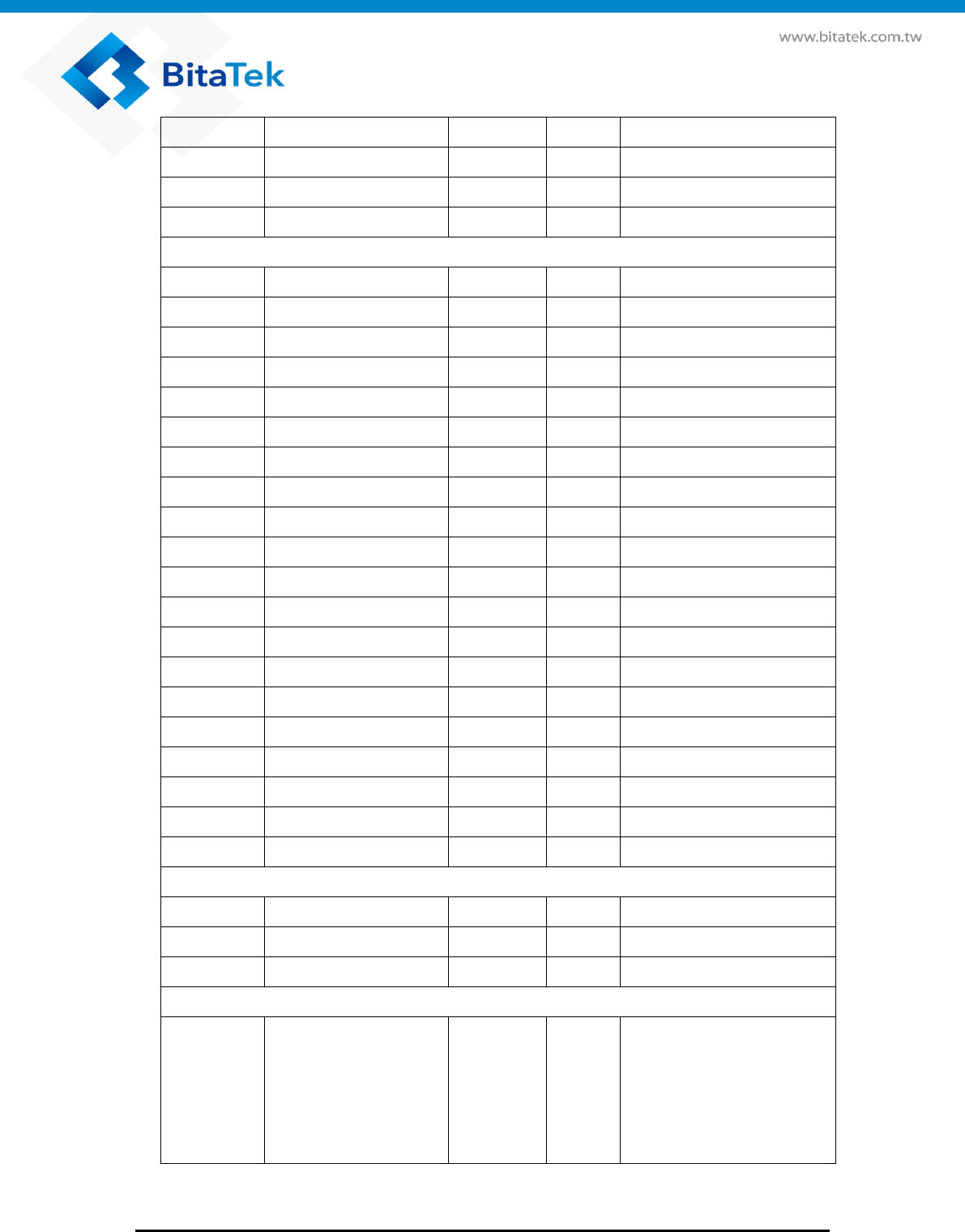
Page 14
BitaTek Co., Ltd. Copyright protected. All rights reserved.
NO. 115 Wugong 3rd Rd., Tel +886 2 2298 8588
Wugu Dist., New Taipei City 248, Taiwan (R.O.C.) Fax+886 2 2290 0029
K1
MIPI_DSI_LN2_N
DO
MIPI DSI data2 negative
J1
MIPI_DSI_LN2_P
DO
MIPI DSI data2 positive
L2
MIPI_DSI_LN3_N
DO
MIPI DSI data3 negative
L3
MIPI_DSI_LN3_P
DO
MIPI DSI data3 positive
CAMERA
P3
MIPI_CSI0_CLK_N
DI
MIPI CSI clock negative
P2
MIPI_CSI0_CLK_P
DI
MIPI CSI0 clock positive
Q2
MIPI_CSI0_LN0_N
DI
MIPI CSI0 data0 negative
Q3
MIPI_CSI0_LN0_P
DI
MIPI CSI0 data0 positive
R2
MIPI_CSI0_LN2_N
DI
MIPI CSI0 data1 negative
S2
MIPI_CSI0_LN2_P
DI
MIPI CSI0 data1 positive
S1
MIPI_CSI0_LN3_N
DI
MIPI CSI0 data2 negative
R1
MIPI_CSI0_LN3_P
DI
MIPI CSI0 data2 positive
Q1
MIPI_CSI0_LN4_N
DI
MIPI CSI0 data3 negative
P1
MIPI_CSI0_LN4_P
DI
MIPI CSI0 data3 positive
N3
MIPI_CSI1_CLK_N
DI
MIPI CSI1 clock negative
N2
MIPI_CSI1_CLK_P
DI
MIPI CSI1 clock positive
O3
MIPI_CSI1_LN0_N
DI
MIPI CSI1 data0 negative
O2
MIPI_CSI1_LN0_P
DI
MIPI CSI1 data0 positive
N1
MIPI_CSI1_LN2_N
DI
MIPI CSI1 data1 negative
O1
MIPI_CSI1_LN2_P
DI
MIPI CSI1 data1 positive
M3
MIPI_CSI1_LN3_N
DI
MIPI CSI1 data2 negative
M2
MIPI_CSI1_LN3_P
DI
MIPI CSI1 data2 positive
L1
MIPI_CSI1_LN4_N
DI
MIPI CSI1 data3 negative
M1
MIPI_CSI1_LN4_P
DI
MIPI CSI1 data3 positive
Antenna
A2
WLAN_BT_ANT
ANT
WLAN/BT antenna
A19
GPS_ANT
ANT
GPS antenna
A13
FM_ANT
ANT
FM RX antenna
MPP(Multi-Purpose Pin)
X14
PMI8952_MPP_1
MPP
1. Configurable as digital
I/Os
2. Analog multiplexer inputs
3. Even MPPs configurable
as current sinks; odd MPPs

Page 15
BitaTek Co., Ltd. Copyright protected. All rights reserved.
NO. 115 Wugong 3rd Rd., Tel +886 2 2298 8588
Wugu Dist., New Taipei City 248, Taiwan (R.O.C.) Fax+886 2 2290 0029
configurable as analog
outputs
X13
PMI8952_MPP_2
MPP
1. Configurable as digital
I/Os
2. Analog multiplexer inputs
3. Even MPPs configurable
as current sinks; odd MPPs
configurable as analog
outputs
W13
PMI8952_MPP_3
MPP
1. Configurable as digital
I/Os
2. Analog multiplexer inputs
3. Even MPPs configurable
as current sinks; odd MPPs
configurable as analog
outputs
G16
PM8952_MPP_02
MPP
1. Configurable as digital
I/Os
2. Level-translating
bidirectional I/Os
3. Analog multiplexer inputs
4. Even MPPs can be
current sinks and odd
MPPs can be VREF buffer
outputs
F15
PM8952_MPP_03
MPP
1. Configurable as digital
I/Os
2. Level-translating
bidirectional I/Os
3. Analog multiplexer inputs
4. Even MPPs can be
current sinks and odd
MPPs can be VREF buffer
outputs
G15
PM8952_MPP_04
MPP
1. Configurable as digital
I/Os

Page 16
BitaTek Co., Ltd. Copyright protected. All rights reserved.
NO. 115 Wugong 3rd Rd., Tel +886 2 2298 8588
Wugu Dist., New Taipei City 248, Taiwan (R.O.C.) Fax+886 2 2290 0029
2. Level-translating
bidirectional I/Os
3. Analog multiplexer inputs
4. Even MPPs can be
current sinks and odd
MPPs can be VREF buffer
outputs
GPIO
E2
GPIO_0
GPIO
1. Configurable I/O
2. BLSP1_SPI_MOSI
3. BLSP1_UART_TX
F2
GPIO_1
GPIO
1. Configurable I/O
2. BLSP3_SPI_CS_N
3. BLSP3_I2C_SDA
4. GP_CLK_2B
E3
GPIO_2
V
GPIO
1. Configurable I/O
2. BLSP8_SPI_MISO
F3
GPIO_3
GPIO
1. Configurable I/O
2. BLSP1_SPI_CLK
3. BLSP1_UART_RFR_N
4. BLSP1_I2C_SCL
U4
GPIO_4
GPIO
1. Configurable I/O
2. BLSP2_SPI_MOSI
3. BLSP2_UART_TX
T4
GPIO_5
V
GPIO
1. Configurable I/O
2. BLSP2_SPI_MISO
3. BLSP2_UART_RX
4. LDO_EN
X3
GPIO_6
GPIO
1. Configurable I/O
2. BLSP2_SPI_CS_N
3. BLSP2_UART_CTS_N
4. BLSP2_I2C_SDA
5. GP_CLK_1B
W3
GPIO_7
GPIO
1. Configurable I/O
2. BLSP2_SPI_CLK
3. BLSP2_UART_RFR_N

Page 17
BitaTek Co., Ltd. Copyright protected. All rights reserved.
NO. 115 Wugong 3rd Rd., Tel +886 2 2298 8588
Wugu Dist., New Taipei City 248, Taiwan (R.O.C.) Fax+886 2 2290 0029
4. BLSP2_I2C_SCL
5. GP_PDM_2A
I3
GPIO_8
GPIO
1. Configurable I/O
H2
GPIO_9
GPIO
1. Configurable I/O
G3
GPIO_10
V
GPIO
1. Configurable I/O
2. BLSP1_SPI_MISO
3. BLSP1_UART_RX
G2
GPIO_11
GPIO
1. Configurable I/O
2. BLSP3_SPI_CLK
3. BLSP3_I2C_SCL
4. GP_CLK_3B
D4
GPIO_12
V
GPIO
1. Configurable I/O
2. BLSP4_SPI_MOSI
3. MI2S_2_D0
D1
GPIO_13
V
GPIO
1. Configurable I/O
2. BLSP4_SPI_MISO
3. MI2S_2_D1
F1
GPIO_14
GPIO
1. Configurable I/O
2. BLSP4_SPI_CS_N
3. BLSP4_I2C_SDA
E1
GPIO_15
GPIO
1. Configurable I/O
2. BLSP4_SPI_CLK
3. BLSP4_I2C_SCL
E4
GPIO_16
GPIO
1. Configurable I/O
2. BLSP5_SPI_MOSI
3. BLSP5_UART_TX
G4
GPIO_17
V
GPIO
1. Configurable I/O
2. BLSP5_SPI_MISO
3. BLSP5_UART_RX
B4
GPIO_18
GPIO
1. Configurable I/O
2. BLSP5_SPI_CS_N
3. BLSP5_UART_CTS_N
4. BLSP5_I2C_SDA
C4
GPIO_19
GPIO
1. Configurable I/O
2. BLSP5_SPI_CLK
3. BLSP5_UART_RFR_N

Page 18
BitaTek Co., Ltd. Copyright protected. All rights reserved.
NO. 115 Wugong 3rd Rd., Tel +886 2 2298 8588
Wugu Dist., New Taipei City 248, Taiwan (R.O.C.) Fax+886 2 2290 0029
4. BLSP5_I2C_SCL
V9
GPIO_20
GPIO
1. Configurable I/O
2. BLSP6_SPI_MOSI
3. BLSP6_UART_TX
4. GP_PDM_1B
W9
GPIO_21
V
GPIO
1. Configurable I/O
2. BLSP6_SPI_MISO
3. BLSP6_UART_RX
T15
GPIO_22
GPIO
1. Configurable I/O
2. BLSP6_SPI_CS_N
3. BLSP6_UART_CTS_N
4. BLSP6_I2C_SDA
T16
GPIO_23
GPIO
1. Configurable I/O
C1
GPIO_24
GPIO
1. Configurable I/O
2. SDE_VSYNC_P
G1
GPIO_25
V
GPIO
1. Configurable I/O
2. SDE_VSYNC_S
3. PRI_MI2S_MCLK_A
4. SEC_MI2S_MCLK_A
T12
GPIO_26
GPIO
1. Configurable I/O
Y9
GPIO_27
GPIO
1. Configurable I/O
2. CAM_MCLK1
T13
GPIO_28
1. Configurable I/O
2. CAM_MCLK2
Y11
GPIO_29
GPIO
1. Configurable I/O
2. BLSP6_SPI_CS2_N
3. GP_CLK1
Z11
GPIO_30
GPIO
1. Configurable I/O
2. CCI_I2C0_SCL
W10
GPIO_31
V
GPIO
1. Configurable I/O
2. CCI_I2C1_SDA
Y8
GPIO_32
GPIO
1. Configurable I/O
2. CCI_I2C1_SCL
T8
GPIO_33
GPIO
1. Configurable I/O
2. CCI_TIMER0
X10
GPIO_35
V
GPIO
1. Configurable I/O

Page 19
BitaTek Co., Ltd. Copyright protected. All rights reserved.
NO. 115 Wugong 3rd Rd., Tel +886 2 2298 8588
Wugu Dist., New Taipei City 248, Taiwan (R.O.C.) Fax+886 2 2290 0029
W11
GPIO_36
V
GPIO
1. Configurable I/O
W8
GPIO_37
V
GPIO
1. Configurable I/O
V8
GPIO_38
V
GPIO
1. Configurable I/O
Z8
GPIO_39
GPIO
1. Configurable I/O
2. CCI_ASYNC0
3. GP_MN
Z13
GPIO_40
GPIO
1. Configurable I/O
X11
GPIO_41
GPIO
1. Configurable I/O
2. SD_WRITE_PROTECT
Z10
GPIO_42
V
GPIO
1. Configurable I/O
2. GP_CLK_1A
Y10
GPIO_43
V
GPIO
1. Configurable I/O
2. GP_CLK_2A
V12
GPIO_44
V
GPIO
1. Configurable I/O
2. GP_CLK_3A
T9
GPIO_45
V
GPIO
1. Configurable I/O
2. GP_PDM_1A
V10
GPIO_46
V
GPIO
1. Configurable I/O
2. GP_CLK0
X12
GPIO_47
GPIO
1. Configurable I/O
2. CCI_I2C0_SDA
U9
GPIO_48
V
GPIO
1. Configurable I/O
2. BLSP6_SPI_CS2_N
3. GP_PDM_0B
W12
GPIO_50
GPIO
1. Configurable I/O
F14
GPIO_51
GPIO
1. Configurable I/O
F13
GPIO_52
GPIO
1. Configurable I/O
H12
GPIO_53
GPIO
1. Configurable I/O
2. UIM1_RESET
B11
GPIO_54
V
GPIO
1. Configurable I/O
2. UIM1_PRESENT
G9
GPIO_57
GPIO
1. Configurable I/O
2. UIM2_RESET
F11
GPIO_58
V
GPIO
1. Configurable I/O
2. UIM2_PRESENT
E14
GPIO_59
GPIO
1. Configurable I/O

Page 20
BitaTek Co., Ltd. Copyright protected. All rights reserved.
NO. 115 Wugong 3rd Rd., Tel +886 2 2298 8588
Wugu Dist., New Taipei City 248, Taiwan (R.O.C.) Fax+886 2 2290 0029
E12
GPIO_60
GPIO
1. Configurable I/O
G12
GPIO_61
GPIO
1. Configurable I/O
G11
GPIO_62
V
GPIO
1. Configurable I/O
T11
GPIO_63
GPIO
1. Configurable I/O
2. CAM_MCLK0
U13
GPIO_64
GPIO
1. Configurable I/O
H6
GPIO_65
V
GPIO
1. Configurable I/O
T14
GPIO_67
V
GPIO
1. Configurable I/O
H3
GPIO_68
GPIO
1. Configurable I/O
H4
GPIO_85
V
GPIO
1. Configurable I/O
D5
GPIO_86
GPIO
1. Configurable I/O
E5
GPIO_87
GPIO
1. Configurable I/O
C5
GPIO_88
GPIO
1. Configurable I/O
2. BLSP8_I2C_SDA
3. BLSP8_SPI_CS_N
F6
GPIO_89
GPIO
1. Configurable I/O
2. DMIC0_CLK
H8
GPIO_90
V
GPIO
1. Configurable I/O
2. DMIC0_DATA
A4
GPIO_91
GPIO
1. Configurable I/O
2. MI2S_1_SCK
B5
GPIO_92
GPIO
1. Configurable I/O
2. BLSP7_SPI_MOSI
3. MI2S_1_WS
A5
GPIO_93
V
GPIO
1. Configurable I/O
2. BLSP7_SPI_MISO
3. MI2S_1_D0
D2
GPIO_94
GPIO
1. Configurable I/O
2. WSA_IO_DATA
3. BLSP7_SPI_CS_N
4. BLSP7_I2C_SDA
D3
GPIO_95
GPIO
1. Configurable I/O
2. WSA_IO_CLK
3. BLSP7_SPI_CLK
4. BLSP7_I2C_SCL
C2
GPIO_96
GPIO
1. Configurable I/O

Page 21
BitaTek Co., Ltd. Copyright protected. All rights reserved.
NO. 115 Wugong 3rd Rd., Tel +886 2 2298 8588
Wugu Dist., New Taipei City 248, Taiwan (R.O.C.) Fax+886 2 2290 0029
2. BLSP8_SPI_MOSI
C6
GPIO_97
GPIO
1. Configurable I/O
2. BLSP1_SPI_CS_N
3. BLSP1_UART_CTS_N
4. BLSP1_I2C_SDA
D6
GPIO_98
GPIO
1. Configurable I/O
2. MI2S_1_D1
C3
GPIO_99
GPIO
1. Configurable I/O
2. BLSP8_I2C_SCL
3. BLSP8_SPI_CLK
D12
GPIO_100
GPIO
1. Configurable I/O
2. GRFC_0
E11
GPIO_101
GPIO
1. Configurable I/O
2. GRFC_1
C10
GPIO_102
GPIO
1. Configurable I/O
2. GRFC_2
D11
GPIO_103
GPIO
1. Configurable I/O
2. GRFC_3
D10
GPIO_104
GPIO
1. Configurable I/O
2. GRFC_4
H10
GPIO_105
GPIO
1. Configurable I/O
2. GRFC_5
B10
GPIO_106
GPIO
1. Configurable I/O
H11
GPIO_110
GPIO
1.Configurable I/O
2. GRFC_10
E10
GPIO_115
GPIO
1.Configurable I/O
2. GRFC_15
3.
GSM_TX_PHASE_TXDAC
1
F10
GPIO_116
GPIO
1. Configurable I/O
2. GRFC_28
G10
GPIO_117
GPIO
1.Configurable I/O
2.
SM_TX_PHASE_TXDAC0
3. GRFC_27
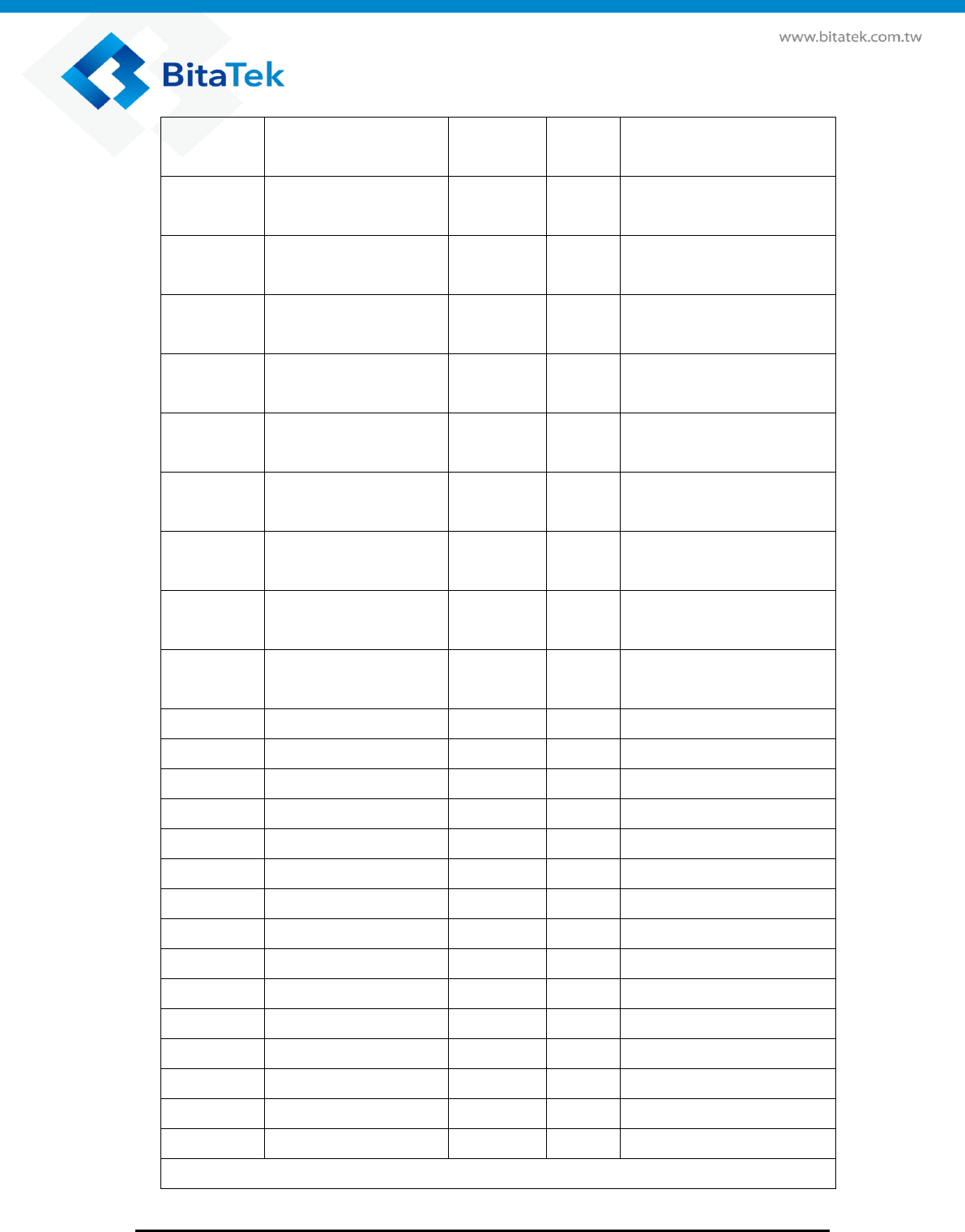
Page 22
BitaTek Co., Ltd. Copyright protected. All rights reserved.
NO. 115 Wugong 3rd Rd., Tel +886 2 2298 8588
Wugu Dist., New Taipei City 248, Taiwan (R.O.C.) Fax+886 2 2290 0029
F8
GPIO_118
GPIO
1.Configurable I/O
2. RFFE1_CLK
E8
GPIO_119
GPIO
1.Configurable I/O
2. RFFE1_DATA
G8
GPIO_120
GPIO
1. Configurable I/O
2. RFFE2_CLK
G7
GPIO_121
GPIO
1. Configurable I/O
2. RFFE2_DATA
G6
GPIO_122
GPIO
1. Configurable I/O
2. RFFE4_CLK
G5
GPIO_123
GPIO
1. Configurable I/O
2. RFFE4_DATA
H5
GPIO_124
GPIO
1. Configurable I/O
2. RFFE5_CLK
F5
GPIO_125
GPIO
1. Configurable I/O
2. RFFE5_DATA
H7
GPIO_126
GPIO
1. Configurable I/O
2. RFFE3_CLK
F4
GPIO_127
GPIO
1. Configurable I/O
2. RFFE3_DATA
W4
GPIO_128
GPIO
1. Configurable I/O
V4
GPIO_129
GPIO
1. Configurable I/O
T3
GPIO_130
GPIO
1. Configurable I/O
X8
GPIO_131
GPIO
1. Configurable I/O
U8
GPIO_132
GPIO
1. Configurable I/O
Z9
GPIO_133
GPIO
1. Configurable I/O
W15
PMI8952_GPIO_1
GPIO
1. Configurable I/O
W16
PMI8952_GPIO_2
GPIO
1. Configurable I/O
D16
PM8952_GPIO_01
GPIO
1. Configurable I/O
D15
PM8952_GPIO_02
GPIO
1. Configurable I/O
H16
PM8952_GPIO_04
GPIO
1. Configurable I/O
C17
PM8952_GPIO_05
GPIO
1. Configurable I/O
E15
PM8952_GPIO_06
GPIO
1. Configurable I/O
P18
PM8952_GPIO_07
GPIO
1. Configurable I/O
P19
PM8952_GPIO_08
GPIO
1. Configurable I/O
GND
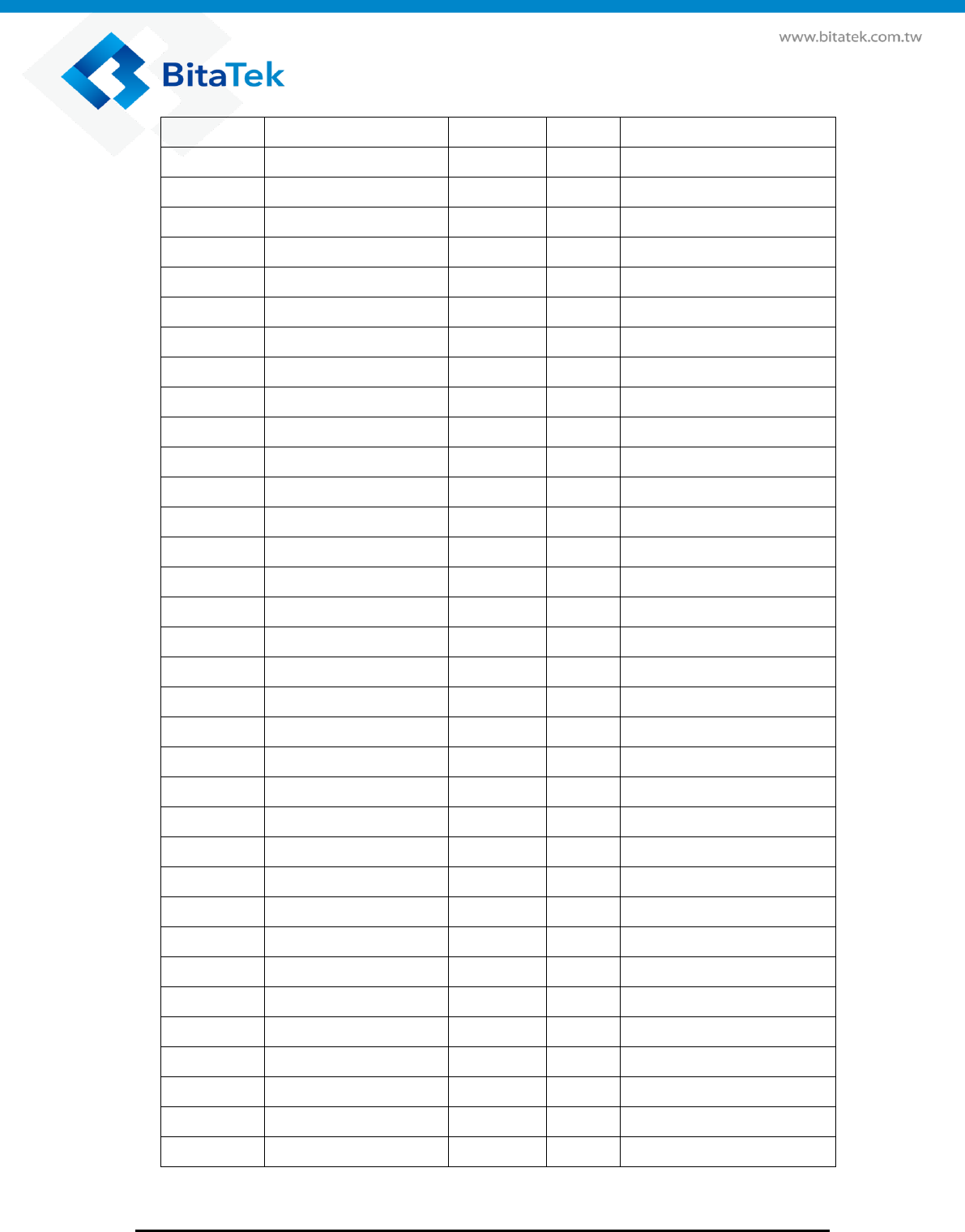
Page 23
BitaTek Co., Ltd. Copyright protected. All rights reserved.
NO. 115 Wugong 3rd Rd., Tel +886 2 2298 8588
Wugu Dist., New Taipei City 248, Taiwan (R.O.C.) Fax+886 2 2290 0029
A1
GND
GND
A3
GND
GND
A6
GND
GND
A7
GND
GND
A8
GND
GND
A9
GND
GND
A10
GND
GND
A11
GND
GND
A12
GND
GND
A14
GND
GND
A15
GND
GND
A16
GND
GND
A17
GND
GND
A18
GND
GND
A20
GND
GND
B1
GND
GND
B2
GND
GND
B3
GND
GND
B6
GND
GND
B7
GND
GND
B8
GND
GND
B9
GND
GND
B12
GND
GND
B13
GND
GND
B14
GND
GND
B15
GND
GND
B16
GND
GND
B17
GND
GND
B18
GND
GND
B19
GND
GND
B20
GND
GND
C7
GND
GND
C8
GND
GND
C9
GND
GND
C11
GND
GND
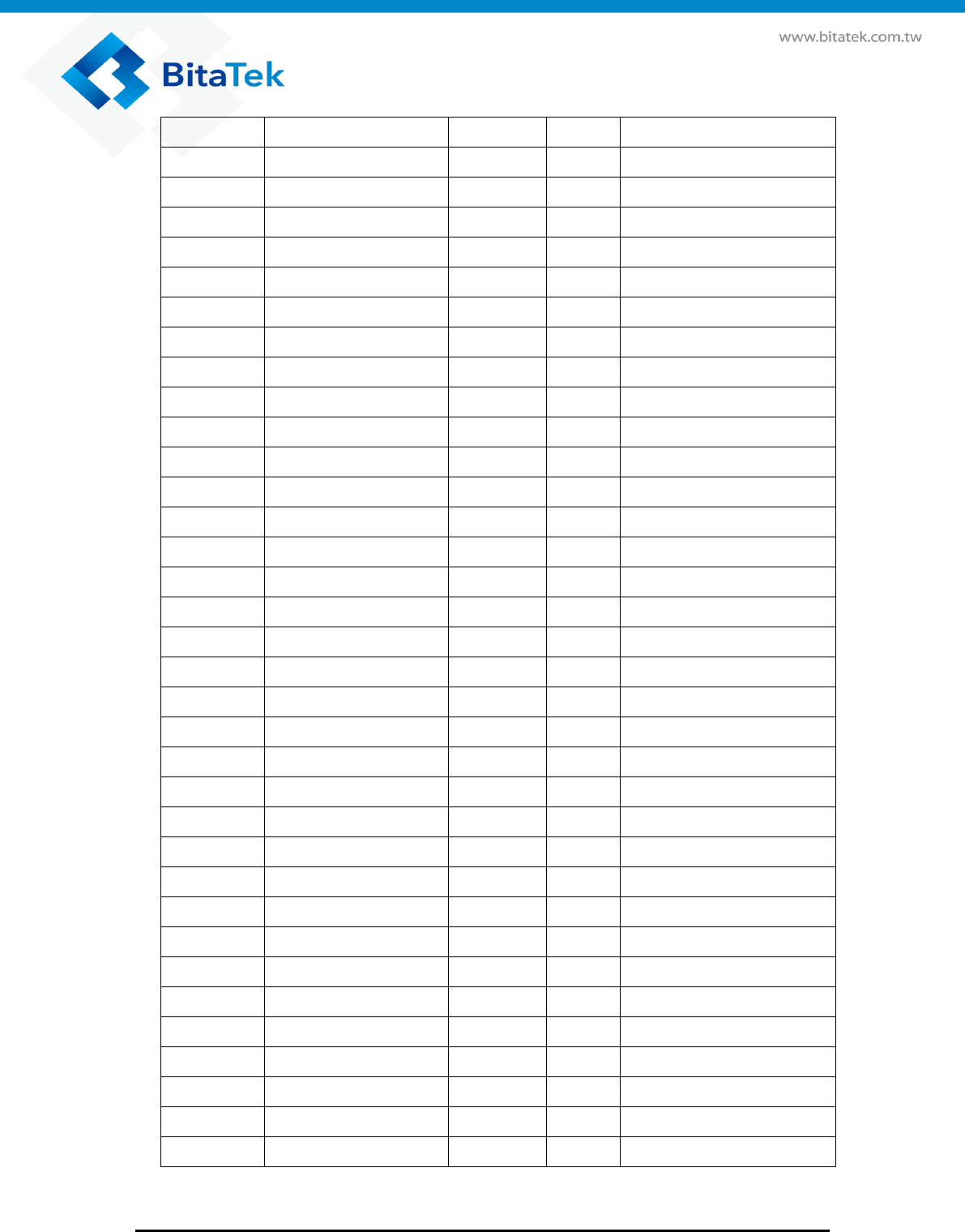
Page 24
BitaTek Co., Ltd. Copyright protected. All rights reserved.
NO. 115 Wugong 3rd Rd., Tel +886 2 2298 8588
Wugu Dist., New Taipei City 248, Taiwan (R.O.C.) Fax+886 2 2290 0029
C12
GND
GND
C13
GND
GND
C14
GND
GND
C20
GND
GND
D7
GND
GND
D8
GND
GND
D9
GND
GND
D13
GND
GND
D14
GND
GND
D20
GND
GND
E6
GND
GND
E7
GND
GND
E9
GND
GND
E17
GND
GND
E18
GND
GND
E19
GND
GND
E20
GND
GND
F7
GND
GND
F9
GND
GND
F18
GND
GND
F19
GND
GND
F20
GND
GND
G13
GND
GND
G14
GND
GND
G17
GND
GND
G18
GND
GND
G19
GND
GND
G20
GND
GND
H1
GND
GND
H9
GND
GND
H15
GND
GND
H17
GND
GND
I19
GND
GND
I20
GND
GND
J18
GND
GND
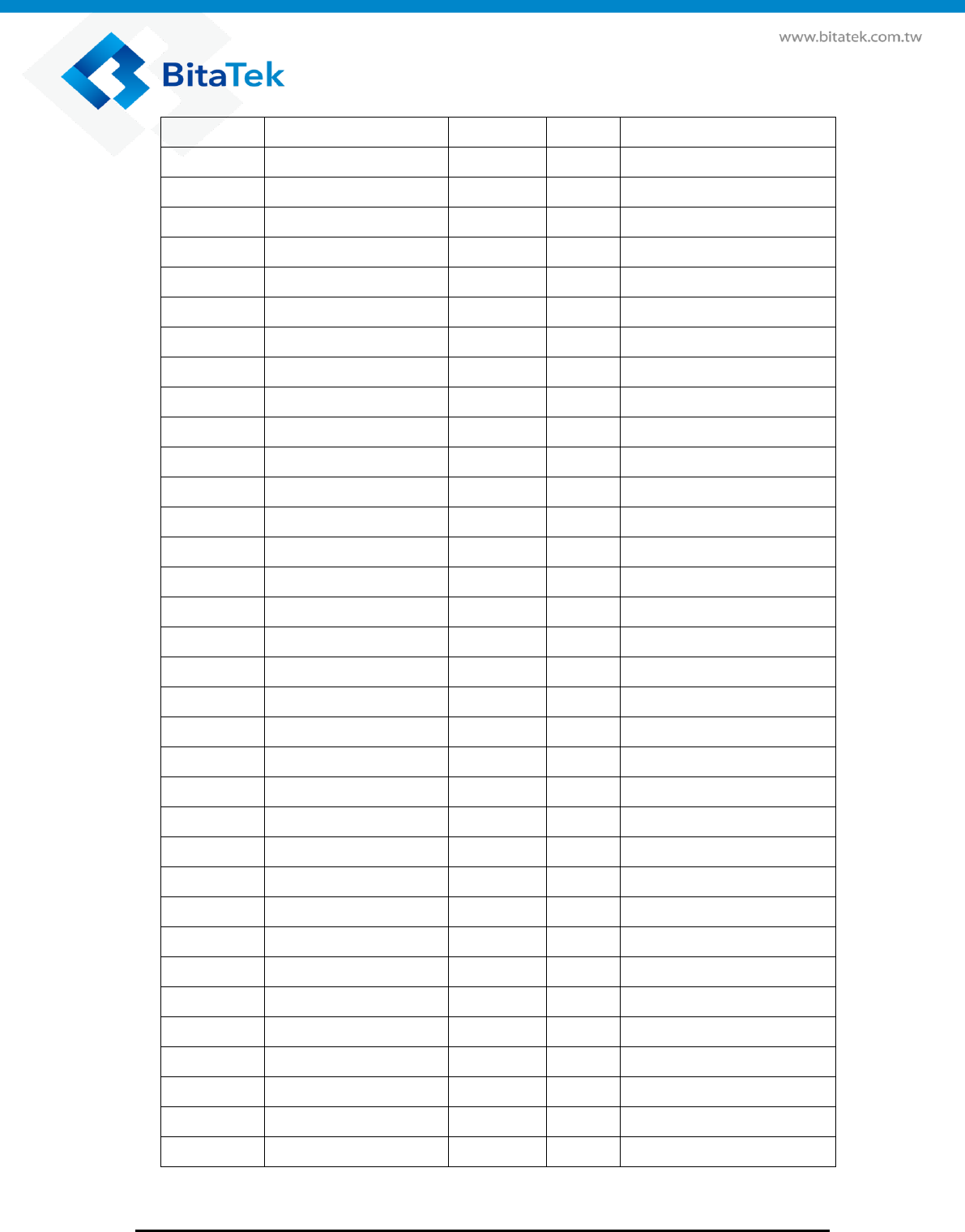
Page 25
BitaTek Co., Ltd. Copyright protected. All rights reserved.
NO. 115 Wugong 3rd Rd., Tel +886 2 2298 8588
Wugu Dist., New Taipei City 248, Taiwan (R.O.C.) Fax+886 2 2290 0029
K19
GND
GND
M18
GND
GND
M20
GND
GND
O18
GND
GND
O19
GND
GND
O20
GND
GND
Q18
GND
GND
Q19
GND
GND
Q20
GND
GND
R3
GND
GND
R20
GND
GND
S3
GND
GND
S18
GND
GND
S19
GND
GND
S20
GND
GND
T1
GND
GND
T2
GND
GND
T5
GND
GND
T6
GND
GND
T7
GND
GND
T10
GND
GND
U1
GND
GND
U2
GND
GND
U3
GND
GND
U5
GND
GND
U6
GND
GND
U7
GND
GND
U10
GND
GND
U11
GND
GND
U12
GND
GND
U20
GND
GND
V5
GND
GND
V6
GND
GND
V7
GND
GND
V11
GND
GND
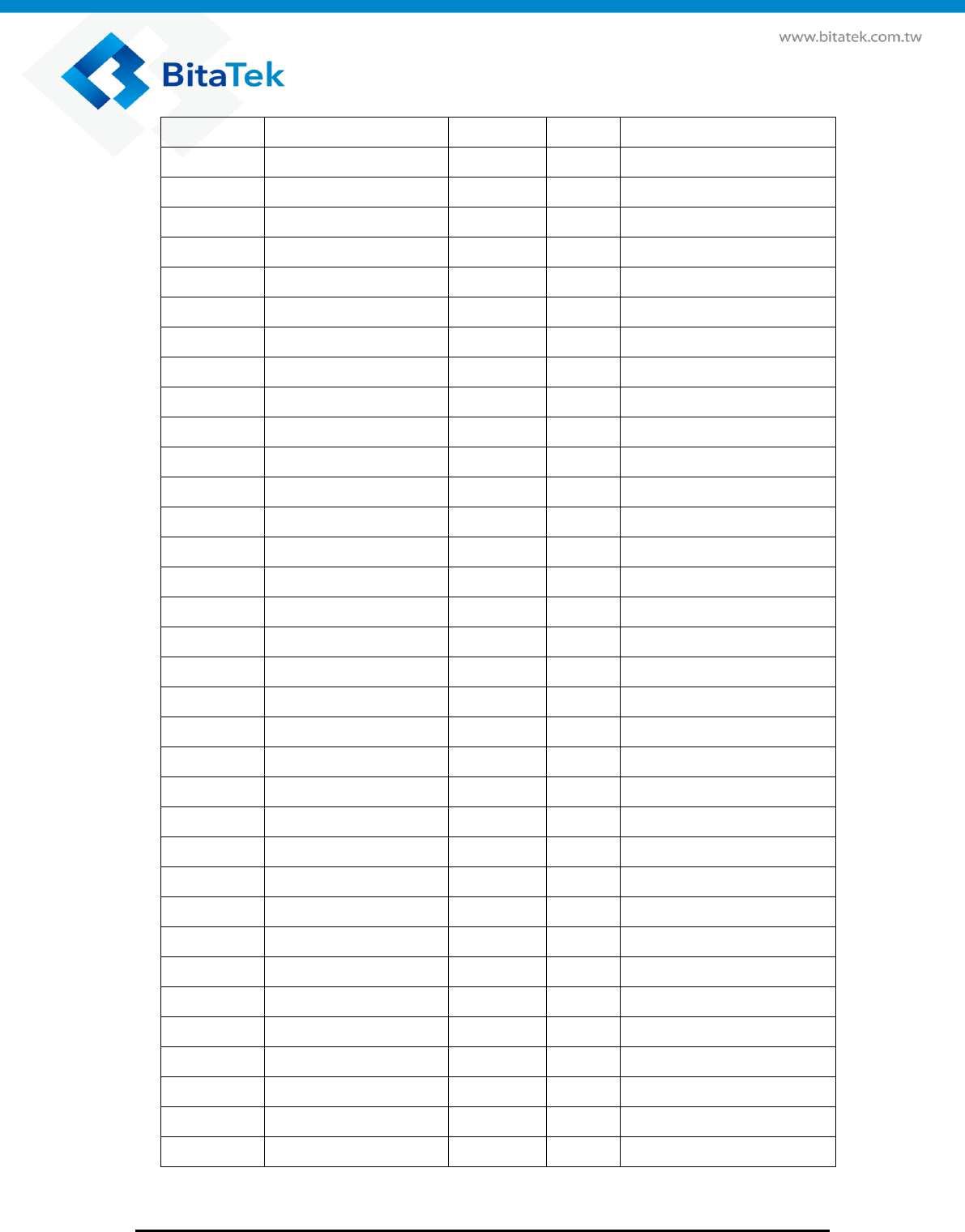
Page 26
BitaTek Co., Ltd. Copyright protected. All rights reserved.
NO. 115 Wugong 3rd Rd., Tel +886 2 2298 8588
Wugu Dist., New Taipei City 248, Taiwan (R.O.C.) Fax+886 2 2290 0029
W5
GND
GND
W6
GND
GND
W7
GND
GND
X1
GND
GND
X4
GND
GND
X5
GND
GND
X6
GND
GND
X7
GND
GND
Y1
GND
GND
Y2
GND
GND
Y3
GND
GND
Y4
GND
GND
Y5
GND
GND
Y6
GND
GND
Y7
GND
GND
Y20
GND
GND
Z1
GND
GND
Z2
GND
GND
Z3
GND
GND
Z4
GND
GND
Z5
GND
GND
Z6
GND
GND
Z7
GND
GND
Z20
GND
GND
AA1
GND
GND
AA2
GND
GND
AA3
GND
GND
AA4
GND
GND
AA5
GND
GND
AA6
GND
GND
AA7
GND
GND
AA8
GND
GND
AA9
GND
GND
AA10
GND
GND
AA11
GND
GND
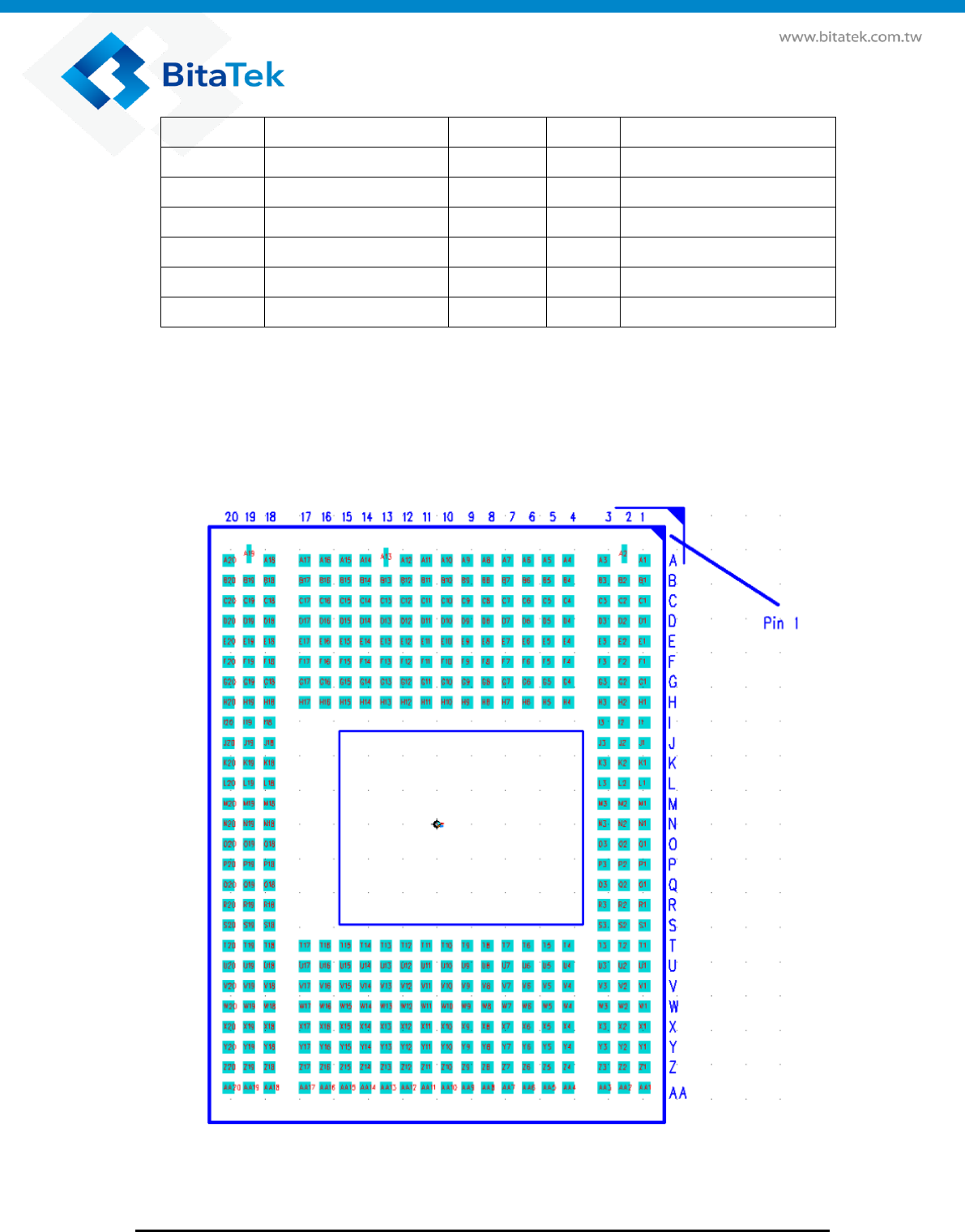
Page 27
BitaTek Co., Ltd. Copyright protected. All rights reserved.
NO. 115 Wugong 3rd Rd., Tel +886 2 2298 8588
Wugu Dist., New Taipei City 248, Taiwan (R.O.C.) Fax+886 2 2290 0029
AA12
GND
GND
AA13
GND
GND
AA14
GND
GND
AA15
GND
GND
AA16
GND
GND
AA17
GND
GND
AA20
GND
GND
3.4. Pad assignments (Top view)
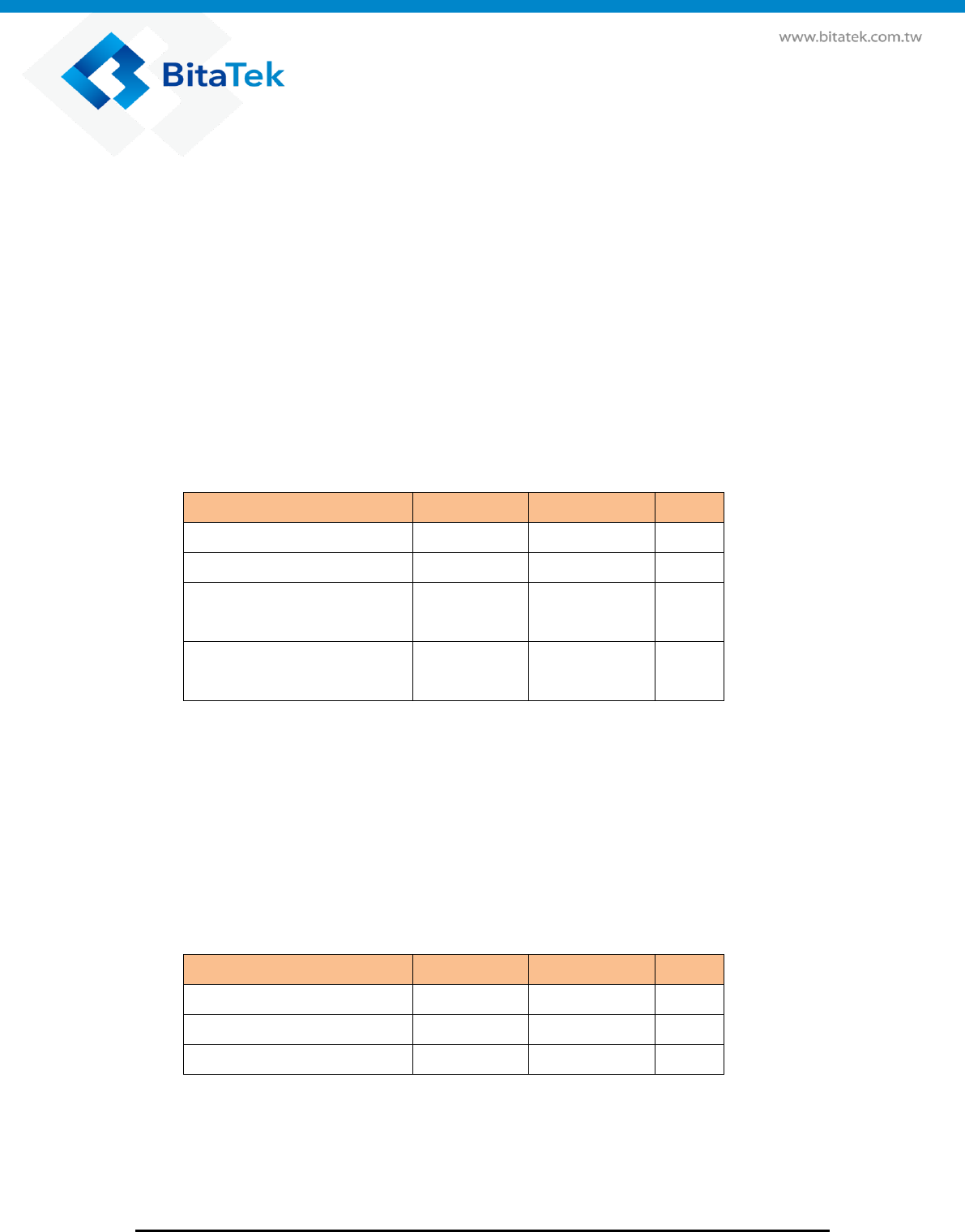
Page 28
BitaTek Co., Ltd. Copyright protected. All rights reserved.
NO. 115 Wugong 3rd Rd., Tel +886 2 2298 8588
Wugu Dist., New Taipei City 248, Taiwan (R.O.C.) Fax+886 2 2290 0029
3.5. Electrical Specification
3.5.1. Input power specification
Absolute maximum rating:
Operating FREY M1 under conditions beyond its absolute maximum ratings may damage
the device. Absolute maximum ratings are limiting values to be considered individually
when all other parameters are within their specified operating ranges. Functional operation
and specification compliance under any absolute maximum condition, or after exposure to
any of these conditions, is not guaranteed or implied. Exposure may affect device reliability.
Parameter
Min.
Max.
Units
USB_VBUS_IN
0
25
V
VPH_PWR
0
6
V
CHG_OUT (VBAT)
Steady state
0
5
V
CHG_OUT (VBAT)
Transient (< 10 ms)
0
6
V
Operation condition:
Operating conditions include parameters that are under the control of the user : power supply
voltage and ambient temperature. The FREY M1 meets all performance specifications listed in
this document when used and/or stored within the operating conditions, unless otherwise noted
in those sections (provided the absolute maximum ratings have never been exceeded).
Parameter
Min.
Max.
Units
USB_VBUS_IN
4.0
10
V
VPH_PWR
3.5
4.5
V
CHG_OUT (VBAT)
3.5
4.5
V
Note : There is battery detection algorithm in FREY M1 , user need to implement battery ID and
thermal pin on the system , otherwise system can't be powered on successfully .
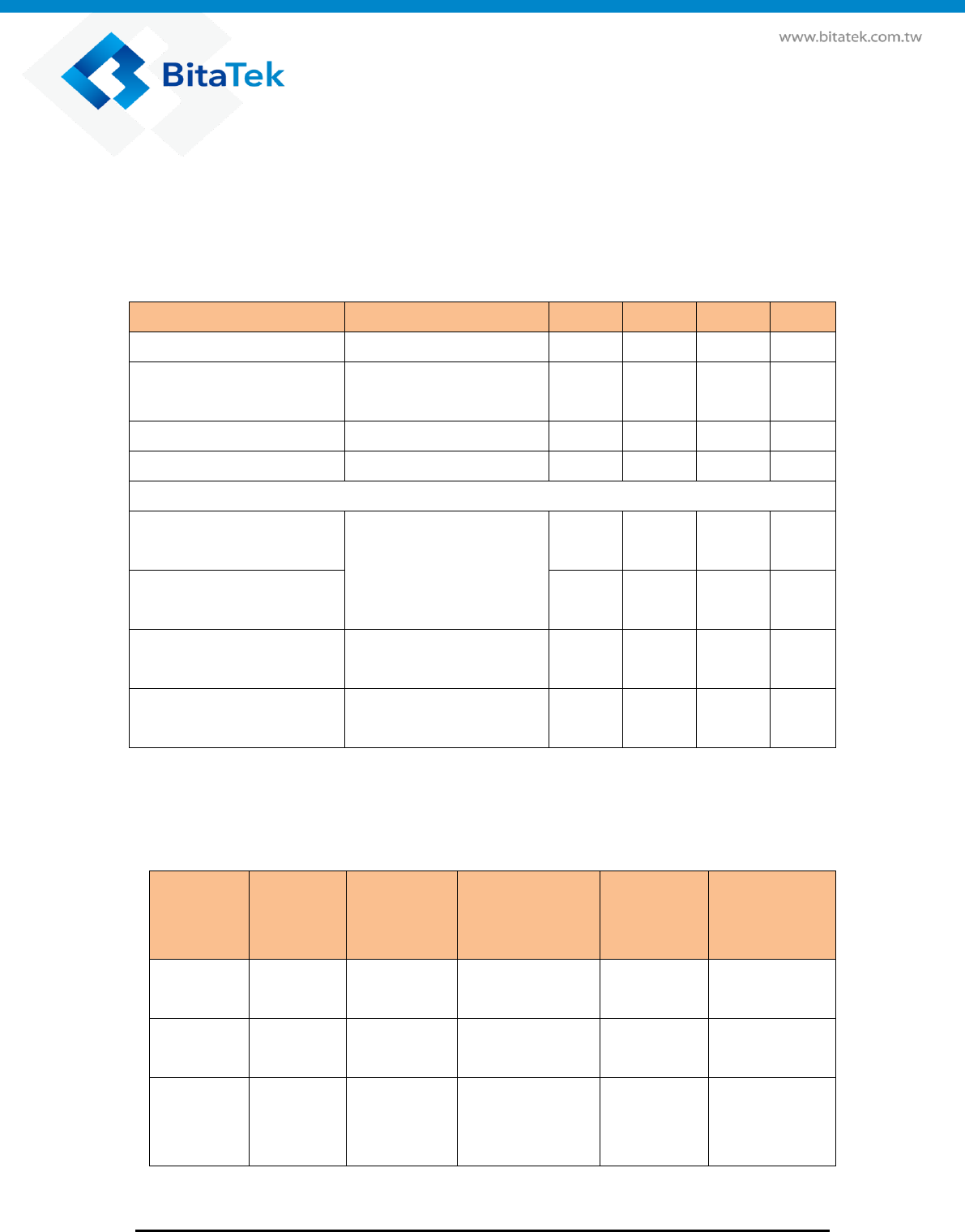
Page 29
BitaTek Co., Ltd. Copyright protected. All rights reserved.
NO. 115 Wugong 3rd Rd., Tel +886 2 2298 8588
Wugu Dist., New Taipei City 248, Taiwan (R.O.C.) Fax+886 2 2290 0029
Battery charger:
The FREY M1 features a fully programmable switch-mode battery charger, input power and
output power controller for terminal devices. The device is designed to be used in
conjunction with systems using single-cell Li-ion and Li-polymer battery packs.
Parameter
Conditions
Min
Typ
Max
Units
Peak switching current
USB_IN = 9.0 V
-
4
-
A
Maximum DC output
current
USB_IN = 9.0 V
-
3
-
A
Switching frequency
0.95
1.0
1.05
MHz
OTG output voltage
4.85
5.00
5.15
V
Charger-specific digital I/O characteristics
High-level input voltage
(VIH)
All charger digital
interface pads except
CHG_EN
1.5
-
-
V
Low-level input voltage
(VIL)
-
-
0.5
V
CHG_EN high-level input
voltage (VIH)
1.3
-
-
V
CHG_EN low-level input
voltage (VIL)
-
-
0.3
V
3.5.2. Output power specification
Output
power
Circuit
type
Default
voltage (V)
Specified
voltage range
(V)6
Rated
current
(mA)
Expected use
VREG_L1
NMOS
LDO
1.000
1.000
200
RFICs
VREG_L4
PMOS
LDO
1.800
1.800
450
RFICs and
GPS eLNA
VREG_L5
PMOS
LDO
1.800
1.800
300
Most digital
I/Os, LPDDR
and eMMC

Page 30
BitaTek Co., Ltd. Copyright protected. All rights reserved.
NO. 115 Wugong 3rd Rd., Tel +886 2 2298 8588
Wugu Dist., New Taipei City 248, Taiwan (R.O.C.) Fax+886 2 2290 0029
VREG_L6
PMOS
LDO
1.800
1.800
300
APQ DSI PLL
and OTP,
Camera,
Touch screen,
Display, and
sensors
VREG_L10
PMOS
LDO
2.850
2.850
150
Sensors
VREG_L11
PMOS
LDO
2.950
2.950
800
Micro SD
VREG_L12
PMOS
LDO
2.950
1.800/2.950
150
APQ pad
group 2 and
SDC2
VREG_L14
PMOS
LDO
1.800
1.800/3.300
50
APQ pad
group 5,
dual-voltage
UIM1, and
NFC
VREG_L16
PMOS
LDO
1.800
1.800
5
PMIC HKADC
VREG_L17
PMOS
LDO
2.850
2.850
600
Camera,
Display, and
Touch screen
VREG_L18
PMOS
LDO
2.700
2.700
150
QTI RF
front-end
VREG_L22
PMOS
LDO
2.800
2.800
300
Camera –
analog
VREG_L23
NMOS
LDO
1.200
1.200
300
Camera –
digital
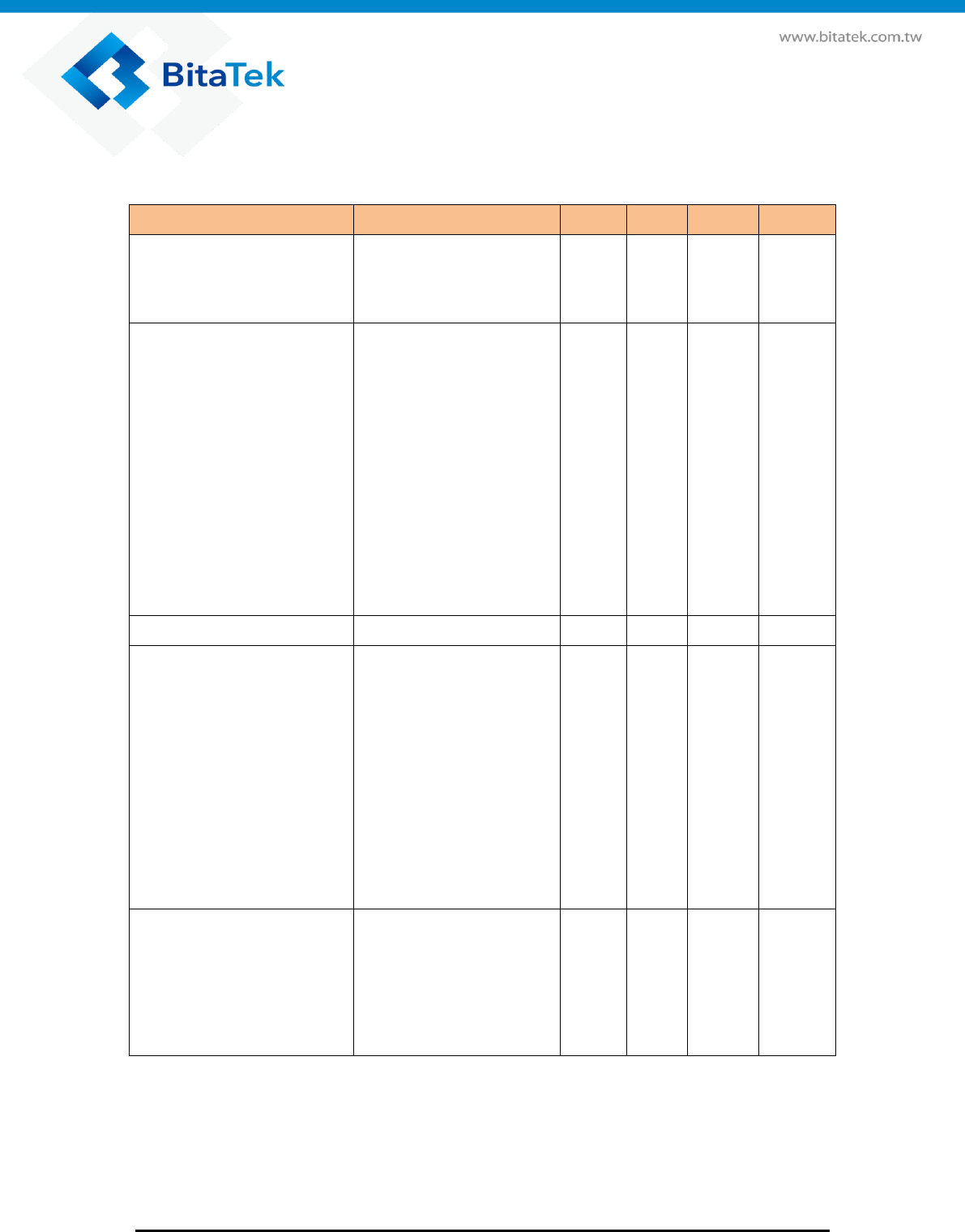
Page 31
BitaTek Co., Ltd. Copyright protected. All rights reserved.
NO. 115 Wugong 3rd Rd., Tel +886 2 2298 8588
Wugu Dist., New Taipei City 248, Taiwan (R.O.C.) Fax+886 2 2290 0029
LDO performance specifications
Parameter
Comments
Min
Typ
Max
Units
Output voltage
All NMOS
All PMOS
12.5 mV steps
12.5 V steps
0.375
1.75
-
-
1.5375
3.3375
V
V
Overall DC voltage output
error
Normal mode
At default voltage
At non-default
voltages
Low-power mode
At default voltage
At non-default
voltages
Over-voltage,
temperature, and process
variations plus load and
line regulation
-2
-3
-4
-5
-
-
-
-
2
3
4
5
%
%
%
%
Temperature coefficient
-100
-
100
ppm/°C
NMOS power-supply ripple
rejection
Normal mode
50 Hz–1 kHz
1–10 kHz
10–100 kHz
Low-power mode
50 Hz–1 kHz
1–100 kHz
PSRR
60
-
-
-
-
70
60
50
50
40
-
-
-
-
-
dB
dB
dB
dB
dB
PMOS power-supply ripple
rejection
50 Hz–1 kHz
1–10 kHz
10–100 kHz
43
35
13
-
-
-
-
-
-
dB
dB
dB
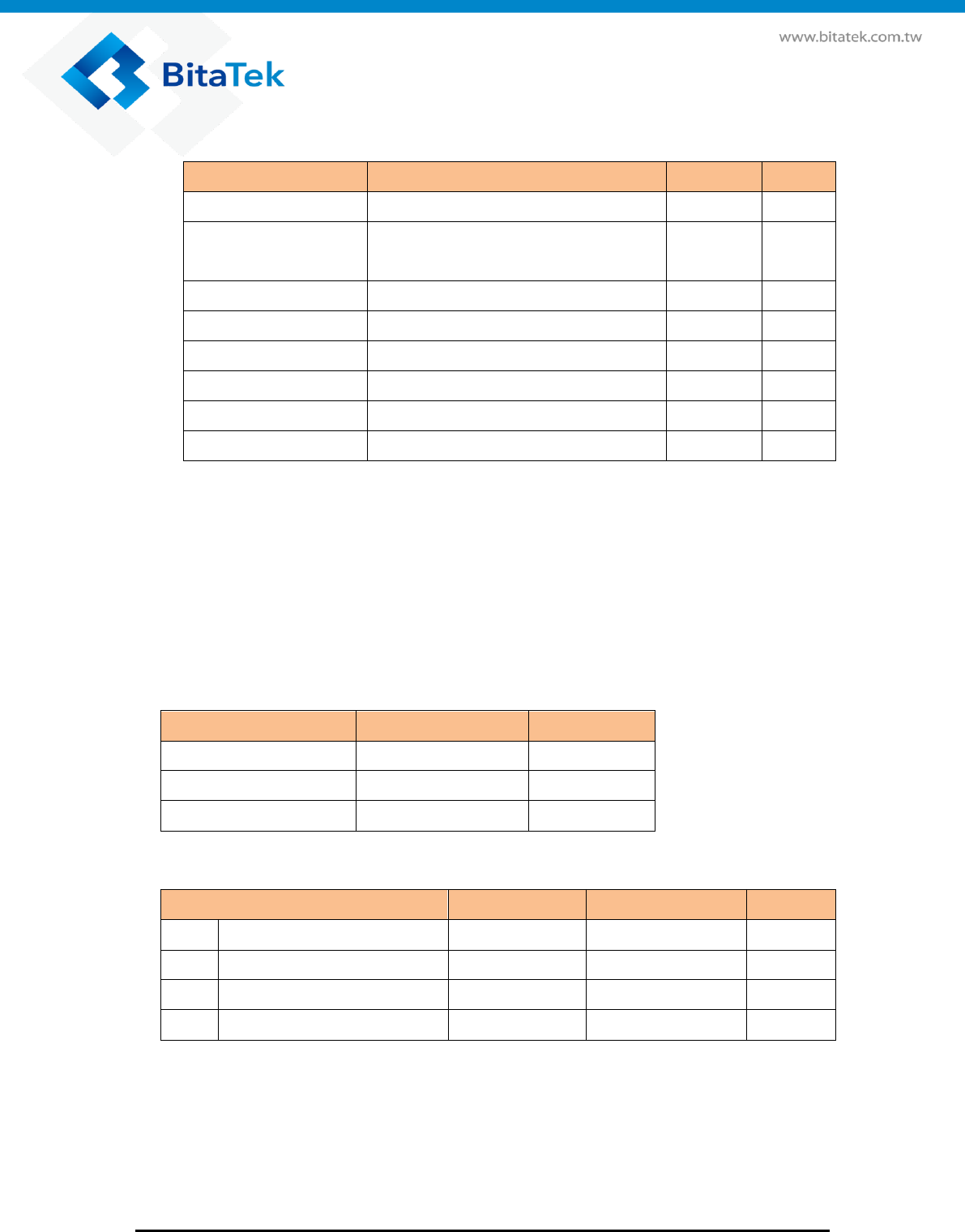
Page 32
BitaTek Co., Ltd. Copyright protected. All rights reserved.
NO. 115 Wugong 3rd Rd., Tel +886 2 2298 8588
Wugu Dist., New Taipei City 248, Taiwan (R.O.C.) Fax+886 2 2290 0029
3.5.3. Current consumption
Item
Test condition
Max.
Units
Off mode current
Module is turned off
250
uA
Flight mode current
Module is turned on and in sleep mode
and all RF is turned off
4.5
mA
WiFi TX current
2.4G, 11b, 11 Mbps, 15 dBm
250
mA
WiFi RX current
2.4G
130
mA
WiFi TX current
5G, 11a, 54 Mbps, 15 dBm
250
mA
WiFi RX current
5G
130
mA
BT TX current
class 2 , 2dBm
150
mA
BT RX current
130
mA
Note 1. The measurement is at VBAT of module and VBAT=3.8V .
Note 2. WiFi & BT current is measured with IQexl 160.
3.5.4. Digital logic characteristics
Digital I/Os specification
Pad voltage
Usage
Table
1.8 V
Most digital I/Os
Table 3.5.4.1
Dual-V (1.8 V/2.95 V)
SDC2, UIM
Table 3.5.4.2
Dual-V (1.8 V/3.05 V)
USB
Table 3.5.4.3
Table 3.5.4.1 Digital I/O (VDD_P3= VREG_L5)
Parameter
Min.
Max.
Unit
VIH
High-level input voltage
0.65 × VDD_P3
-
V
VIL
Low-level input voltage
-
0.35 × VDD_P3
V
VOH
High-level output voltage
VDD_P3 - 0.45
-
V
VOL
Low-level output voltage
-
0.45
V
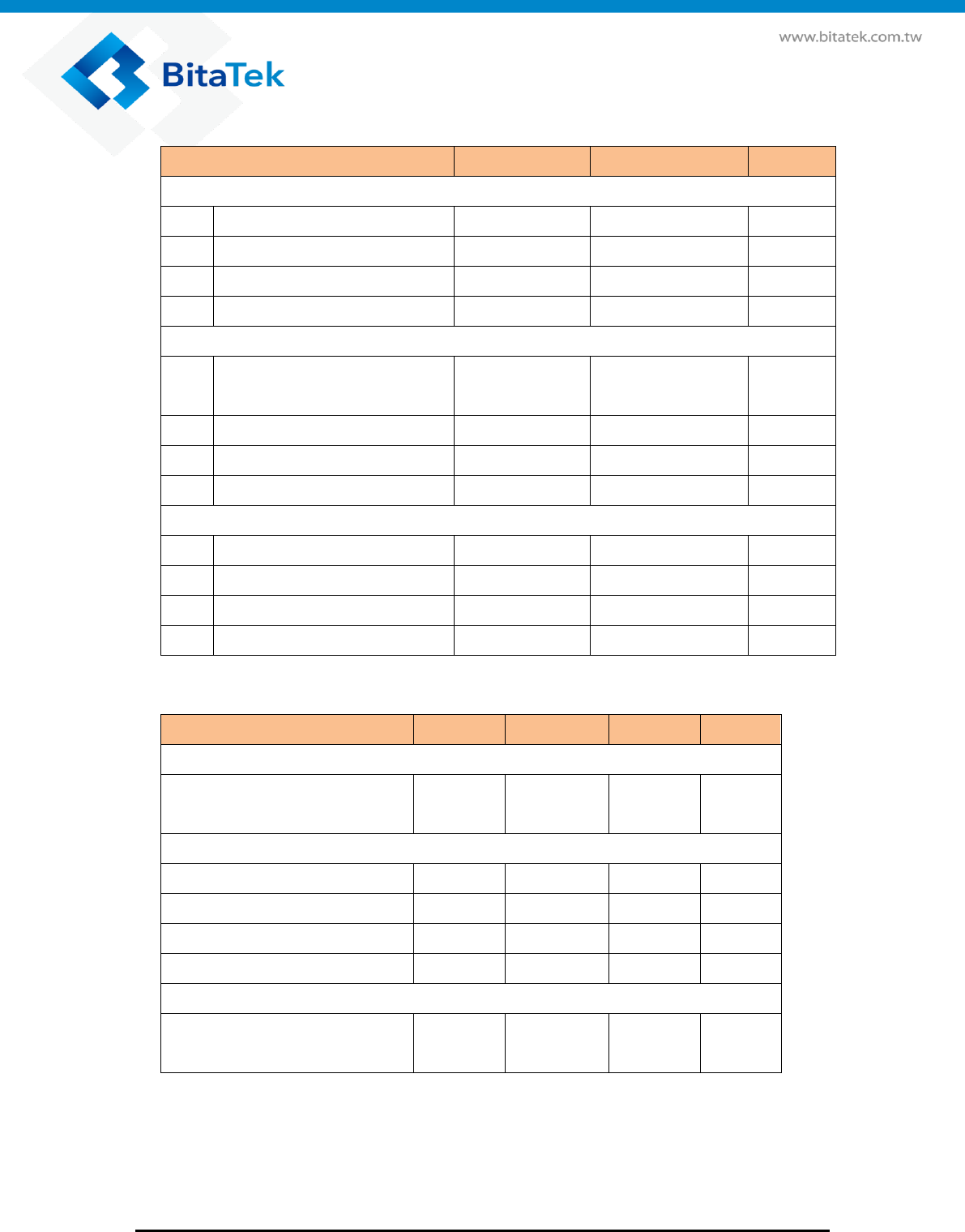
Page 33
BitaTek Co., Ltd. Copyright protected. All rights reserved.
NO. 115 Wugong 3rd Rd., Tel +886 2 2298 8588
Wugu Dist., New Taipei City 248, Taiwan (R.O.C.) Fax+886 2 2290 0029
Table 3.5.4.2 SDC2,UIM
Parameter
Min.
Max.
Unit
Common to UIM pads at either voltage (VDD_PX= VREG_L14)
VIH
High-level input voltage
0.7 × VDD_PX
VDD_PX + 0.3
V
VIL
Low-level input voltage
0
0.2 × VDD_PX
V
VOH
High-level output voltage
0.8 × VDD_PX
VDD_PX
V
VOL
Low-level output voltage
0
0.4
V
SDC2 pads at 2.95 V only(VDD_PX= VREG_L12)
VIH
High-level input voltage
0.625 ×
VDD_PX
VDD_PX + 0.3
V
VIL
Low-level input voltage
0
0.25 × VDD_PX
V
VOH
High-level output voltage
0.75 × VDD_PX
VDD_PX
V
VOL
Low-level output voltage
0
0.125 × VDD_PX
V
SDC2 pads at 1.8 V only
VIH
High-level input voltage
1.27
2
V
VIL
Low-level input voltage
0
0.58
V
VOH
High-level output voltage
1.4
-
V
VOL
Low-level output voltage
0
0.45
V
Table 3.5.4.3 USB
Parameter
Min.
Typ.
Max.
Unit
Supply voltages
Dual-supply
-
-
1.80
3.075
-
-
V
USBPHY_SYSCLK
Frequency
-
19.2
-
MHz
Duty cycle
40
-
60
%
Low-level input voltage (VIL)
-
-
0.85
V
High-level input voltage (VIH)
1.27
-
-
V
USBPHY_VBUS
Valid USB_HS_VBUS detection
voltage
2.0
-
5.25
V
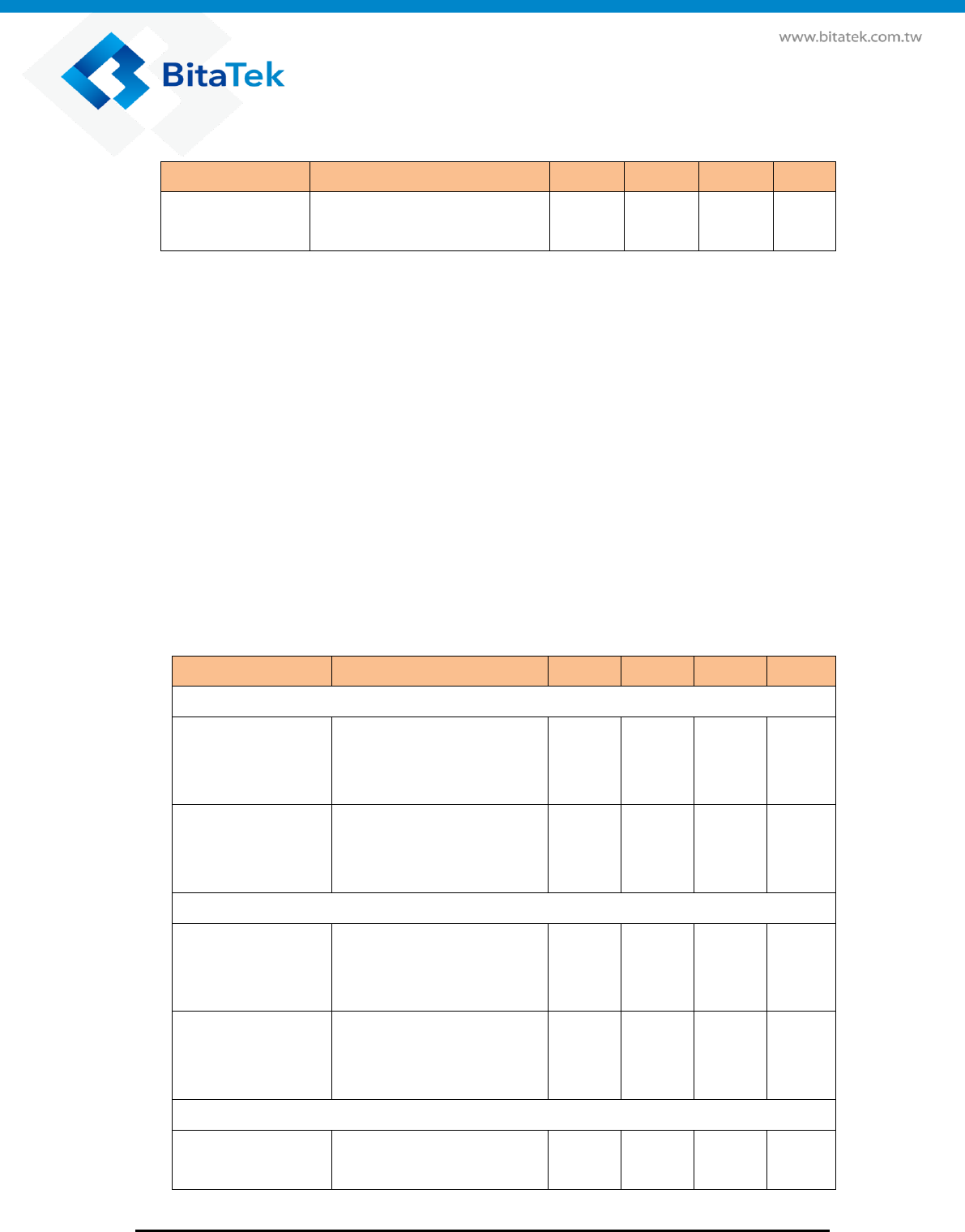
Page 34
BitaTek Co., Ltd. Copyright protected. All rights reserved.
NO. 115 Wugong 3rd Rd., Tel +886 2 2298 8588
Wugu Dist., New Taipei City 248, Taiwan (R.O.C.) Fax+886 2 2290 0029
3.5.5. Coin-cell charging
Parameter
Condition
Min
Typ
Max
Unit
Target regulator
voltage(*)
VIN > 3.3 V, ICHG = 100 µA
2.50
3.10
3.25
V
(*) Valid regulator voltage settings are 2.5, 3.0, 3.1, and 3.2 V.
3.5.6. Audio
All audio codec performance data are collected above Vbatt of 3.7 V, unless otherwise
specified.
Inputs and Tx processing
All Tx performance parameters are measured with a 1.02 kHz sine wave input signal,
capless differential or single-ended inputs, Fs = 48 kHz, 24-bit data, and MCLK = 9.6 MHz
or 12.288 MHz.
Parameter
Conditions
Min
Typ
Max
Units
Microphone amplifier gain = 0 dB (minimum gain)
Input referred noise
Analog input = -200 dBV,
A-weighted, bandwidth 20
Hz–20 kHz
-
19.0
25.1
µVrms
Signal-to-noise
ratio
Analog input = 0 dBV,
A-weighted, bandwidth 20
Hz–20 kHz
92.0
94.0
-
dB
Microphone amplifier gain = 24 dB (maximum gain)
Input referred noise
Analog input = -200 dBV,
A-weighted, bandwidth 20
Hz–20 kHz
-
2.7
4.2
µVrms
Signal-to-noise
ratio
Analog input = -24 dBV,
A-weighted, bandwidth 20
Hz–20 kHz
84.0
88.0
-
dB
General requirements
Power supply
rejection
100 mVpp sine wave
imposed on PMIC vph_pwr
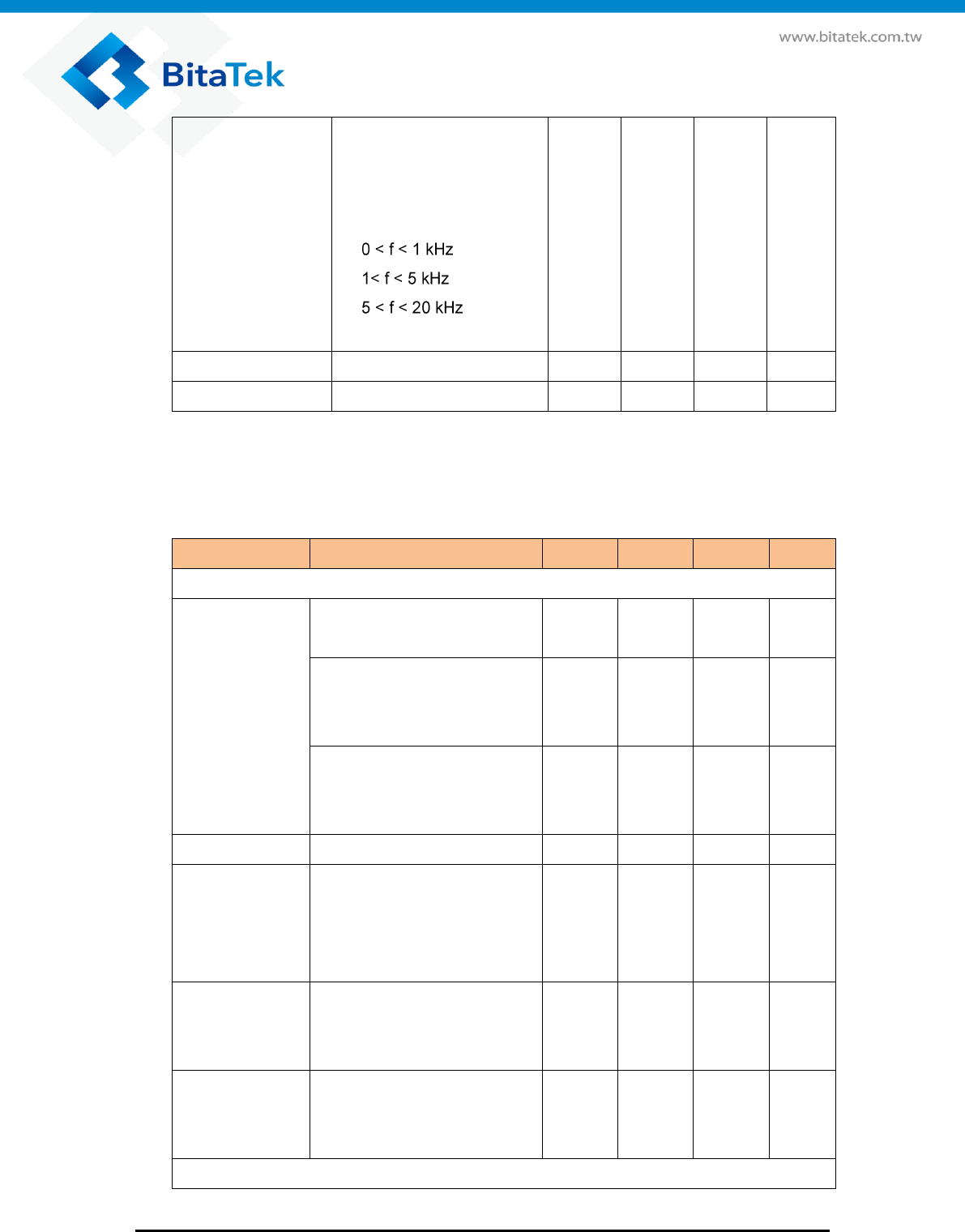
Page 35
BitaTek Co., Ltd. Copyright protected. All rights reserved.
NO. 115 Wugong 3rd Rd., Tel +886 2 2298 8588
Wugu Dist., New Taipei City 248, Taiwan (R.O.C.) Fax+886 2 2290 0029
input; analog input = 0
Vrms, terminated with 0 Ω
Terminate inputs with 0 Ω;
gain = 0 dB
75
75
60
95
95
97
-
-
-
dB
dB
dB
Input impedance
Input disabled
3
-
-
MΩ
Input capacitance
Capless input
-
-
15
pF
Outputs and Rx processing
Parameter
Conditions
Min
Typ
Max
Units
Earpiece
Output power
f = 1.02 kHz, 0 dBFS input,
6 dB gain mode, 32 Ω
120.0
127.0
-
mW
f = 1.02 kHz, -1.5 dBFS
input, 6 dB gain mode, 16
Ω
160.0
172.0
-
mW
f = 1.02 kHz, -3.5 dBFS
input, 6 dB gain mode,
10.67 Ω
150.0
160.0
-
mW
Output load
Supported output load
10.7
32.0
50000
Ω
Output
capacitance
Total capacitance between
EARO_P and EARO_M,
including PCB capacitance
and EMI
-
-
500
pF
Disabled
output
impedance
Measured externally with
amplifier disabled
1.0
-
-
M Ω
Output
common mode
voltage
Measured externally with
amplifier disabled
1.52
1.60
1.68
V
Headphone
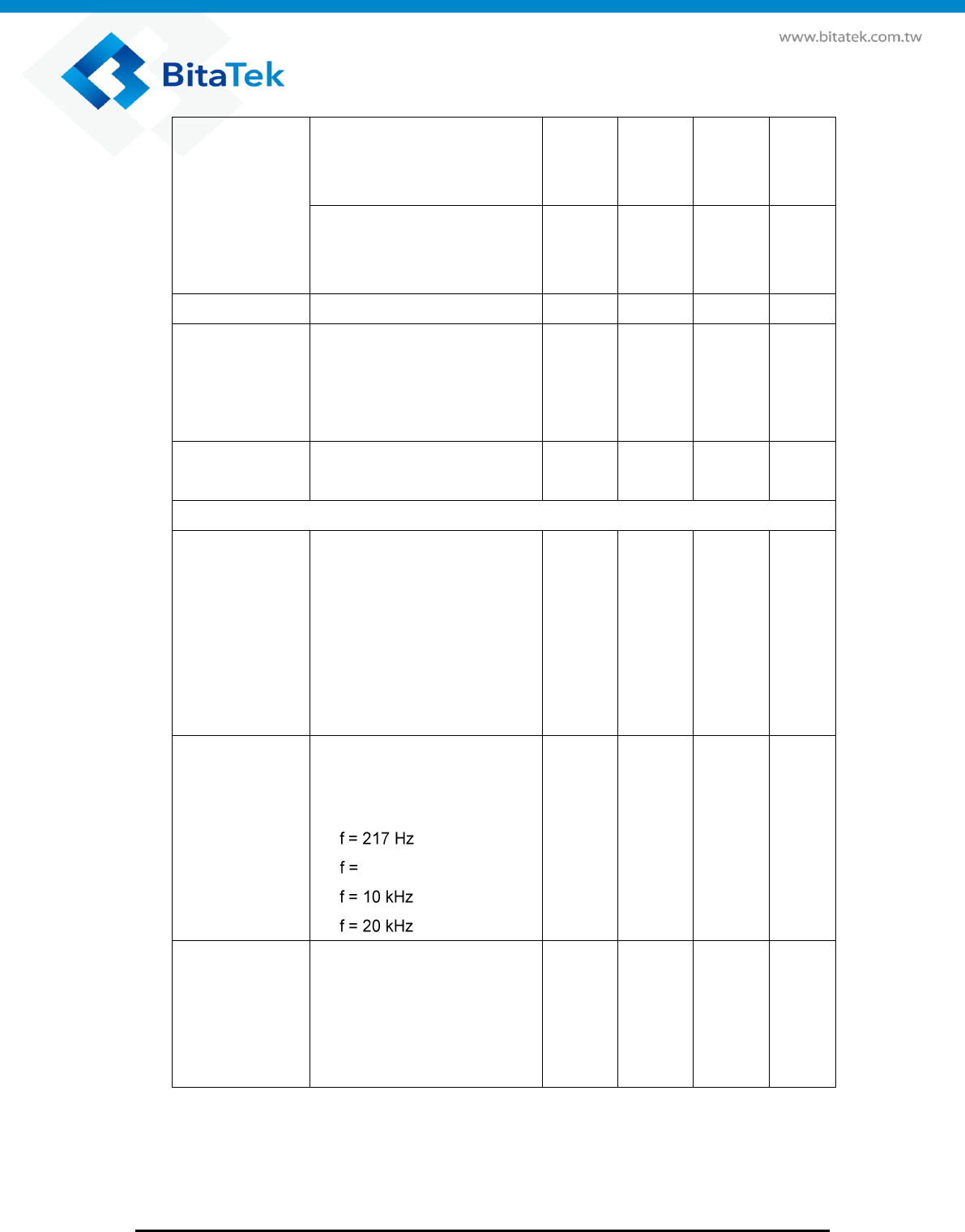
Page 36
BitaTek Co., Ltd. Copyright protected. All rights reserved.
NO. 115 Wugong 3rd Rd., Tel +886 2 2298 8588
Wugu Dist., New Taipei City 248, Taiwan (R.O.C.) Fax+886 2 2290 0029
Output power
f = 1.02 kHz, 0 dB FS, 16 Ω
load; VDD_CP = 1.95 V, 0 dB
gain mode
60.0
63.0
-
mW
f = 1.02 kHz, 0 dB FS, 32 Ω
load; VDD_CP = 1.95 V, 0 dB
gain mode
27.0
30.8
-
mW
Output load
Supported output load
13.0
16.0
50000
Ω
Output
capacitance
Total capacitance on HPH
output (single-ended),
including PCB capacitance
and EMI
-
-
1000
pF
Disabled output
impedance
Measured externally, with
amplifier disabled
1.0
-
-
MΩ
Mono speaker
Output power
Vdd = 5 V , f = 1 kHz
THD + N < 8.7%; 15 µH + 8 Ω
+15 µH
THD+N ≤ 1%; 15 µH + 8 Ω +
15 µH
THD+N ≤ 1%; 15 µH + 4 Ω +
15 µH
-
1200
1500
1700
1400
2150
-
-
-
mW
mW
mW
Power supply
rejection
200 mVpp sine wave imposed
on PMIC_VBATT; digital input
= -999 dBFS2
1 kHz
60.0
60.0
40.0
40.0
85.0
86.0
86.0
82.0
-
-
-
-
dB
dB
dB
dB
Efficiency
Vdd = 5 V
Pout = 1 W, 15 µH + 8 Ω + 15
µH
Pout = 2 W, 15 µH + 4 Ω + 15
µH
73.0
60.0
82.0
77.0
-
-
%
%
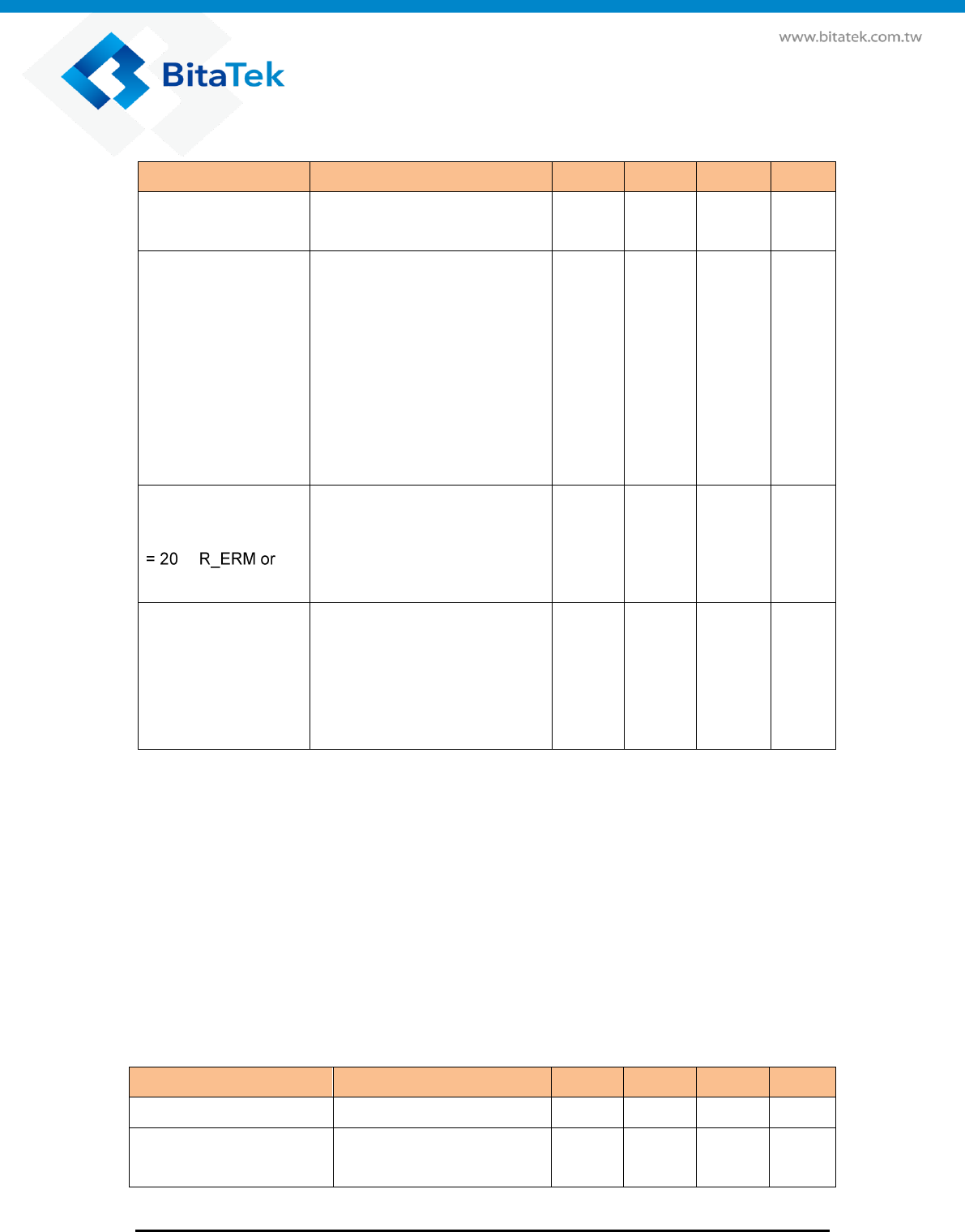
Page 37
BitaTek Co., Ltd. Copyright protected. All rights reserved.
NO. 115 Wugong 3rd Rd., Tel +886 2 2298 8588
Wugu Dist., New Taipei City 248, Taiwan (R.O.C.) Fax+886 2 2290 0029
3.5.7. Vibrator
Parameter
Conditions
Min
Typ
Max
Units
Operational input
voltage
Connected at VDD_HAP (VH
below)
2.5
3.6
4.75
V
Output voltage
Peak, no load
Average (V_HA)
Maximum drive
Accuracy
At HAP_OUT_P and
HAP_OUT_N
Differential, over one PWM
cycle
Differential, over one PWM
cycle
Duty cycle < 95%
-
0
1.2
-
-
-
-
50
VH
3.6
3.6
-
V
V
V
mV
Output current limit
R_ERM or R_load
R_load = 10
Cycle-to-cycle limit
300
600
400
800
500
1000
mA
mA
Internal PWM
frequency
Programmable
options
Accuracy
253 kHz, 505 kHz, 739 kHz,
1076 kHz
253
-
503
-
1076
+/-16
KHz
%
3.5.8. Display ± bias
FREY M1 provides the plus and minus bias voltages for LCD displays; pertinent
performance specifications are listed as below.
Display plus bias
Parameter
Conditions
Min
Typ
Max
Units
Operational input voltage
Connected at VDD_DIS_P
2.5
-
4.75
V
Output voltage
(VDIS_P_OUT)
5.0
5.5
6.1
V
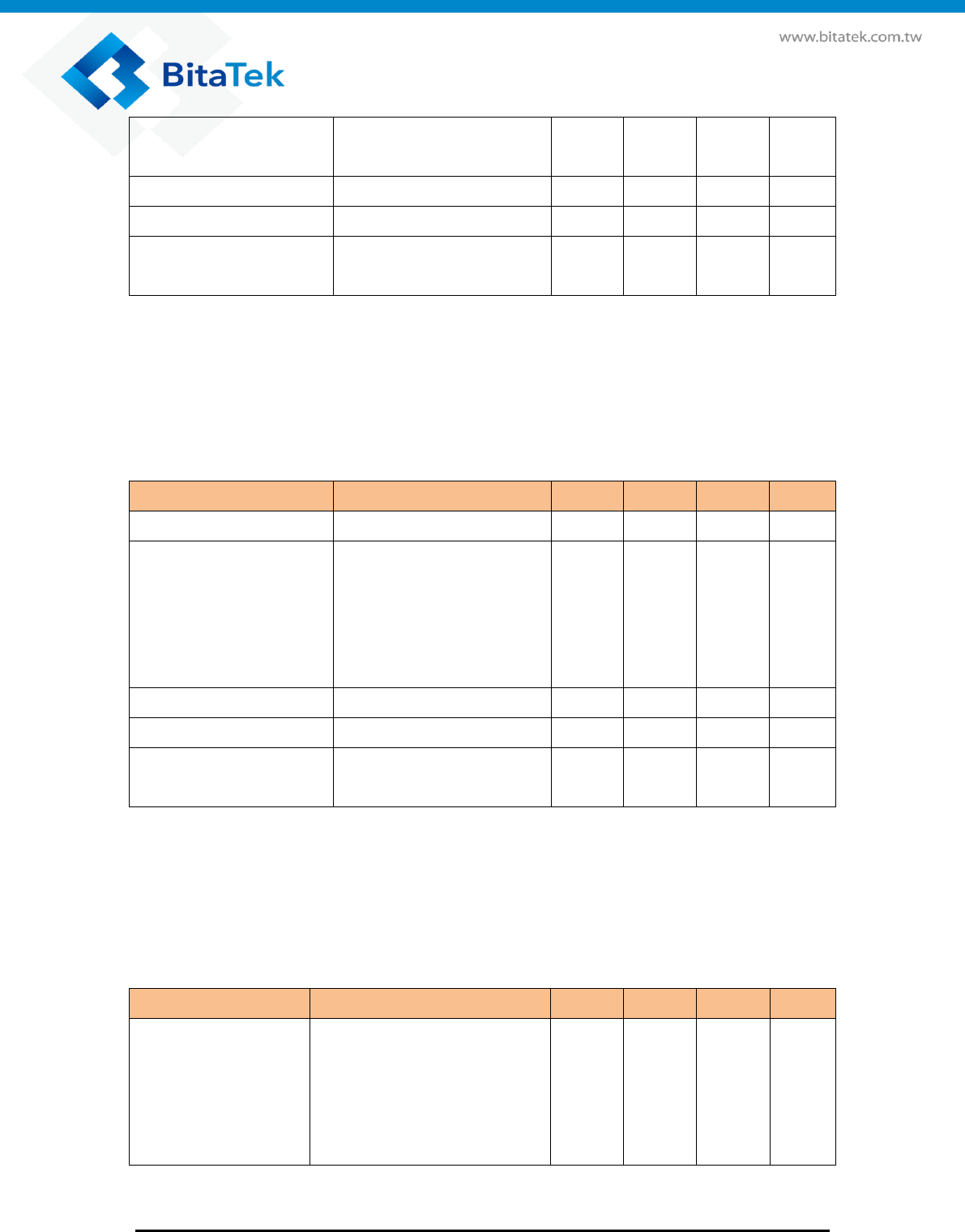
Page 38
BitaTek Co., Ltd. Copyright protected. All rights reserved.
NO. 115 Wugong 3rd Rd., Tel +886 2 2298 8588
Wugu Dist., New Taipei City 248, Taiwan (R.O.C.) Fax+886 2 2290 0029
Range, no load to 150 mA
Resolution
-
100
-
mV
Output current
-
-
150
mA
Efficiency
I_out = 30 mA
-
92
-
%
Switching frequency
(default)
-
1.48
-
MHz
NOTE: All specifications apply at VDD_DIS_x = 3.6 V , T = -30 to +85ºC, VDIS_P_OUT = 5.5 V, L
= 4.7 µH, and C = 10 µF (capacitance value de-rated from 22 µF nominal) .
Display minus bias
Parameter
Conditions
Min
Typ
Max
Units
Operational input voltage
Connected at VDD_DIS_N
2.5
-
4.75
V
Output voltage
(VDIS_N_OUT)
Range, no load to 150
mA
Resolution
-1.4
-
-
100
-6.0
-
V
mV
Output current
-
-
150
mA
Efficiency
I_out = 50 mA
-
84
-
%
Switching frequency
(default)
-
1.48
-
MHz
NOTE: All specifications apply at VDD_DIS_x = 3.6 V, T = -30 to +85ºC, VDIS_N_OUT = -5.5 V,
L = 4.7 µH, C = 10 µF (capacitance value de-rated from 22 µF nominal) .
3.5.9. Flash drivers (including torch mode)
Parameter
Conditions
Min
Typ
Max
Units
Driver input voltage
VDD_FLASH
Flash disabled
Flash enabled
VDD_TORCH
Expected source is PMI’s
DC_IN_OUT
2.5
-
-
-
-
3.6
10
5.8
5.5
V
V
V
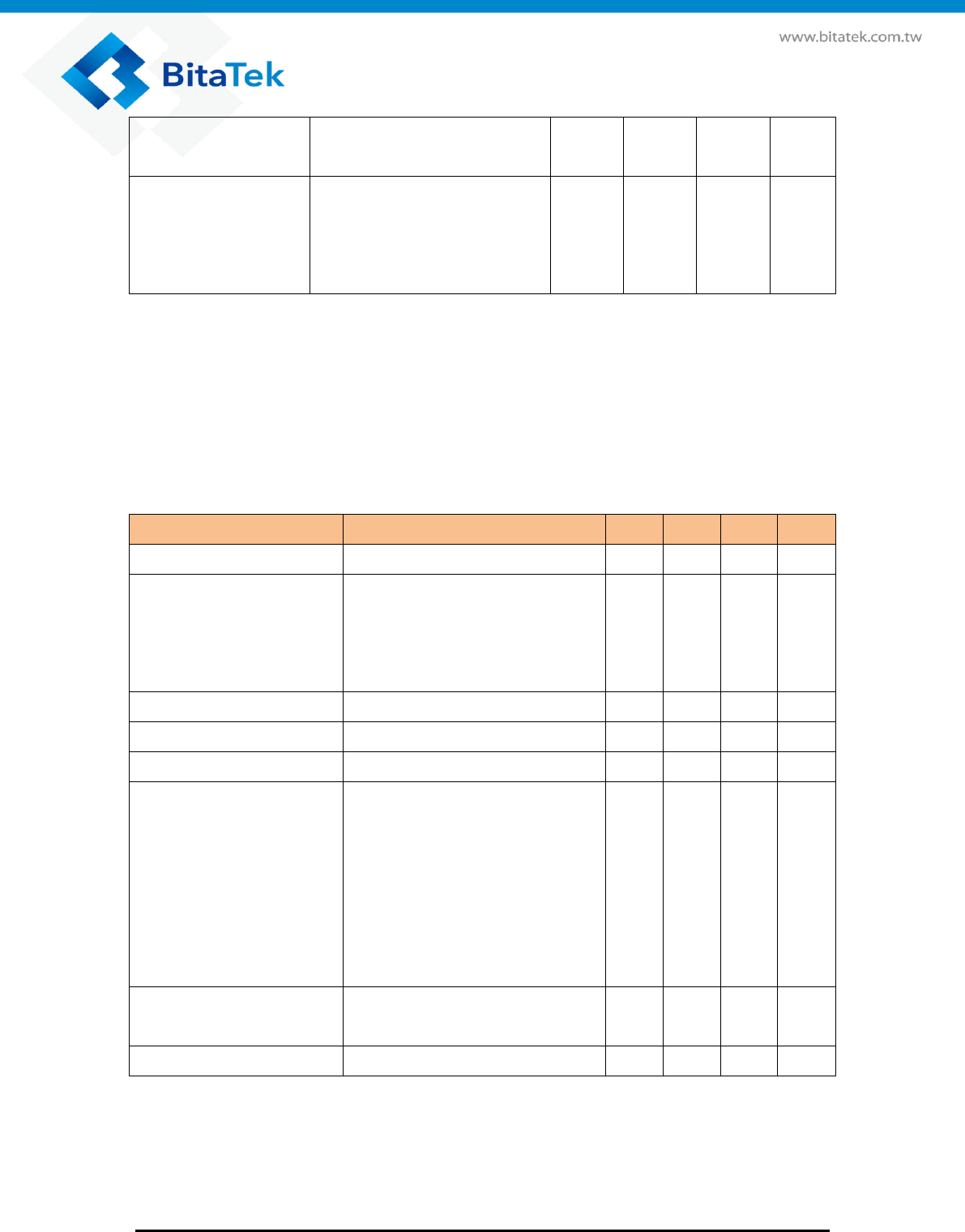
Page 39
BitaTek Co., Ltd. Copyright protected. All rights reserved.
NO. 115 Wugong 3rd Rd., Tel +886 2 2298 8588
Wugu Dist., New Taipei City 248, Taiwan (R.O.C.) Fax+886 2 2290 0029
Expected source is PMI’s
VREG_BST_BYP
Output current per
LED
Flash
Torch
-
-
-
-
1000
200
mA
mA
NOTE: All specifications apply at VPH_PWR = 3.6 V, T = -30 to +85ºC unless noted otherwise.
3.5.10. Display backlight (WLEDs)
The FREY M1 supports WLEDs with a boost converter that generates the high voltage needed
for powering a string of WLEDs, plus four output drivers for sinking the current from WLED
strings.
Parameter
Conditions
Min
Typ
Max
Units
Operational input voltage
VPH_PWR
2.5
-
4.75
V
Input voltage for full
brightness
2 strings (~16 WLEDs)
4 strings (~28 WLEDs)
I_led = 20 mA per string
V_out = 28 V across panel
V_out = 24 V across panel
2.8
3.6
-
-
-
-
V
V
Output voltage
6.0
-
28.5
V
Over-current protection
Programmable, set to 980 mA
830
980
1200
mA
Switching frequency
0.6
0.8
1.6
MHz
Efficiency
Peak
Average
Light load
VDD = 3.6 V, 25°C, F_sw = 0.8
MHz
I_out = 15 mA/string (x4), 13.5 V
out
I_out = 5 to 25 mA/string (x4)
I_out = 1 to 5 mA/string (x4); PSM
en
-
-
-
86
80
75
-
-
-
%
%
%
Full-scale current range
Programmable range, 2.5 mA
step
0
-
30
mA
CABC frequency
20
-
40
KHz
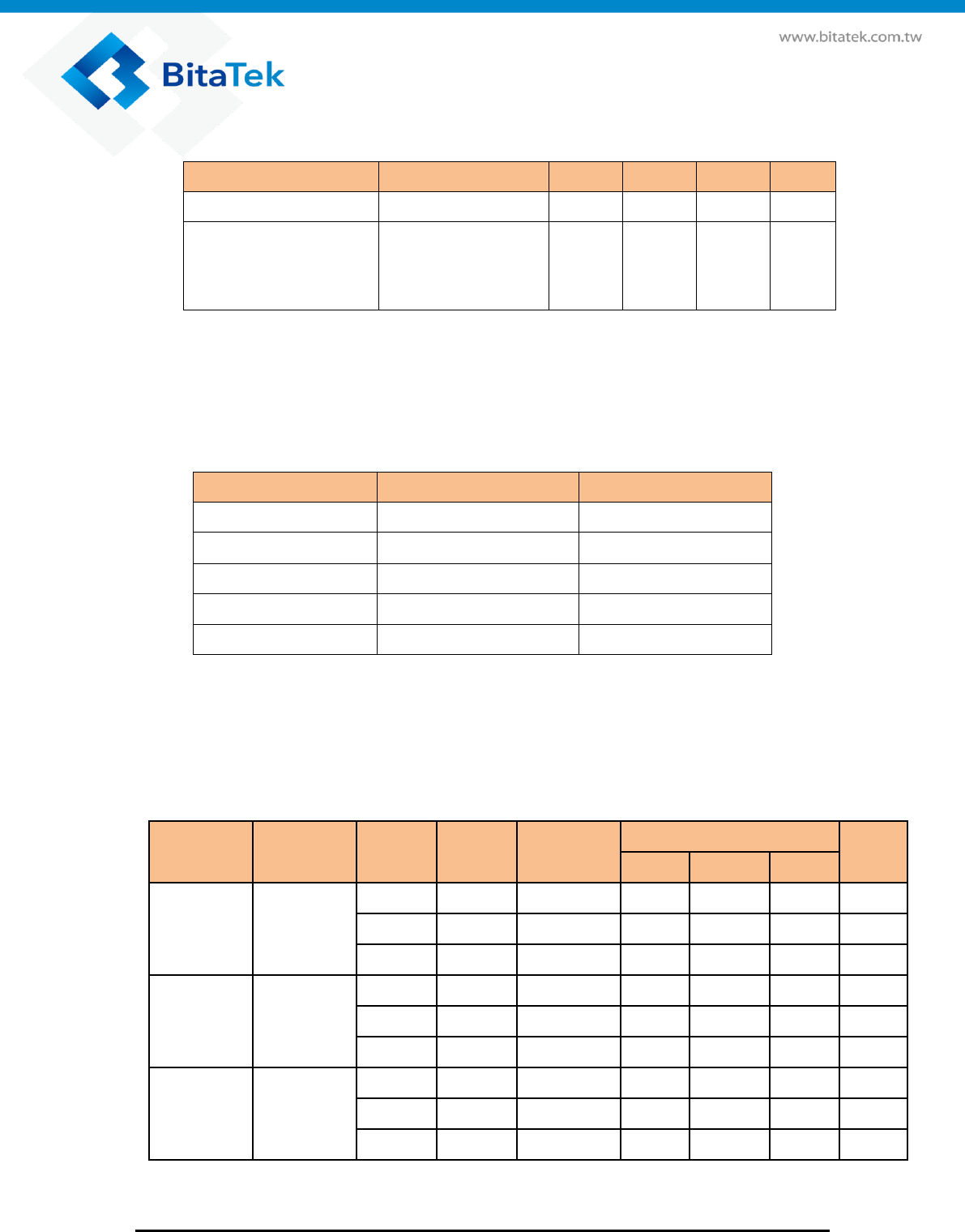
Page 40
BitaTek Co., Ltd. Copyright protected. All rights reserved.
NO. 115 Wugong 3rd Rd., Tel +886 2 2298 8588
Wugu Dist., New Taipei City 248, Taiwan (R.O.C.) Fax+886 2 2290 0029
3.5.11. System clock (BB_CLK)
Parameter
Comment
Min
Typ
Max
Units
Operating frequency
19.2
MHz
Output levels
Logic high (VOH)
Logic low (VOL)
1.17
-
-
-
-
0.63
V
V
3.5.12. RF Transmit and Receiver Specifications
RF Operation Frequency Band
Band
Min
Max
WIFI 2.4G
2412MHz
2472MHz
WiFi 5G
5180MHz
5825MHz
BT
2402MHz
2480MHz
GPS
1574.40MHz
1576.44MHz
Glonass
1598MHz
1606MHz
WIFI
Considering SAR regulatory, limit WiFi Tx power at certain level.
Parameter
Bandwidth
Mode
Rate
(Mbps)
Data Rate
2.4G
Unit
Min
Typical
Max
TX output
power level
HT20
11b
11
CCK-11
13
15
17
dBm
11g
54
OFDM-54
11
13
15
dBm
11n
65
MCS7
10
12
14
dBm
Constellation
Error (EVM)
HT20
11b
11
CCK-11
-
-18
-
dB
11g
54
OFDM-54
-
-24
-
dB
11n
65
MCS7
-
-26
-
dB
Sensitivity
HT20
11b
11
CCK-11
-
-89
-
dBm
11g
54
OFDM-54
-
-74
-
dBm
11n
65
MCS7
-
-70
-
dBm
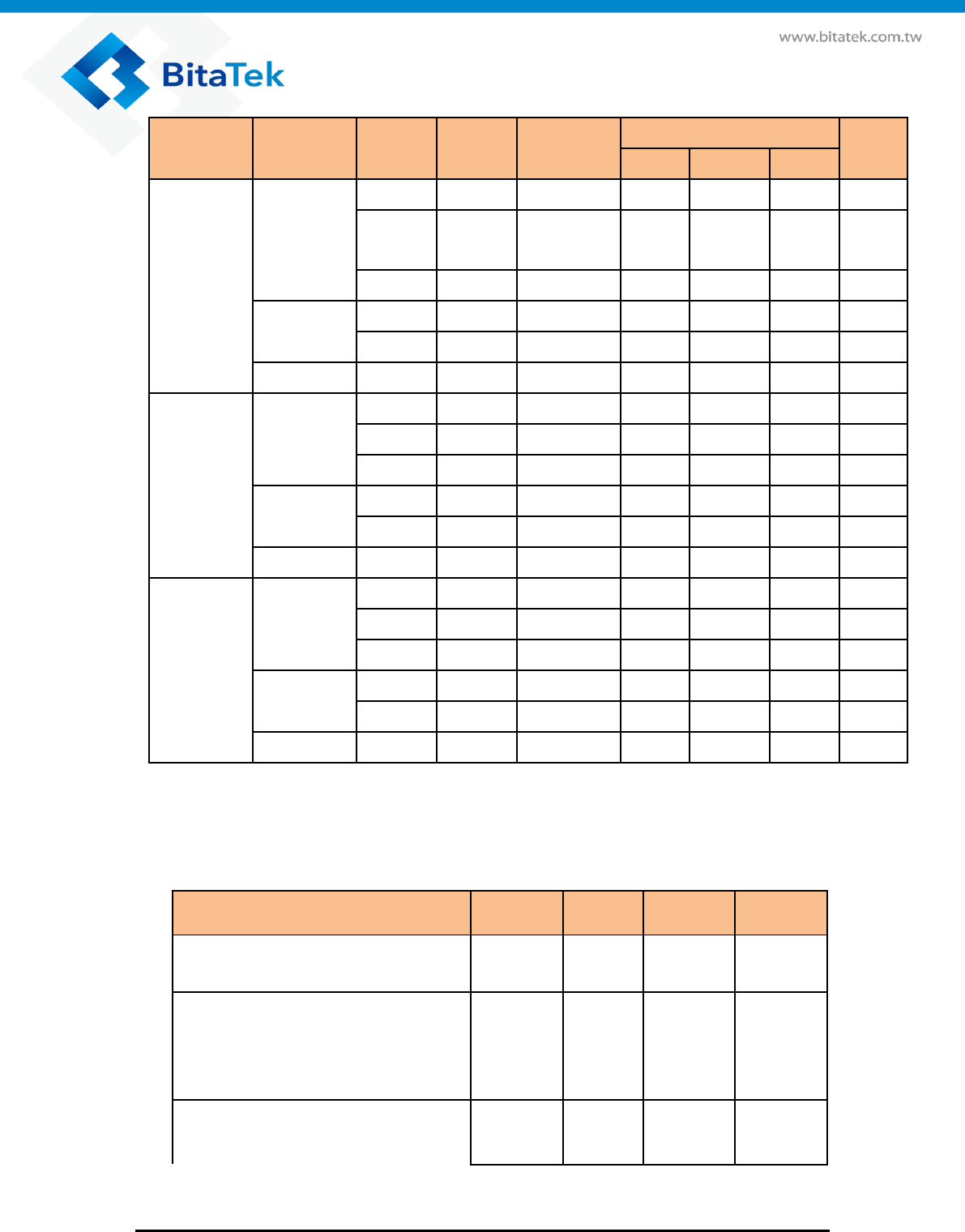
Page 41
BitaTek Co., Ltd. Copyright protected. All rights reserved.
NO. 115 Wugong 3rd Rd., Tel +886 2 2298 8588
Wugu Dist., New Taipei City 248, Taiwan (R.O.C.) Fax+886 2 2290 0029
Parameter
Bandwidth
Mode
Rate
(Mbps)
Data Rate
5G
Unit
Min
Typical
Max
HT20
11a
54
OFDM-54
13
15
17
dBm
TX output
power level
11n
65
MCS7
10
12
14
dBm
11ac
78
MAC8
10
12
14
dBm
HT40
11n
135
MCS7
10
12
14
dBm
11ac
180
MCS9
10
12
14
dBm
HT80
11ac
433
MCS9
9
11
13
dBm
Constellation
Error (EVM)
HT20
11a
54
OFDM-54
-
-24
-
dB
11n
65
MCS7
-
-25
-
dB
11ac
78
MCS8
-
-28
-
dB
HT40
11n
135
MCS7
-
-25
-
dB
11ac
180
MCS9
-
-28
-
dB
HT80
11ac
390
MCS9
-
-32
-
dB
Sensitivity
HT20
11a
54
OFDM-54
-
-70
-
dBm
11n
65
MCS7
-
-68
-
dBm
11ac
78
MCS8
-
-58
-
dBm
HT40
11n
135
MCS7
-
-58
-
dBm
11ac
180
MCS9
-
-53
-
dBm
HT80
11ac
380
MCS9
-
-51
-
dBm
Bluetooth
Parameters
Min
Typ
Max
Uint
RCV/CA/01/C (Single Sensitivity)
-
-87
-
dBm
RCV/CA/07/C (EDR Sensitivity)
-
-87
-
dBm
2Mbps Packet Length: 2-DH1
RCV/CA/07/C (EDR Sensitivity)
-
-87
-
dBm
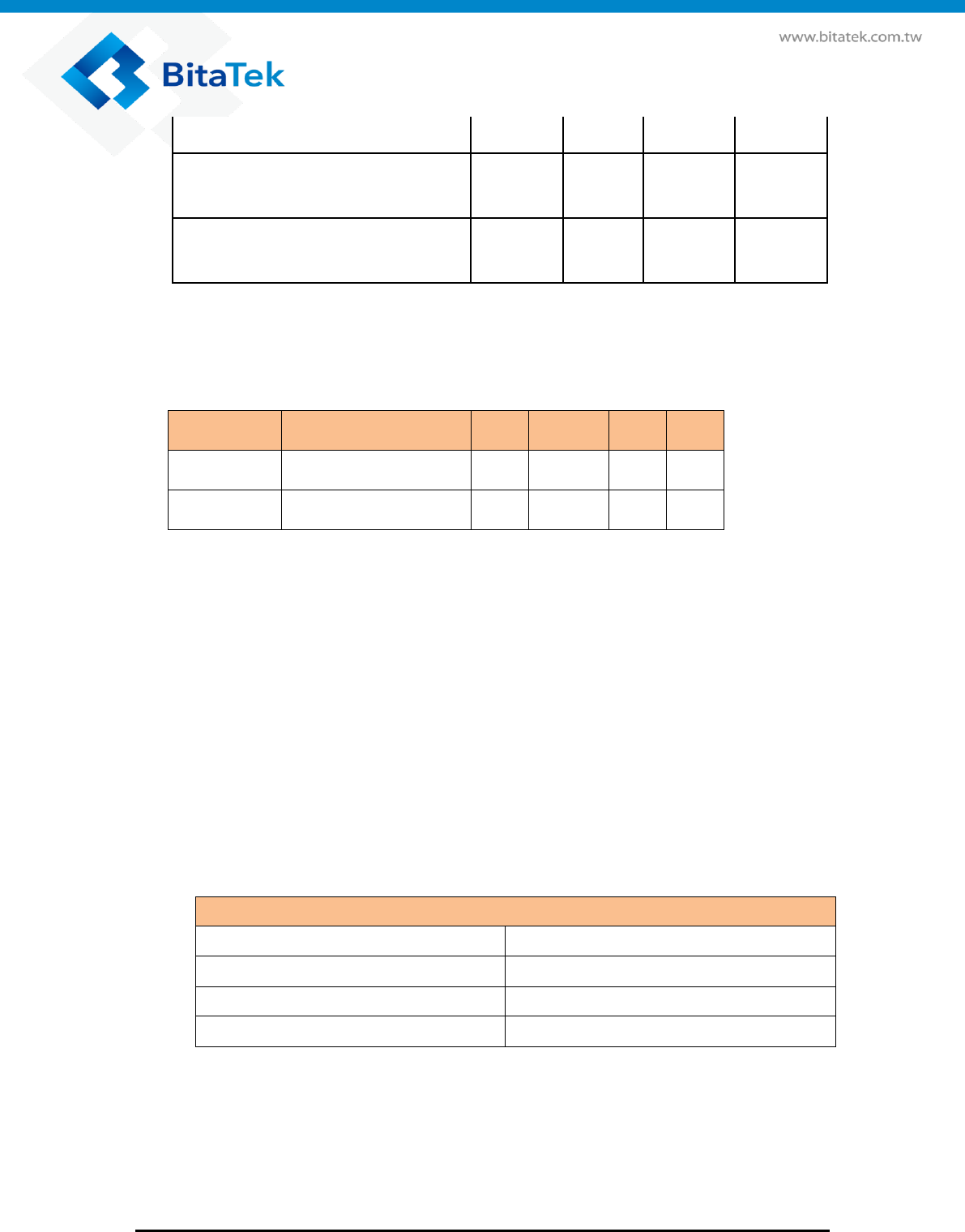
Page 42
BitaTek Co., Ltd. Copyright protected. All rights reserved.
NO. 115 Wugong 3rd Rd., Tel +886 2 2298 8588
Wugu Dist., New Taipei City 248, Taiwan (R.O.C.) Fax+886 2 2290 0029
3Mbps Packet Length: 3-DH1
TRM/CA/01/C Output power(class1)
0
8
12
dBm
TRM/CA/01/C Output power(class2)
-6
0
4
dBm
GPS
Test Items
Test condition
Min
Typical
Max
Unit
CN ration
Satellites@-130dBm
-
38
40
dBm
Sensitivity
-
-145
-
dBm
3.5.13. Electrostatic Discharge
The module is not protected against Electrostatic Discharge (ESD) in general.
Consequently, it is subject to ESD handling precautions that typically apply to ESD
sensitive components. Proper ESD handling and packaging procedures must be applied
throughout the processing, handling and operation of any application that incorporates a
FREY M1 module.
Electrostatic discharge (ESD) may lead to irreversible damage for the module. It is
therefore advisable to develop measures and methods to counter ESD and to use these to
control the electrostatic environment at manufacturing sites.
Specification
ANSI/ESDA/JEDEC JS-001-2011
± 1KV Human Body Model (HBM)
JESD22-A114-F
± 500V Charge Device Model (CDM)
EN301-489
± 4KV (Indirect discharge) *
± 8KV (Air discharge) **
Note * : Indirect discharge with coupling metal plane .
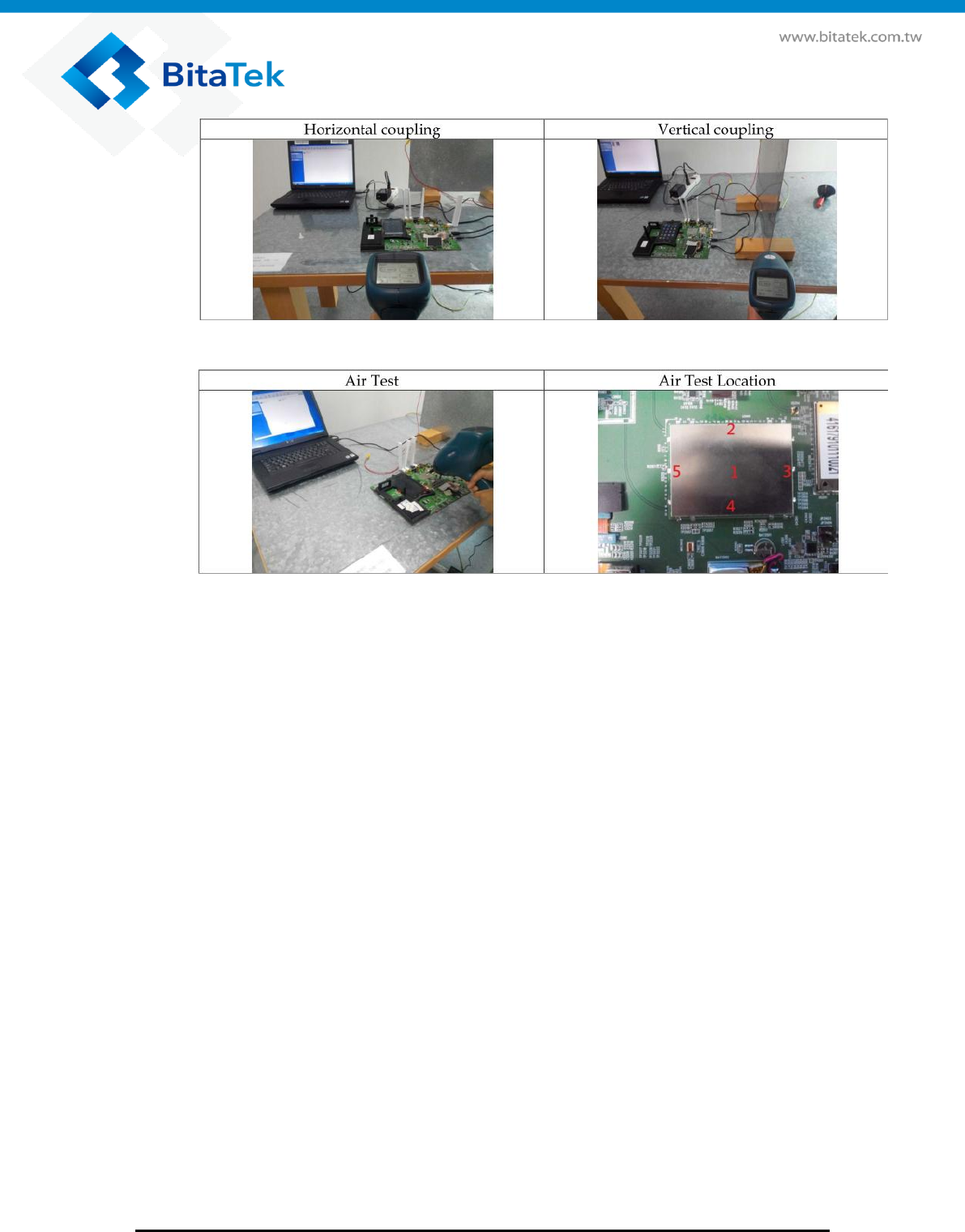
Page 43
BitaTek Co., Ltd. Copyright protected. All rights reserved.
NO. 115 Wugong 3rd Rd., Tel +886 2 2298 8588
Wugu Dist., New Taipei City 248, Taiwan (R.O.C.) Fax+886 2 2290 0029
Note ** : Air discharge on location 1,2,3,4,5 on module , module is mounted on EVB .

Page 44
BitaTek Co., Ltd. Copyright protected. All rights reserved.
NO. 115 Wugong 3rd Rd., Tel +886 2 2298 8588
Wugu Dist., New Taipei City 248, Taiwan (R.O.C.) Fax+886 2 2290 0029
Charpt 4. Module Mounting Issues
Frey M1 modules have been designed with an easy integration into SMT processes in mind.
Some module mounting issues are discussed in more detail in the sections below.
Please note that Frey M1 modules are specified for one soldering cycle only. Once removed
from the application, the module will very likely be destroyed and cannot be soldered onto
another application. Please also note that the modules are not sealed and should therefore
not be subjected to any post SMT wash or to any environments where condensation could
occur.
4.1. Solder Paste
A variety of solder paste types can be used to realize connections to external applications.
Soldering using lead free eutectic SnAgCu alloy can be done without any special restrictions,
because of its maximum allowed temperature of 245°C.
ENIG finish of the modules soldering pads ensures good wetting properties even after 12
month of storage.
However, there are some restrictions that should be noted before selecting the solder paste:
Due to the fact that the top side of the modules is assembled using standard eutectic SnAgCu
alloy, no higher melting alloys should be used (even though remelting of top side solder joints
also happens with eutectic SnAgCu).
Higher temperatures mean more stress to materials than lower temperatures: Increasing the
reflow temperature increases the growth of intermetallics, especially if the temperature lies
above the melting point of that alloy. Large intermetallics are commonly considered a
reliability risk. They should therefore be kept as small as possible.
4.2. Stencil Printing
4.2.1. General Stencil Considerations
The higher the stand off formed by the solder paste volume, the better the reliability for land
grid array (=LGA) based connections. The solder paste volume in a stencil printing process is
formed by aperture size (area) and stencil height:
VolumeSolder paste = AreaAperture x HeightStencil

Page 45
BitaTek Co., Ltd. Copyright protected. All rights reserved.
NO. 115 Wugong 3rd Rd., Tel +886 2 2298 8588
Wugu Dist., New Taipei City 248, Taiwan (R.O.C.) Fax+886 2 2290 0029
It is recommended that customers do their own testing to determine the optimal solder paste
volume. This volume can be applied by stencil printing with different stencil heights to fit your
existing assembly needs. The volume is kept constant by varying the aperture size
accordingly.
The most common thicknesses 110μm and 150μm (stainless steel, laser cut) have been
tested with good results with regard to printing process, soldering process and reliability
testing. Similar results are expected with stencil thicknesses in between.
Different solder paste volumes have been tested too but with much lower volume there is a
trend to poor solder joints and a risk for open joints. Much larger solder joints tend to form
solder balling in the vicinity of the solder joints.
4.2.2. Used Parameters and Recommendations
For stencil printing, a stainless steel stencil, laser cut (or similar technology) should be used.
Parameters must be optimized depending on actual application board design, equipment und
solder paste.
To simulate different applications, two different stencil thicknesses of 110μm and 150μm
were used while keeping the solder paste volume constant by variation of the apertures.
If the results for all tested versions were found to be good. For exact pad and aperture
dimensions, as well as module geometry and footprint design
4.2.3. Pick and Place
FREY M1 well be put into the antistatic tray plate. One antistatic tray plate will have 15 Frey
M1 modules, and one moisture barrier bag will have max 5 antistatic tray plates
4.2.4. Reflow Profile
Short profiles are recommended for reflow soldering processes in order to prevent top side
solder joints from growing large intermetallic compounds. Peak zone temperature should be
adjusted high enough to ensure proper wetting and optimized forming of solder joints. On the
other hand, a plateau during preheating can help to reduce voiding behavior. Generally
speaking, unnecessary long exposure and exposure to more than 245°C should be avoided.

Page 46
BitaTek Co., Ltd. Copyright protected. All rights reserved.
NO. 115 Wugong 3rd Rd., Tel +886 2 2298 8588
Wugu Dist., New Taipei City 248, Taiwan (R.O.C.) Fax+886 2 2290 0029
As an example and during Frey M1 internal tests, forced convection machines were able to
realize a good reflow soldering profile, so there was no need for using vapor phase
equipment.
For analyzing and adapting solder profiles a carrier board was prepared with thermocouples
(TC) .
In order to get a good overall performance the resulting voiding and the formation of
intermetallics as well as other thermal induced degradations must be well balanced. As
mentioned above a longer preheating phase can help gasses to escape from solder joints
before solidification. To not overstress the assembly, the complete reflow profile should be as
short as possible.
Here an optimization considering all components on the application must be performed. The
optimization of a reflow profile is a gradual process. It needs to be performed for every paste,
equipment and product combination. The presented profiles are only samples and valid for the
used pastes, reflow machines and test application boards. Therefore a "ready to use" reflow
profile can not be given.
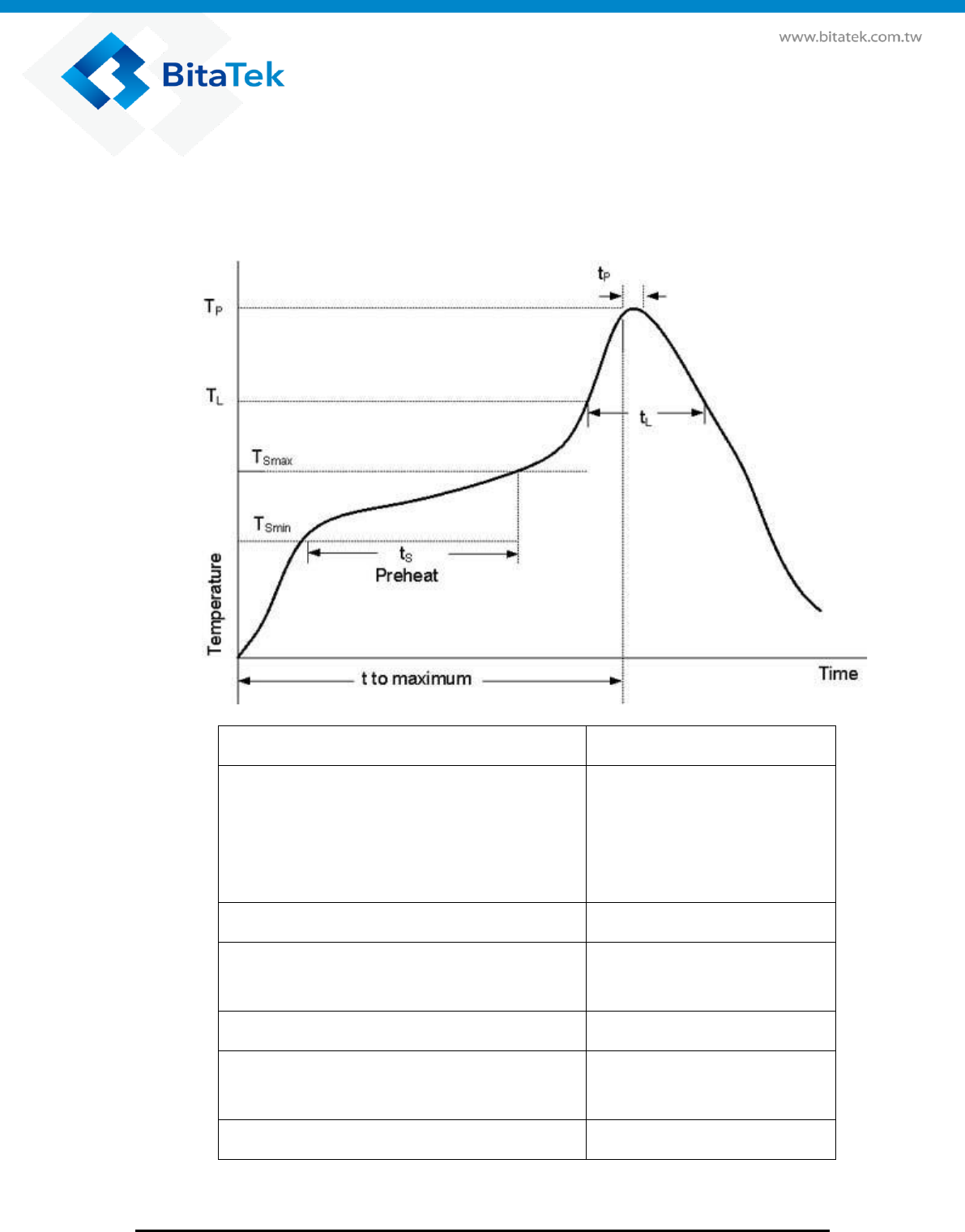
Page 47
BitaTek Co., Ltd. Copyright protected. All rights reserved.
NO. 115 Wugong 3rd Rd., Tel +886 2 2298 8588
Wugu Dist., New Taipei City 248, Taiwan (R.O.C.) Fax+886 2 2290 0029
4.3. Soldering Conditions and Temperature
4.3.1. Reflow Profile
Profile Feature
Pb-Free Assembly
Preheat & Soak
Temperature Minimum (Tsmin)
Temperature Maximum (Tsmax)
Time (Tsmin to Tsmax) (tS)
150°C
200°C
60-120 seconds
Average ramp up rate (Tsmax to Tp)
3K/second max.
Liquidous temperature (TL)
Time at liquidous (tL)
217°C
60-90 seconds
Peak package body temperature (Tp)
245°C +0/-5°C
Time (tP) within 5 °C of the peak package body
temperature (TP)
30 seconds max.
Average ramp-down rate (TP to TSmax)
3 K/second max.

Page 48
BitaTek Co., Ltd. Copyright protected. All rights reserved.
NO. 115 Wugong 3rd Rd., Tel +886 2 2298 8588
Wugu Dist., New Taipei City 248, Taiwan (R.O.C.) Fax+886 2 2290 0029
Time 25°C to maximum temperature
8 minutes max.
4.3.2. Maximum Temperature and Duration
The following limits are recommended for the SMT board-level soldering process to attach
the module:
• A maximum module temperature of 245°C. This specifies the temperature as
measured at the module’s top side.
• A maximum duration of 30 seconds at this temperature.
Please note that while the solder paste manufacturers' recommendations for best
temperature and duration for solder reflow should generally be followed, the limits listed
above must not be exceeded.
Frey M1 is specified for one soldering cycle only. Once Frey M1 is removed from the
application, the module will very likely be destroyed and cannot be soldered onto another
application.
4.4. Soldering Process Evaluation
4.4.1. Visual Inspection
As a rule, automated optical inspection (AOI) of solder joints is not suitable for evaluating LGA
modules, because most of the I/O pins are hidden underneath the module. Inspection of the
outermost I/Os is not sufficient to evaluate soldering. Please reference IPC-A-610 standard.
4.4.2. X-Ray Inspection and Void Content
X-Ray inspection is an appropriate method for evaluating solder joints after reflow. X-Ray
images can show wetting problems, missing solder volume or of course bridging.
X-Ray inspection is made somehow more difficult by overlaying module components and by
possible bottom side (application) assemblies. However, module connections are
characterized by their shape and size, so in most cases they can easily be distinguished from
the mentioned overlaying structures.
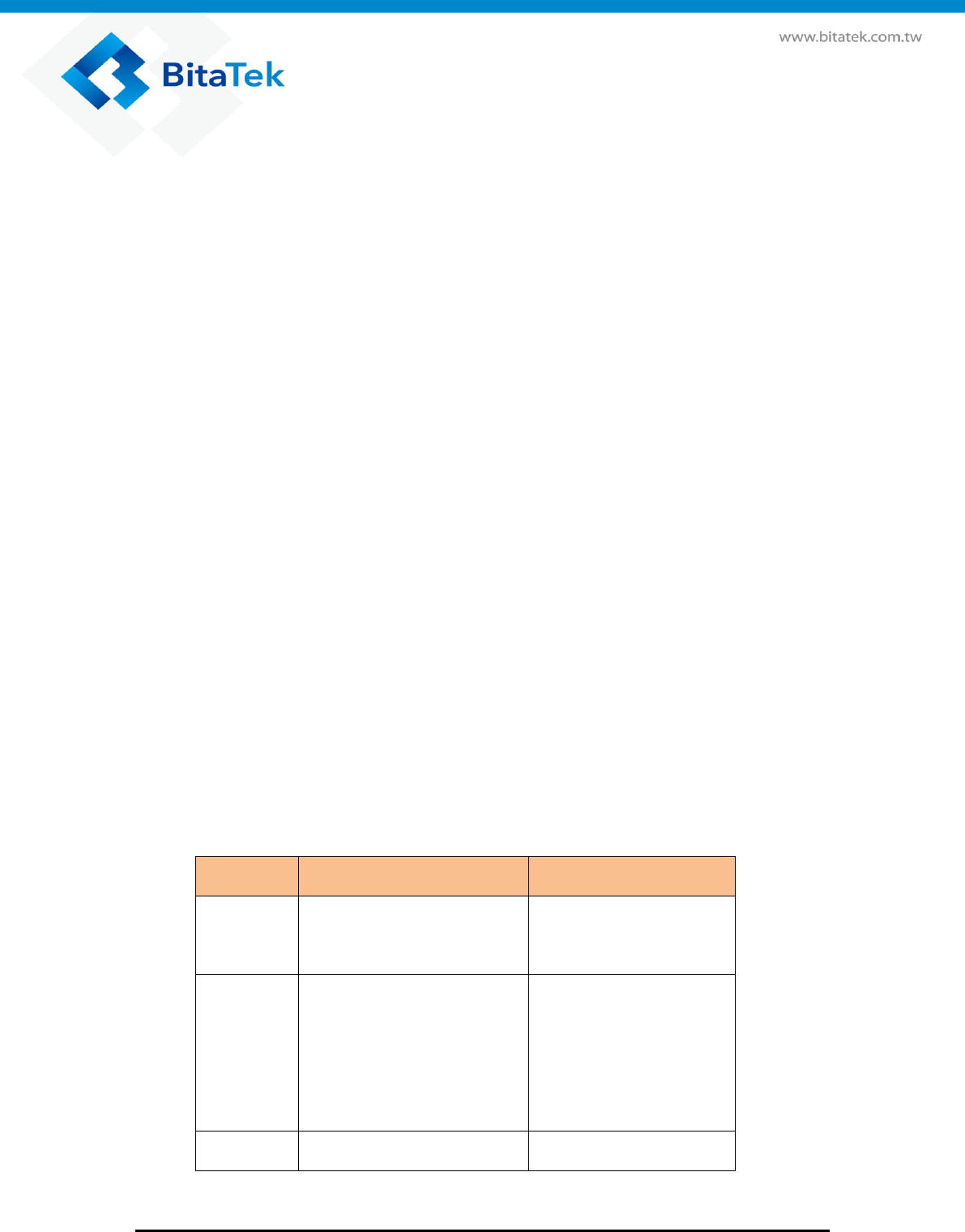
Page 49
BitaTek Co., Ltd. Copyright protected. All rights reserved.
NO. 115 Wugong 3rd Rd., Tel +886 2 2298 8588
Wugu Dist., New Taipei City 248, Taiwan (R.O.C.) Fax+886 2 2290 0029
The set shows typical X-Ray images of sample modules soldered to an assumed application
board including some failure samples. The images are taken from assembly and BLR testing
and comprise two different stencil versions (110μm and 150μm thickness).
A good solder joint at Frey M1 signal pins in X-Ray inspection is characterized by a
rectangular shape, described by the dimensions of the pad at the module.
Solder joints which have a round footprint in X-Ray image are found in areas with high stand
off and are more column like instead of flat. These are good from electrical point of view but
indicate processing problems like aslope standing of the module or warpage.
It is recommended to use X-Ray to determine level of voiding. Entrapments of gases can
often not be completely avoided, if large flat solder joints are used. Currently there are no
standards available defining limits for void content. The available IPC610 standard for ball
grid arrays (=BGA) must not be applied to LGAs and hence to the Frey M1 SMT modules.
As seen from the X-Ray images above there is no significant difference in reflow result for the
110μm and 150μm stencils. This is mainly due to the fact, that the resulting volume was kept
constant by varying the apertures accordingly. The resulting shape of the solder joint is only
influenced by the volume.
Only if solder paste spreading is limited, which can occur with lead free solder on Cu-OSP or
immersion tin PCB surfaces, a little difference in solder joint shape can be expected but with
no effect on quality or yield. This is a characteristic of lead free solders and not a wetting
issue.
4.5. Board Level Reliability Investigation
The board level reliability tests described as follow table
Item No
Test case
International standard
1
Storage Test
IEC60068-2-1
IEC60068-2-2
2
Thermal Cycle
IEC60068-2-3
IEC60068-2-56
IEC60068-2-38
IEC60068-2-30
3
Thermal Stress
IEC60068-2-3

Page 50
BitaTek Co., Ltd. Copyright protected. All rights reserved.
NO. 115 Wugong 3rd Rd., Tel +886 2 2298 8588
Wugu Dist., New Taipei City 248, Taiwan (R.O.C.) Fax+886 2 2290 0029
IEC60068-2-56
IEC60068-2-38
IEC60068-2-30
4
Thermal Shock
IEC60068-2-14
5
Vibration
IEC60068-2-6
IEC60068-2-59
6
Mechanical Shock
IEC60068-2-27
7
Micro Drop
IEC60068-2-32
8
ESD
IEC61000-4-2
9
Low temperature start test
IEC60068-2-1
10
High temperature start test
IEC60068-2-2
4.6. Desoldering Process
In case of persisting module issues, the module may be desoldered from the application
board. Desoldering however should only be the final means of diagnosis after all other
possible electrical on-board tests using the implemented test points were not successful.
The desoldering process is very similar to the employed soldering process, meaning that it is
quite specific for any type of external application.
The intention of desoldering is to provide a possibility to employ the standard RMA process.
Even if a further usage of the application board cannot be guaranteed (because of the
potential impact on neighboring components throughout the desoldering process), a high
reuse probability is expected, if the desoldering process is done in a professional manner.
There are a various types of desoldering machines available. The choice of a desoldering
machine (e.g., a Martin machine) strongly depends on the layout of the external application
board, the size and position of other components close to the module have an impact on the
temperature profile and type of heating.

Page 51
BitaTek Co., Ltd. Copyright protected. All rights reserved.
NO. 115 Wugong 3rd Rd., Tel +886 2 2298 8588
Wugu Dist., New Taipei City 248, Taiwan (R.O.C.) Fax+886 2 2290 0029
4.6.1. Preparation of LGA Module
It is recommended to use a vacuum lift system to pick up the desoldered module from the
application board. To secure a fixed connection between module shielding and module PCB,
additional glue points have to be provided.
4.6.2. Baking of Application Board
For a reliable desoldering process the moisture level has to taken into account. As known
from the soldering process, the moisture has to be limited to a certain level to avoid any
damages to components. Therefore, the complete application board including the module will
have to be baked before the desoldering process begins.
4.6.3. Removal of LGA Module
After preparation (glueing, baking) the module can be desoldered from the application board.
The desoldering temperature profile has to be selected that fits to the application and module
requirements (e.g., used solder paste, soldered components, PCBs). As recommended for
the LGA modules’ soldering process, the temperature profile should not exceed a
temperature of 245°C
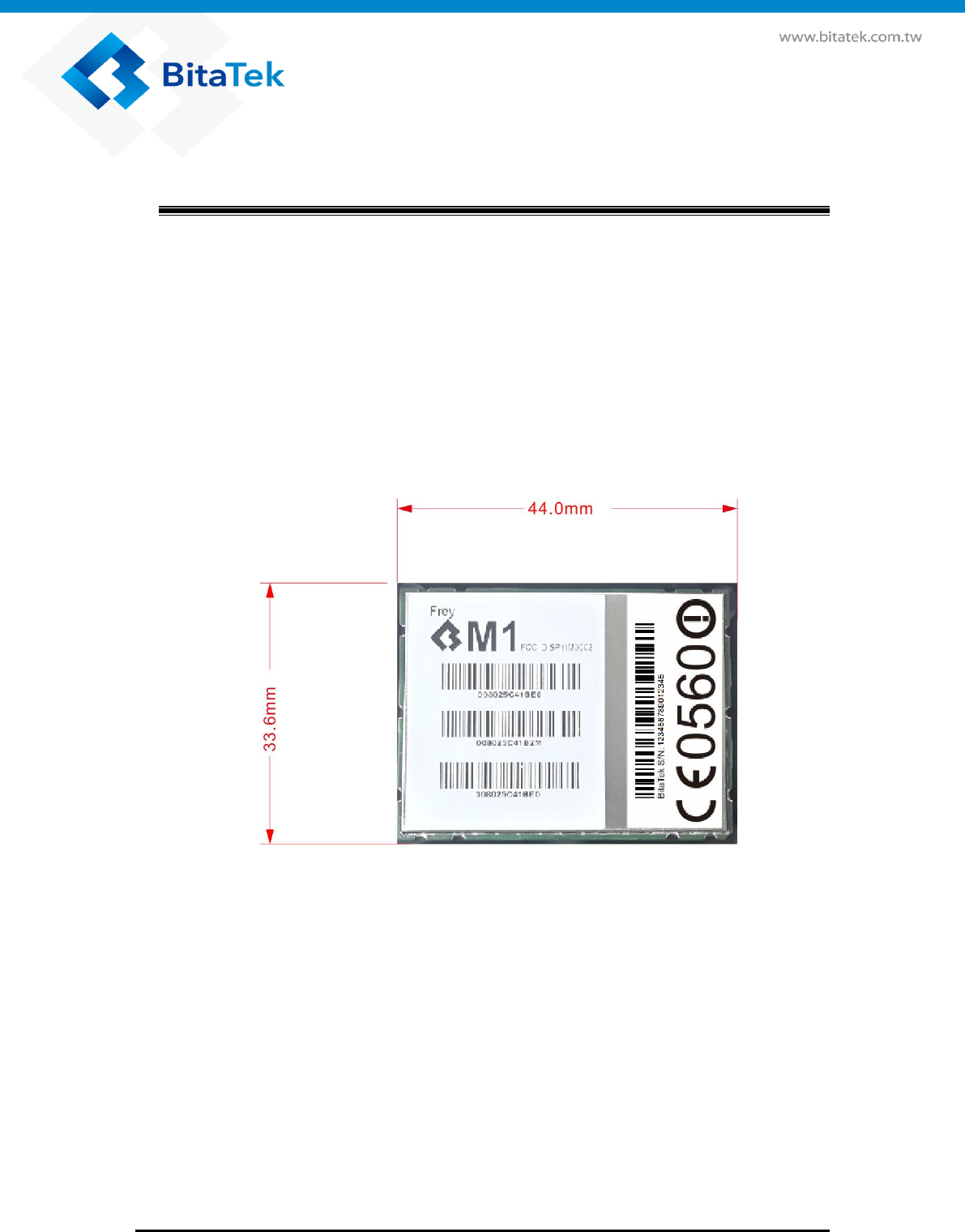
Page 52
BitaTek Co., Ltd. Copyright protected. All rights reserved.
NO. 115 Wugong 3rd Rd., Tel +886 2 2298 8588
Wugu Dist., New Taipei City 248, Taiwan (R.O.C.) Fax+886 2 2290 0029
Charpt 5. Packaging
5.1. Mechanical Dimensions of Frey M1
Length: 44mm
Width: 33.6mm
Height: 2.7mm
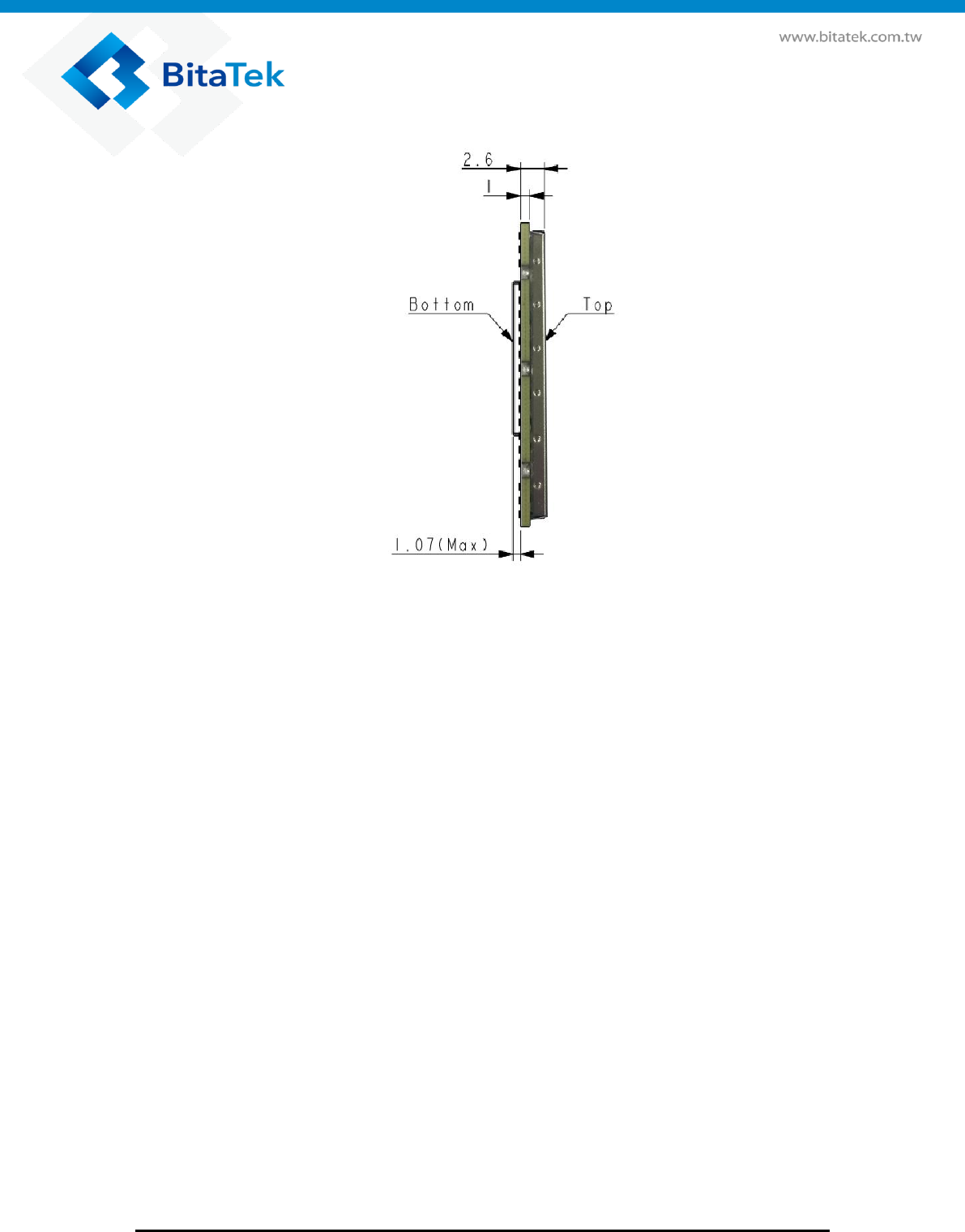
Page 53
BitaTek Co., Ltd. Copyright protected. All rights reserved.
NO. 115 Wugong 3rd Rd., Tel +886 2 2298 8588
Wugu Dist., New Taipei City 248, Taiwan (R.O.C.) Fax+886 2 2290 0029
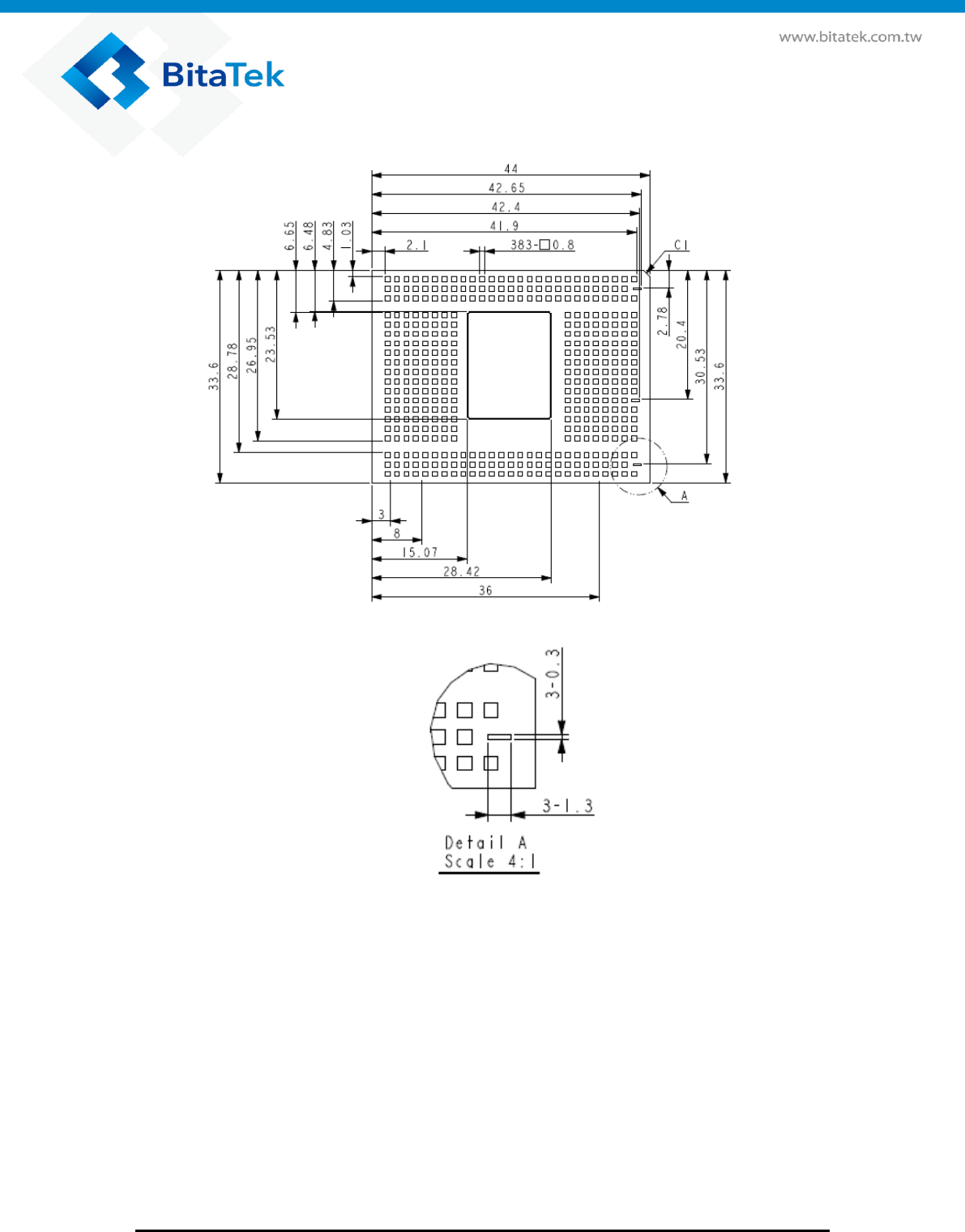
Page 54
BitaTek Co., Ltd. Copyright protected. All rights reserved.
NO. 115 Wugong 3rd Rd., Tel +886 2 2298 8588
Wugu Dist., New Taipei City 248, Taiwan (R.O.C.) Fax+886 2 2290 0029
Bottom
5.2. Shipping Materials
FREY M1 is described below, including the following required shipping materials:
• Moisture barrier bag, including desiccant and humidity indicator card.
FREY M1 well be put into the antistatic tray plate. One antistatic tray plate will have 15 Frey M1
modules, and one moisture barrier bag will have max 5 antistatic tray plates.
The material of tray plate is styrene-butadiene Copolymer(CAS NO. 9003-55-8), the operation
temperature range please refence CAS NO 9003-55-8.
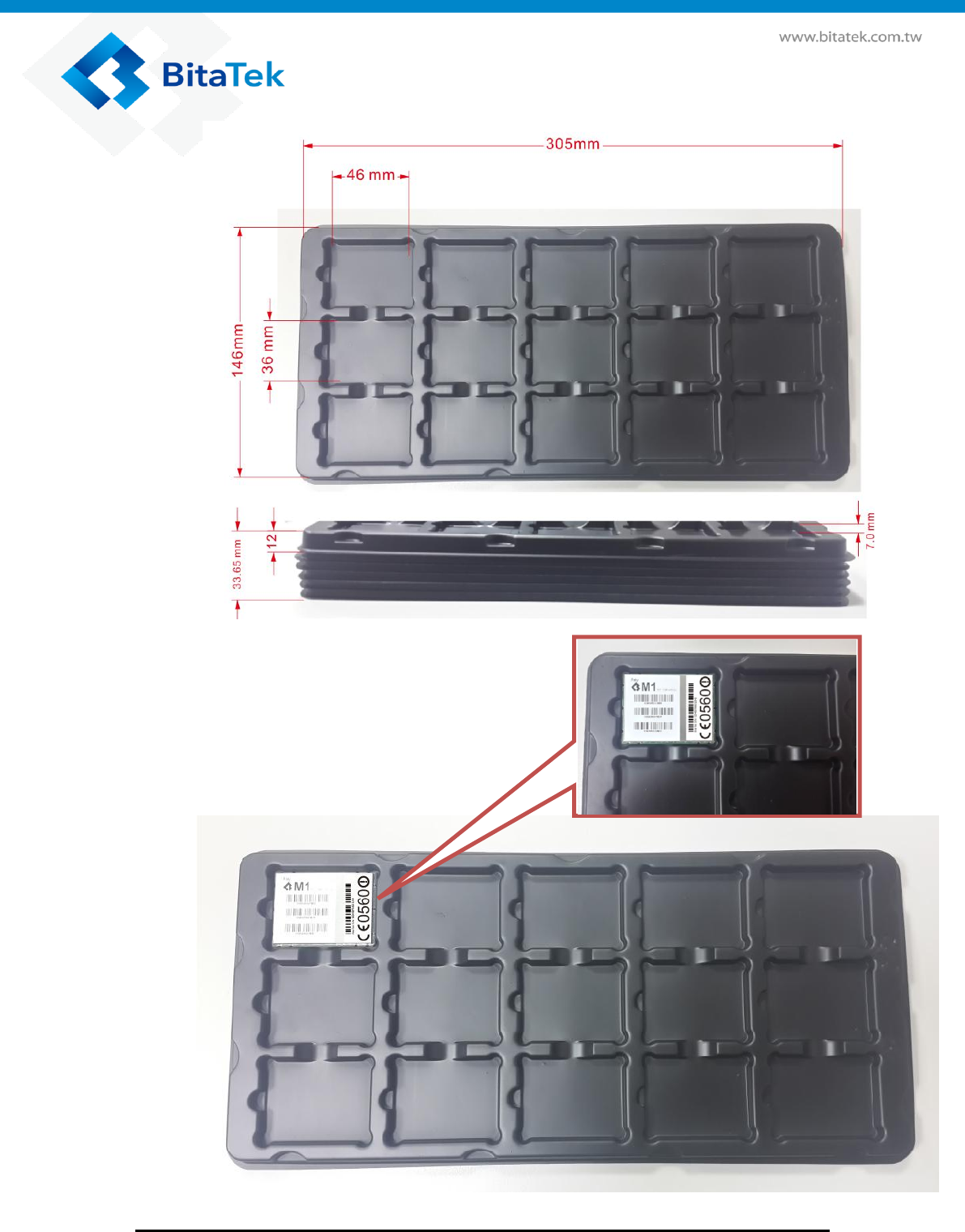
Page 55
BitaTek Co., Ltd. Copyright protected. All rights reserved.
NO. 115 Wugong 3rd Rd., Tel +886 2 2298 8588
Wugu Dist., New Taipei City 248, Taiwan (R.O.C.) Fax+886 2 2290 0029
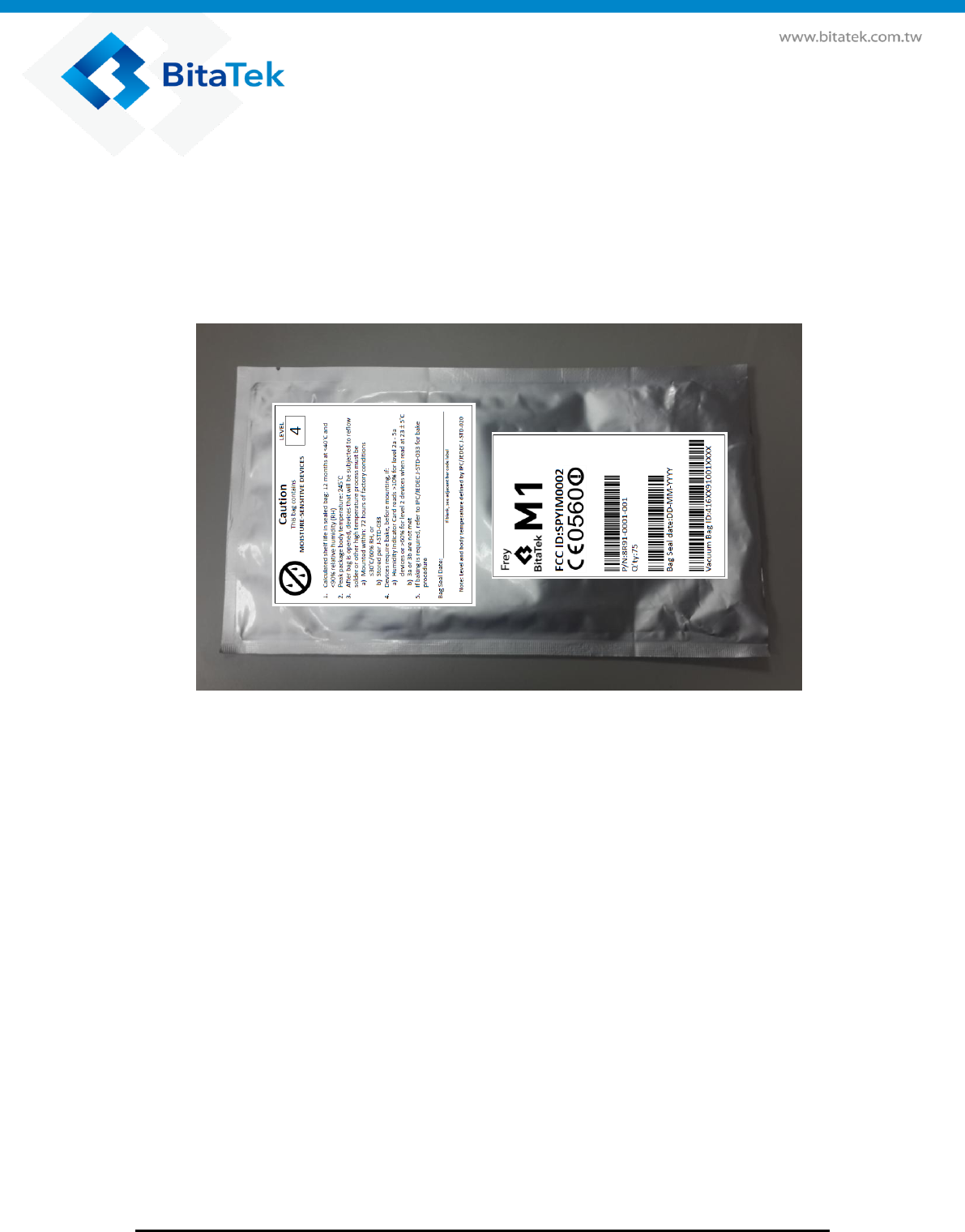
Page 56
BitaTek Co., Ltd. Copyright protected. All rights reserved.
NO. 115 Wugong 3rd Rd., Tel +886 2 2298 8588
Wugu Dist., New Taipei City 248, Taiwan (R.O.C.) Fax+886 2 2290 0029
5.2.1. Moisture Barrier Bag
Those are stored inside a moisture barrier bag, The bag is ESD protected and delimits
moisture transmission. It is vacuum-sealed and should be handled carefully to avoid
puncturing or tearing. The bag protects the Frey M1 modules from moisture exposure. It
should not be opened until the devices are ready to be soldered onto the application.
The moisture barrier bag size : 420 x 240 MM
The moisture barrier bag thickness : 0.15MM
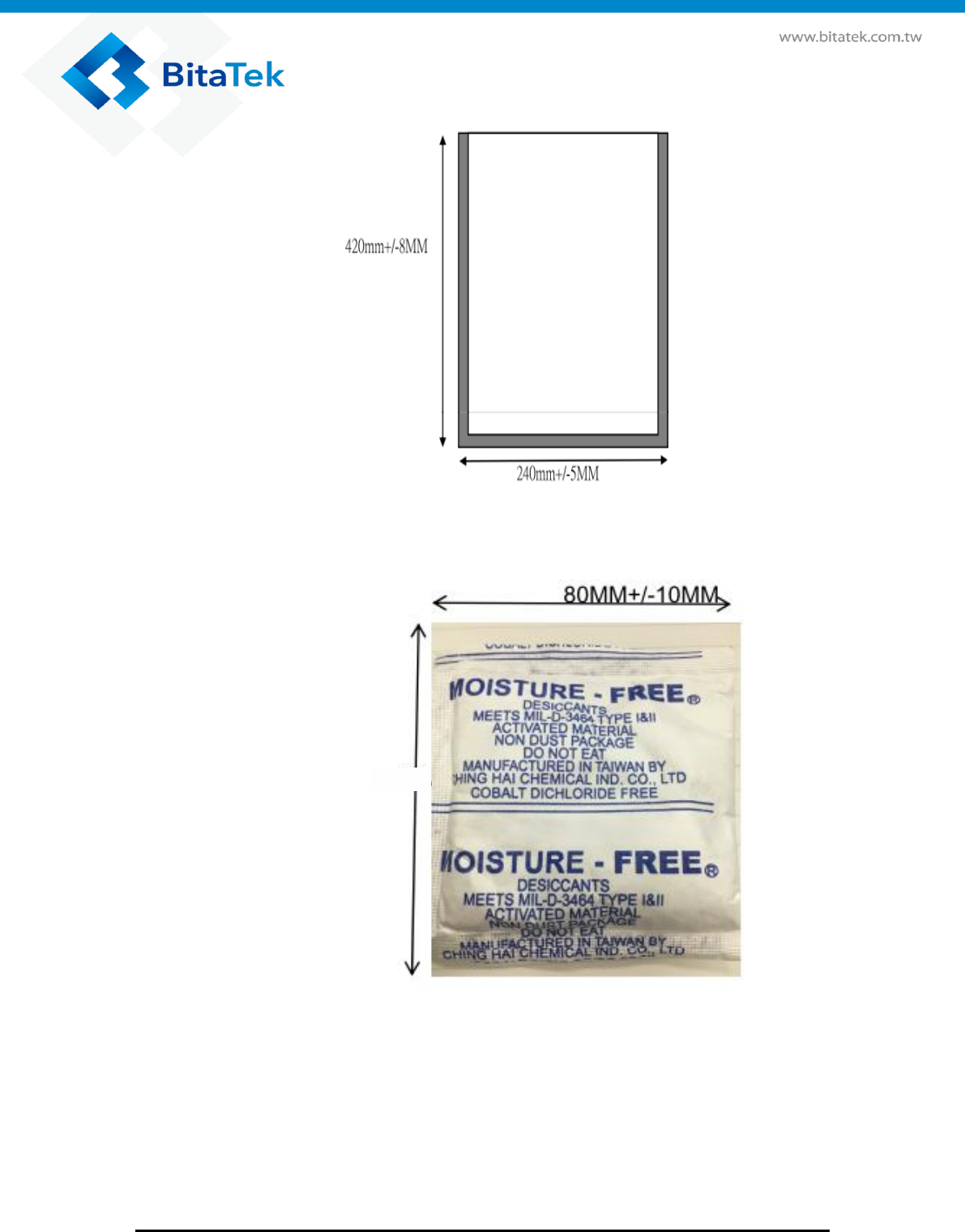
Page 57
BitaTek Co., Ltd. Copyright protected. All rights reserved.
NO. 115 Wugong 3rd Rd., Tel +886 2 2298 8588
Wugu Dist., New Taipei City 248, Taiwan (R.O.C.) Fax+886 2 2290 0029
Desiccant size :
90MM+/-10MM
The moisture barrier bag s contain one or more desiccant pouches to absorb moisture that
may be in the bag. The humidity indicator card described below should be used to
determine whether the enclosed components have absorbed an excessive amount of
moisture.
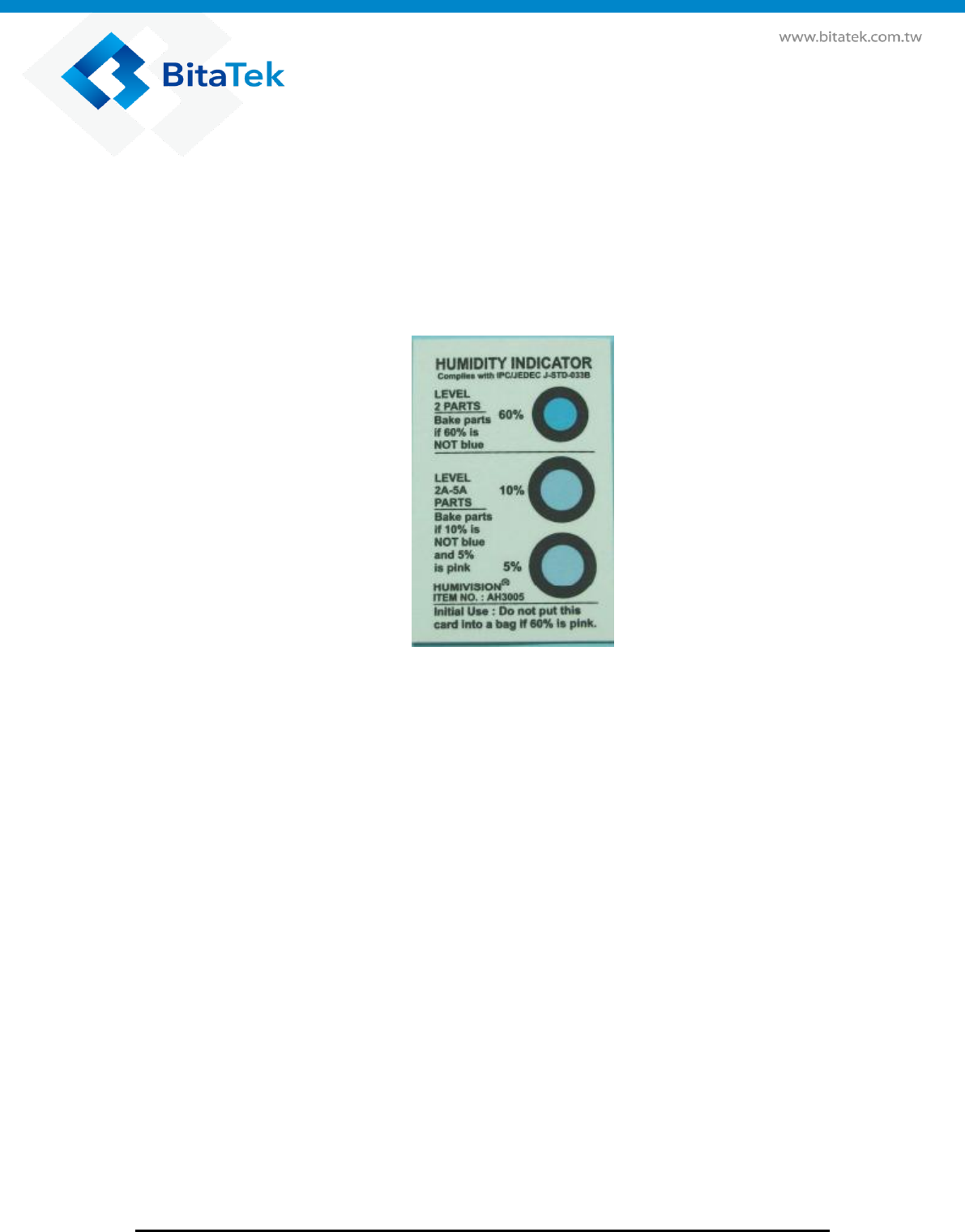
Page 58
BitaTek Co., Ltd. Copyright protected. All rights reserved.
NO. 115 Wugong 3rd Rd., Tel +886 2 2298 8588
Wugu Dist., New Taipei City 248, Taiwan (R.O.C.) Fax+886 2 2290 0029
The desiccant pouches should not be baked or reused once removed from the moisture
barrier bag.
The humidity indicator card is a moisture indicator and is included in the moisture barrier
bag to show the approximate relative humidity level within the bag. A sample humidity card
is shown in follow Figure. If the components have been exposed to moisture above the
recommended limits, the units will have to be rebaked.
5.3. Packing Label
The label shown in summarizes requirements regarding moisture sensitivity, including shelf
life and baking requirements. It is attached to the outside of the moisture barrier bag.
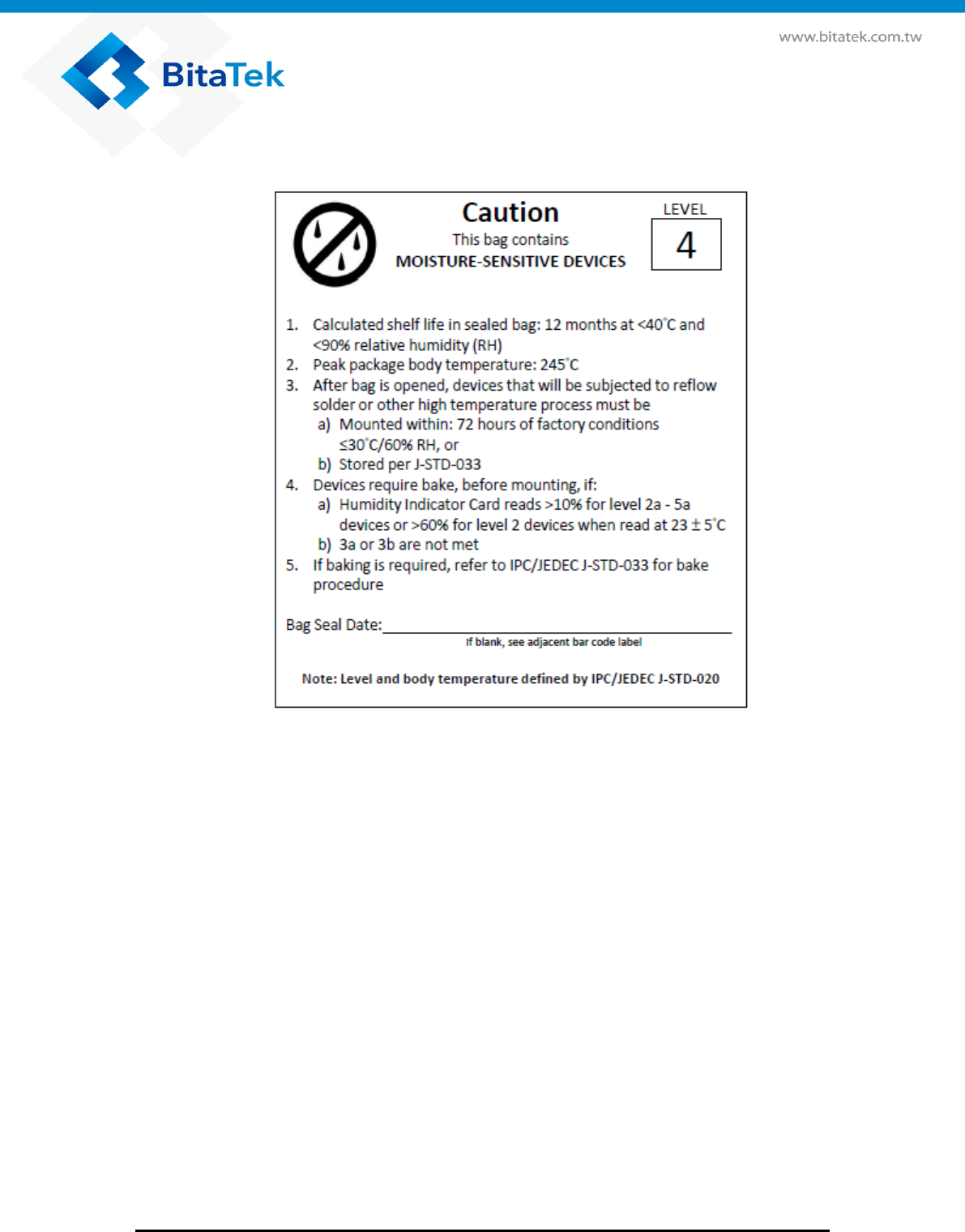
Page 59
BitaTek Co., Ltd. Copyright protected. All rights reserved.
NO. 115 Wugong 3rd Rd., Tel +886 2 2298 8588
Wugu Dist., New Taipei City 248, Taiwan (R.O.C.) Fax+886 2 2290 0029
Caution label
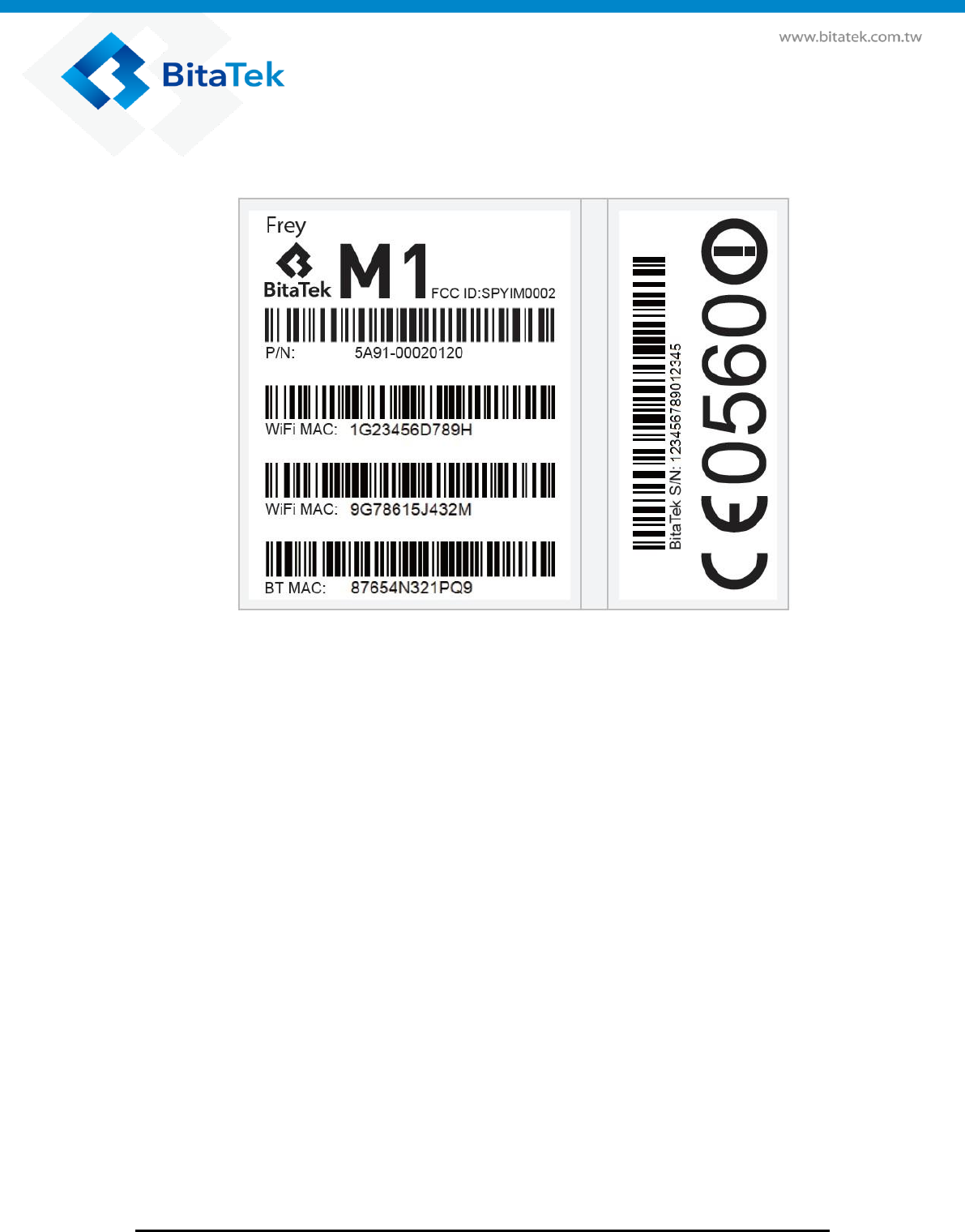
Page 60
BitaTek Co., Ltd. Copyright protected. All rights reserved.
NO. 115 Wugong 3rd Rd., Tel +886 2 2298 8588
Wugu Dist., New Taipei City 248, Taiwan (R.O.C.) Fax+886 2 2290 0029
Module label : this label will on the top site of Frey M1.
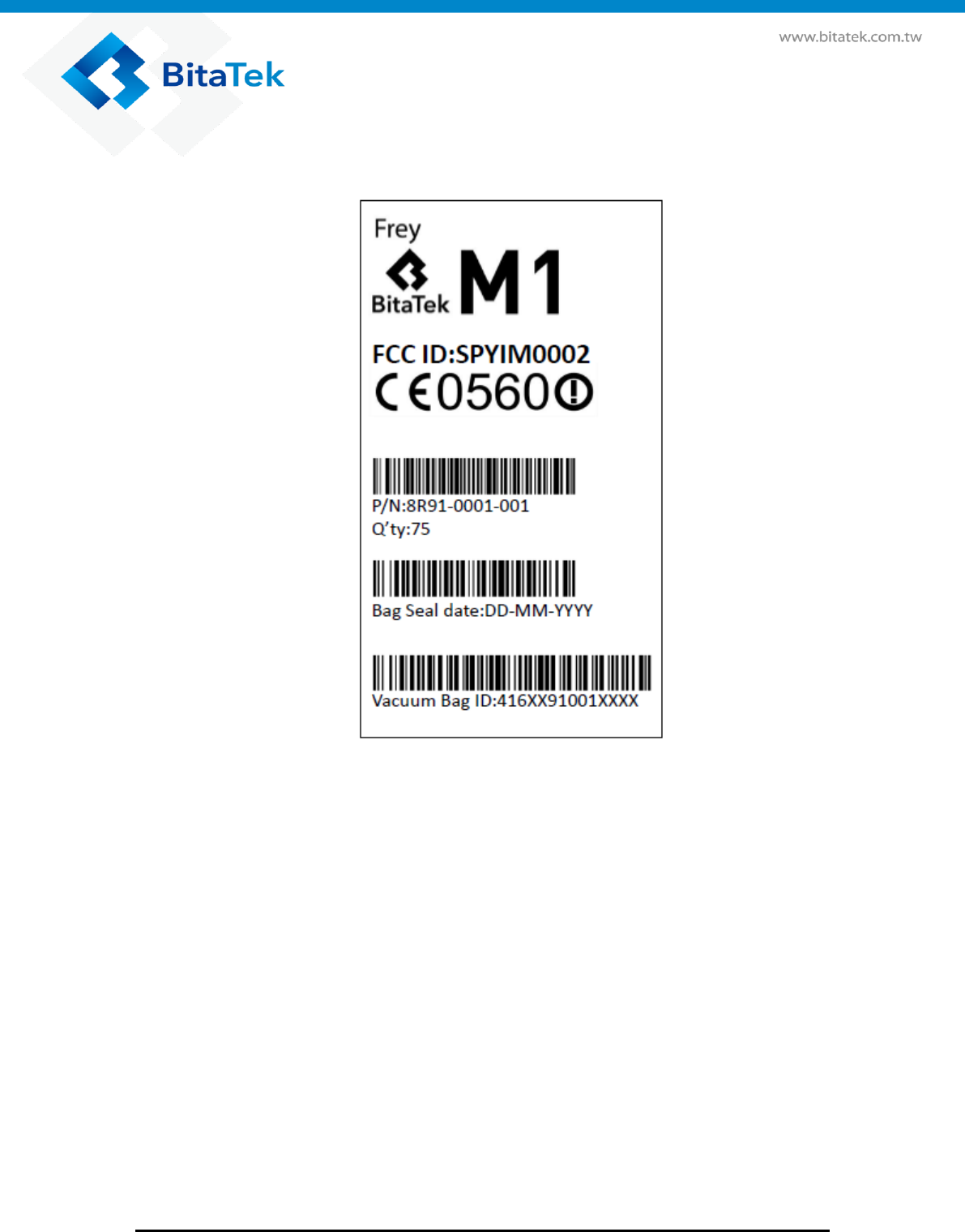
Page 61
BitaTek Co., Ltd. Copyright protected. All rights reserved.
NO. 115 Wugong 3rd Rd., Tel +886 2 2298 8588
Wugu Dist., New Taipei City 248, Taiwan (R.O.C.) Fax+886 2 2290 0029
Vacuum bag label : It is attached to the outside of the moisture barrier bag.
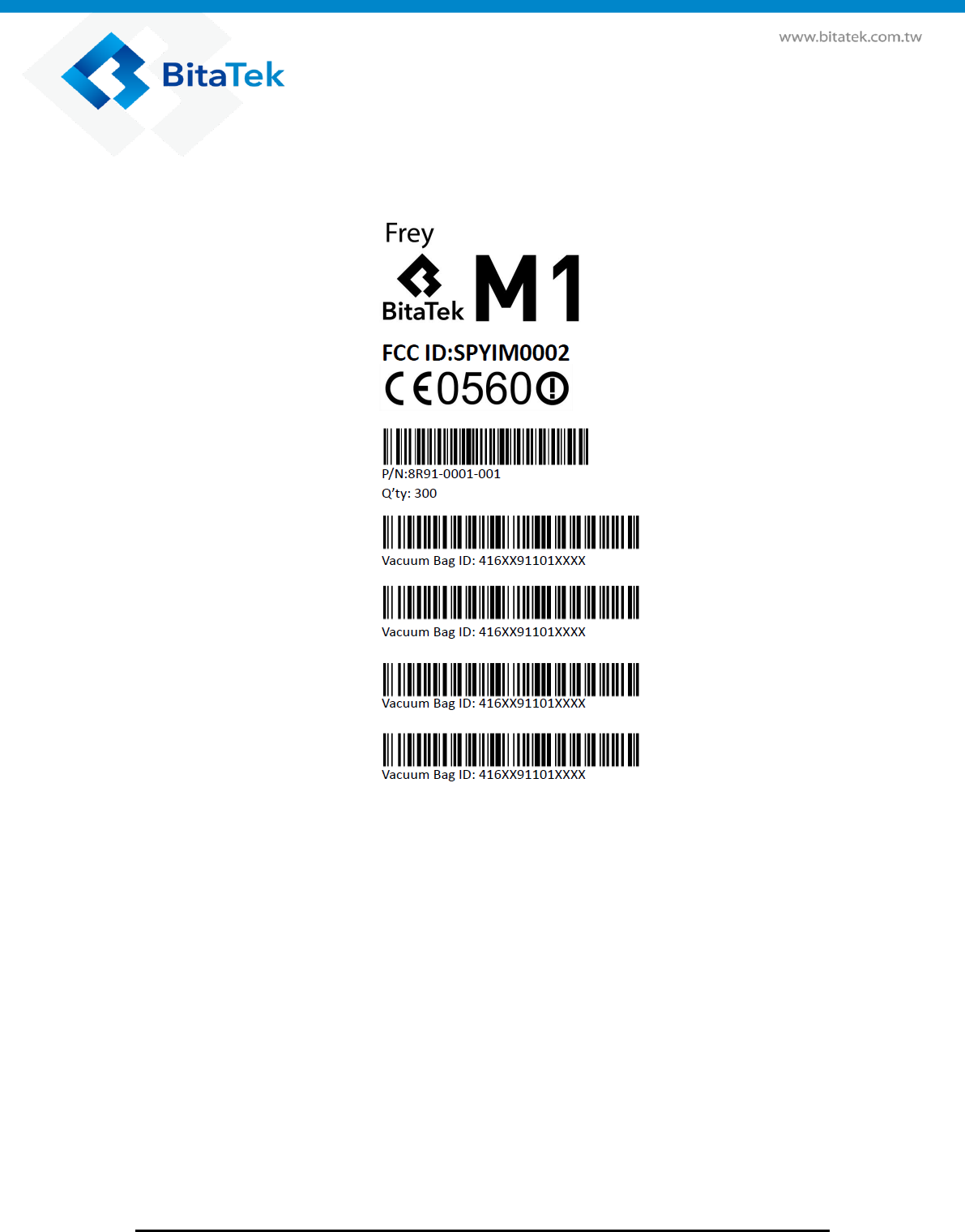
Page 62
BitaTek Co., Ltd. Copyright protected. All rights reserved.
NO. 115 Wugong 3rd Rd., Tel +886 2 2298 8588
Wugu Dist., New Taipei City 248, Taiwan (R.O.C.) Fax+886 2 2290 0029
Carton label : It is attached to the outside of the carton
5.4. Storage Conditions
The conditions stated below are only valid for modules in their original packed state in
weather protected, non-temperature-controlled storage locations. Normal storage time
under these conditions is 12 months maximum. The modules will be delivered in a
packaging that meets the requirements Low Temperature Carriers.

Page 63
BitaTek Co., Ltd. Copyright protected. All rights reserved.
NO. 115 Wugong 3rd Rd., Tel +886 2 2298 8588
Wugu Dist., New Taipei City 248, Taiwan (R.O.C.) Fax+886 2 2290 0029
5.5. Moisture Sensitivity Level
Frey M1 comprises components that are susceptible to damage induced by absorbed
moisture.
5.6. Durability and Mechanical Handling
5.6.1. Storage Life
Frey M1 modules must be stored in sealed, moisture barrier anti-static bags. The shelf
life in a sealed moisture bag is an estimated 12 months. However, such a life span
requires a non-condensing atmospheric environment, ambient temperatures below 40°C
and a relative humidity below 90%
5.6.2. Processing Life
Frey M1 must be soldered to an application within 72 hours after opening the moisture
barrier bag (MBB) it was stored in.
The manufacturing site processing the modules should have ambient temperatures
below 30°C and a relative humidity below 60%.
5.6.3. Electrostatic Discharge
Electrostatic discharge (ESD) may lead to irreversible damage for the module. It
is therefore advisable to develop measures and methods to counter ESD and to
use these to control the electrostatic environment at manufacturing sites.
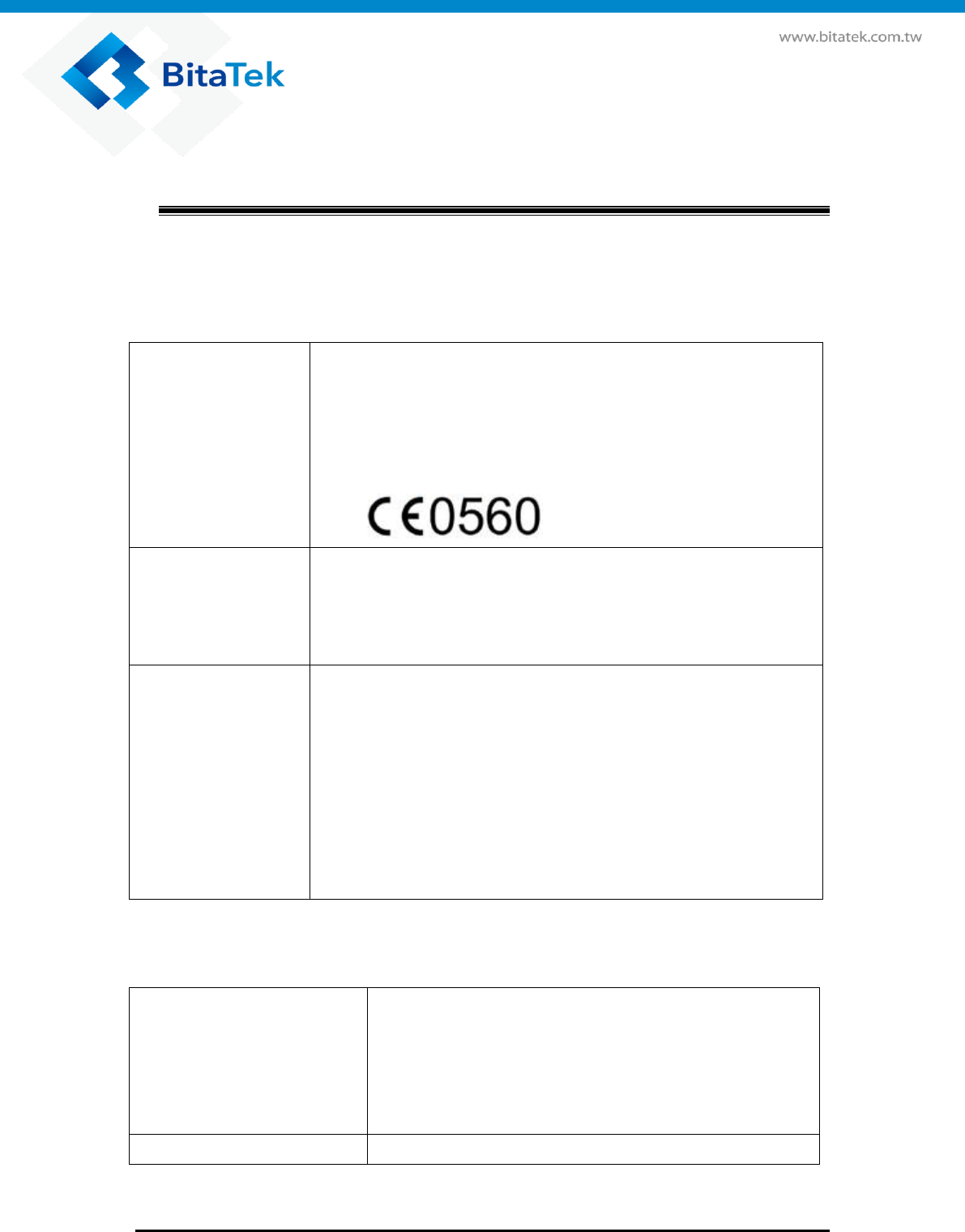
Page 64
BitaTek Co., Ltd. Copyright protected. All rights reserved.
NO. 115 Wugong 3rd Rd., Tel +886 2 2298 8588
Wugu Dist., New Taipei City 248, Taiwan (R.O.C.) Fax+886 2 2290 0029
Charpt 6. Regulatory and Type Approval Information
It is the responsibility of the application manufacturer to ensure compliance of the final product with all
provisions of the applicable directives and standards as well as with the technical specifications provided
Directive
99/05/EC
Directive of the European Parliament and of the council of 9 March
1999 on radio equipment and telecommunications terminal
equipment and the
mutual recognition of their conformity (in short referred to as R&TTE
Directive 1999/5/EC). The product is labeled with the CE conformity
mark
2011/65/EC (RoHS 2)
Directive of the European Parliament and of the Council of 27
January 2003 (and revised on 8 June 2011) on the restriction of the
use of certain hazardous substances in electrical and electronic
equipment (RoHS)
REACH
REACH is a regulation of the European Union, adopted to improve
the protection of human health and the environment from the risks
that can be posed by chemicals, while enhancing the
competitiveness of the EU chemicals industry. It also promotes
alternative methods for the hazard assessment of substances in
order to reduce the number of tests on animals. REACH stands for
Registration, Evaluation, Authorisation and Restriction of Chemicals.
It entered into force on 1 June 2007
Standards of European type approval
EN300328 V1.9.1
EN300 328 V1.9.1: 2015
Electromagnetic compatibility and Radio spectrum Matters
(ERM); Wideband transmission systems; Data transmission
equipment operating in the 2.4GHz ISM band and using wide
band modulation techniques; Harmonized EN covering the
essential requirements of article 3.2 of R&TTE Directive.
EN301893 V1.8.1
Broadband Radio Access Networks (BRAN); 5GHz high

Page 65
BitaTek Co., Ltd. Copyright protected. All rights reserved.
NO. 115 Wugong 3rd Rd., Tel +886 2 2298 8588
Wugu Dist., New Taipei City 248, Taiwan (R.O.C.) Fax+886 2 2290 0029
EN301 893 V1.8.1: 2015
performance RLAN; Harmonized EN covering the essential
requirements of article 3.2 of the R&TTE Directive.
DFS
EN301893 V1.8.1
EN301 893 V1.8.1: 2015
The advantage of 802.11a wireless market and the
constant push to open up spectrum for unlicensed use
created a requirement for Dynamic Frequency Selection
(DFS), a mechanism to use the 5GHz frequency bands
already allocated to radar systems without causing
interference to those radars.
EN300 440-1 v1.6.1:2010
EN300 440-2 v1.4.1:2010
Electromagnetic compatibility and Radio spectrum Matters
(ERM); Short range devices; Radio equipment to be used in
the 1GHz to 40GHz frequency range
EN 301 489–1 v1.9.2 : 2011,
EN 301 489–3 v1.6.1 : 2013
EN 301 489–17 v2.2.1 : 2012
Electromagnetic compatibility and Radio spectrum Matters
(ERM); ElectroMagnetic Compatibility (EMC) standard for
radio equipment and services
EN 55022 : 2010+AC:2011
EN 61000-4-2 : 2009,
EN 61000-4-3 :
2006+A1:2008+A2:2010
EN 55022 : 2010+AC:2011
EN 55024 : 2010,
IEC 61000-4-2 : 2008
IEC 61000-4-3 :
2006+A1:2007+A2:2010
IEC 61000-4-8 : 2009
The modified derivative of CISPR 22 and applies to, as the
name implies, information technology equipment (ITE).
EN 62311: 2008
Assessment of electronic and electrical equipment
related to human exposure restrictions for
electromagnetic fields (0Hz -300GHz)
Standard of FCC Regulatory Approval
FCC 15C
Frequency hopping and digitally modulated system
FCC15E
RADIO FREQUENCY DEVICES -Unlicensed National
Information Infrastructure Devices
Compliance measurement procedures for unlicensed

Page 66
BitaTek Co., Ltd. Copyright protected. All rights reserved.
NO. 115 Wugong 3rd Rd., Tel +886 2 2298 8588
Wugu Dist., New Taipei City 248, Taiwan (R.O.C.) Fax+886 2 2290 0029
DFS
material information infrastructure device operating in the
5.25Ghz ~5.35GHz and 5.47GHz~5.725GHz Bands
incorporating dynamic frequency selection
Part 15B
Radio Frequency Devices
OET65 (SAR)
operations or devices comply with limits for human
exposure to radiofrequency (RF) fields adopted by the
Federal Communications
BQB Certificate:
BQB
complies with all the Bluetooth SIG requirements
WiFi Alliance:
WiFi Logo
WiFi Alliance approval
Note: SAR requirements specific to portable mobiles
This requires the Specific Absorption Rate (SAR) of portable Frey M1 applications to be
evaluated and approved for compliance with national and/or international regulations.
Since the SAR value varies significantly with the individual product design manufacturers
are advised to submit their product for approval if designed for portable use. For European
markets the relevant directives are mentioned below. It is the responsibility of the
manufacturer of the final product to verify whether or not further standards,
recommendations or directives are in force outside these areas.
6.1. Safety Precautions
The following safety precautions must be observed during all phases of the operation,
usage, service or repair of any cellular terminal or mobile incorporating Frey M1
Manufacturers of the cellular terminal are advised to convey the following safety information
to users and operating personnel and to incorporate these guidelines into all manuals
supplied with the product. Failure to comply with these precautions violates safety
standards of design, manufacture and intended use of the product.
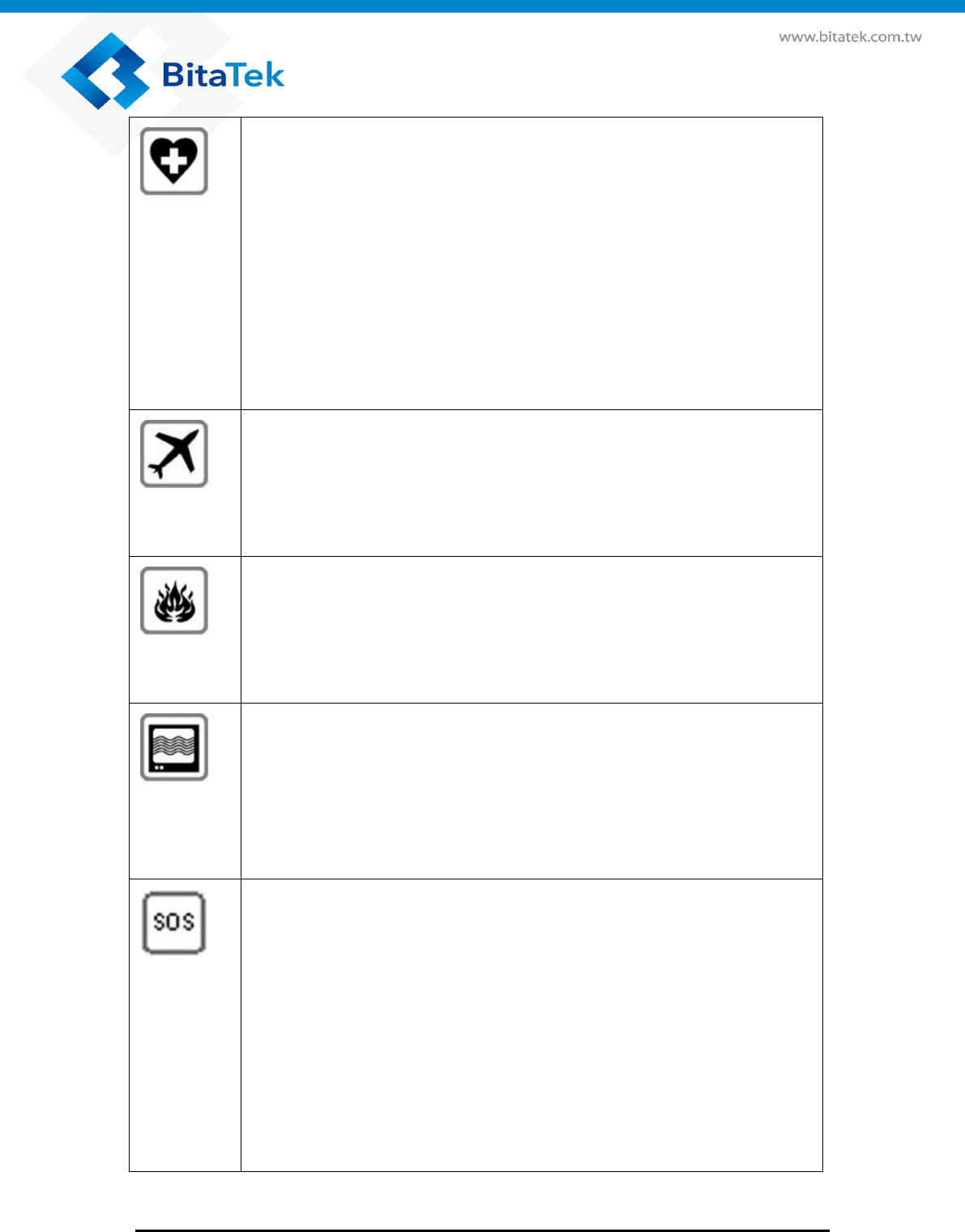
Page 67
BitaTek Co., Ltd. Copyright protected. All rights reserved.
NO. 115 Wugong 3rd Rd., Tel +886 2 2298 8588
Wugu Dist., New Taipei City 248, Taiwan (R.O.C.) Fax+886 2 2290 0029
When in a hospital or other health care facility, observe the restrictions on the
use of mobiles. Switch the cellular terminal or mobile off, if instructed to do so
by the guidelines posted in sensitive areas. Medical equipment may be
sensitive to RF energy.
The operation of cardiac pacemakers, other implanted medical equipment and
hearing aids can be affected by interference from cellular terminals or mobiles
placed close to the device. If in doubt about potential danger, contact the
physician or the manufacturer of the device to verify that the equipment is
properly shielded. Pacemaker patients are advised to keep their hand-held
mobile away from the pacemaker, while it is on.
Switch off the cellular terminal or mobile before boarding an aircraft. Make sure
it cannot be switched on inadvertently. The operation of wireless appliances in
an aircraft is forbidden to prevent interference with communications systems.
Failure to observe these instructions may lead to the suspension or denial of
cellular services to the offender, legal action, or both.
Do not operate the cellular terminal or mobile in the presence of flammable
gases or fumes. Switch off the cellular terminal when you are near petrol
stations, fuel depots, chemical plants or where blasting operations are in
progress. Operation of any electrical equipment in potentially explosive
atmospheres can constitute a safety hazard.
Your cellular terminal or mobile receives and transmits radio frequency energy
while switched on. Remember that interference can occur if it is used close to
TV sets, radios, computers or inadequately shielded equipment. Follow any
special regulations and always switch off the cellular terminal or mobile
wherever forbidden, or when you suspect that it may cause interference or
danger.
IMPORTANT!
Cellular terminals or mobiles operate using radio signals and cellular networks.
Because of this, connection cannot be guaranteed at all times under all
conditions.
Therefore, you should never rely solely upon any wireless device for essential
communications, for example emergency calls.
Remember, in order to make or receive calls, the cellular terminal or mobile
must be switched on and in a service area with adequate cellular signal
strength.
Some networks do not allow for emergency calls if certain network services or

Page 68
BitaTek Co., Ltd. Copyright protected. All rights reserved.
NO. 115 Wugong 3rd Rd., Tel +886 2 2298 8588
Wugu Dist., New Taipei City 248, Taiwan (R.O.C.) Fax+886 2 2290 0029
phone features are in use (e.g. lock functions, fixed dialing etc.). You may need
to deactivate those features before you can make an emergency call.
Some networks require that a valid SIM card be properly inserted in the cellular
terminal or mobile.
6.2. Safety
European Union notice
This device complies with the R&TTE Directive (1999/5/EC) issued by the Commission of
the European Community.
We declare under our sole responsibility that our product and in combination with our
accessories, to which this declaration relates is in conformity with the appropriate standards
EN 55022/24, EN 301 489-1-3-17, EN62311, EN 300 328, EN301 893, EN300 440
following the provisions of, radio equipment and telecommunication terminal equipment
directive 1999/5/EC.
Federal Communications Commission (FCC) Statements
This device complies with part 15 of the FCC Rules. Operation is subject to the following two
conditions: (1) this device may not cause harmful interference, and (2) this device must
accept any interference received, including any interference that may cause undesired
operation of the device.
This equipment has been tested and found to comply with the limits for a Class B digital
device, pursuant to part 15 of the FCC rules. These limits are designed to provide
reasonable protection
against harmful interference in a residential installation. This equipment generates, uses
and can radiate radio frequency energy and, if not installed and used in accordance with the
instructions, may cause harmful interference to radio communications. However, there is no
guarantee that interference will not occur in a particular installation.
If this equipment does cause harmful interference to radio or television reception, which can
be determined by turning the equipment off and on, the user is encouraged to try to correct
the interference by one or more of the following measures:
- Reorient or relocate the receiving antenna.
- Increase the separation between the equipment and receiver.
- Connect the equipment into an outlet on a circuit different from that to which the
receiver is connected.
- Consult the dealer or an experienced radio/TV technician for help.

Page 69
BitaTek Co., Ltd. Copyright protected. All rights reserved.
NO. 115 Wugong 3rd Rd., Tel +886 2 2298 8588
Wugu Dist., New Taipei City 248, Taiwan (R.O.C.) Fax+886 2 2290 0029
FCC Warning:
The FCC requires that you be notified that any changes or modifications to this device not
expressly approved by the manufacturer could void the user’s authority to operate the
equipment.
RF Radiation Exposure Statement:
This equipment complies with FCC RF radiation exposure limits set forth for an uncontrolled
environment. This equipment should be installed and operated with a minimum distance of
20 centimeters between the radiator and your body.
This Transmitter must not be co-located or operating in conjunction with any other antenna
or transmitter.
Regulatory Module Integration Instructions
Only those antennas with same type and lesser gain filed under this FCC ID number can be
used with this device.
The final system integrator must ensure there is no instruction provided in the user manual
or customer documentation indicating how to install or remove the transmitter module.
Required end product labeling:
Any device incorporating this module must include an external, visible, permanent marking
or label which states: “Contains FCC ID: SPYIM0002”
The final host / module combination may also need to be evaluated against the FCC Part
15B criteria for unintentional radiators in order to be properly authorized for operation as a
Part 15 digital device.
If the final host / module combination is intended for use as a portable device (see
classifications below) the host manufacturer is responsible for separate approvals for the
SAR requirements from FCC Part 2.1093.
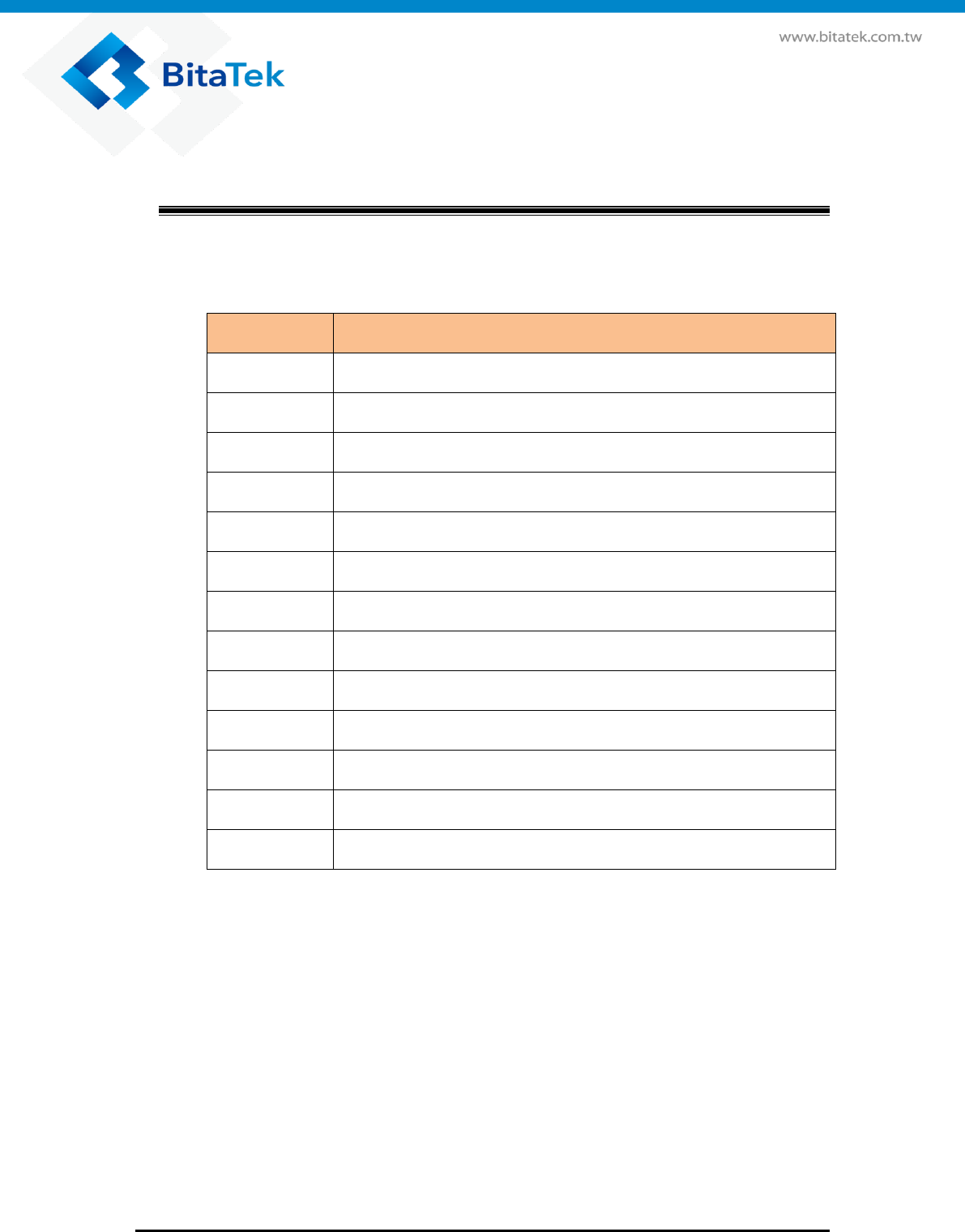
Page 70
BitaTek Co., Ltd. Copyright protected. All rights reserved.
NO. 115 Wugong 3rd Rd., Tel +886 2 2298 8588
Wugu Dist., New Taipei City 248, Taiwan (R.O.C.) Fax+886 2 2290 0029
Charpt 7. Appendix
7.1. Abbreviations
Abbreviation
Description
BGA
Ball Grid Array
BLR
Board Level Reliability
DCE
Data Communication Equipment
DTE
Data Terminal Equipment
ENIG
Electroless Nickel Immersion Gold
LGA
Land Grid Array
PCB
Printed Circuit Board
RF
Radio Frequency
SMD
Surface Mount Device
SMT
Surface Mount Technology
TC
Thermocouples
TP
Test Point
UART
Universal Asynchronous Receiver-Transmitter
7.2. Mounting Advice Sheet
To prevent mechanical damage, be careful not to force, bend or twist the module. Be sure
it is soldered flat against the host device. The advice sheet on the follow shows a number
of examples for the kind of bending that may lead to mechanical damage of the module
(the module as part of an external application is integrated into a housing).
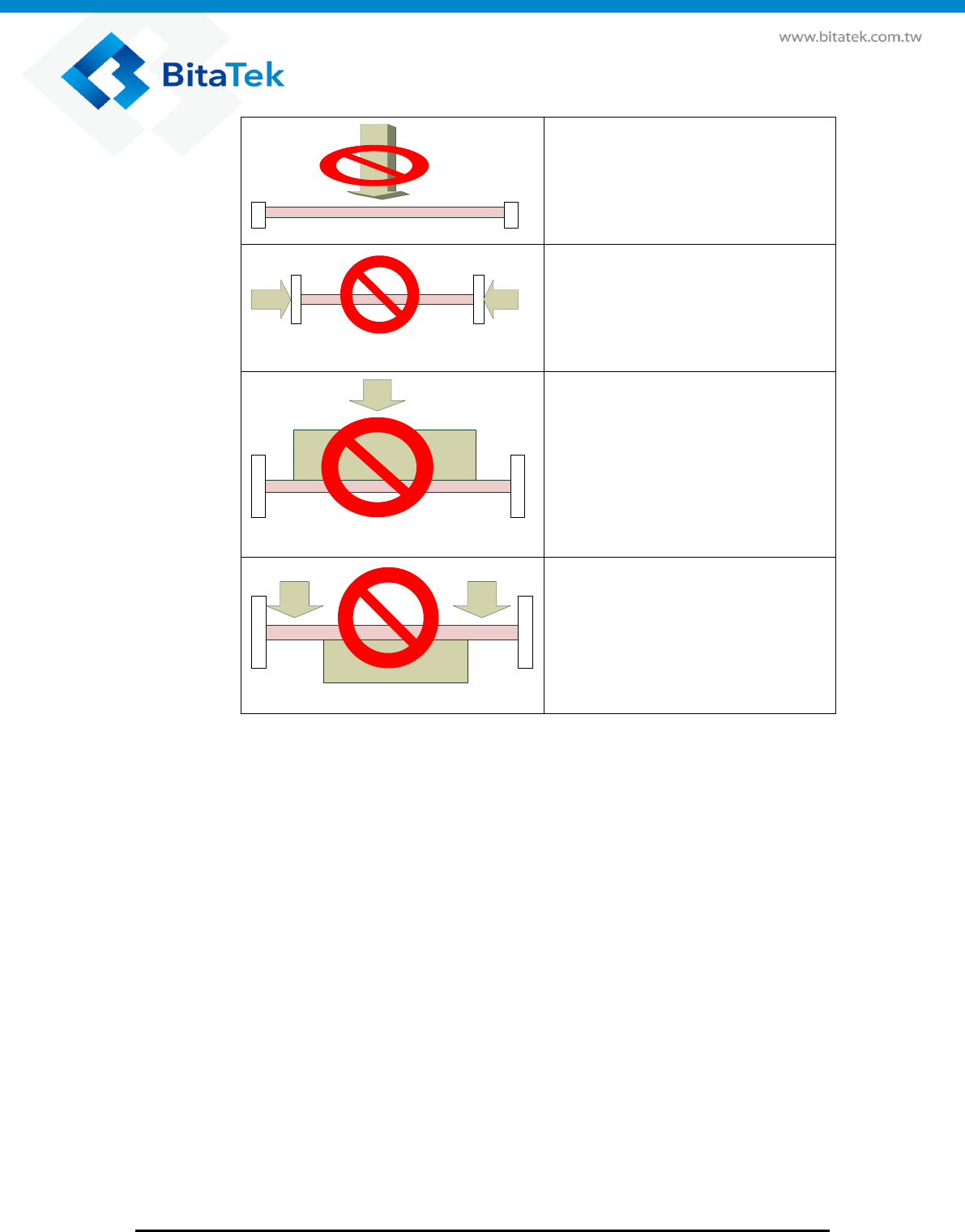
Page 71
BitaTek Co., Ltd. Copyright protected. All rights reserved.
NO. 115 Wugong 3rd Rd., Tel +886 2 2298 8588
Wugu Dist., New Taipei City 248, Taiwan (R.O.C.) Fax+886 2 2290 0029
By pressing from above
By mounting under pressure
By putting object on top
By putting objects below